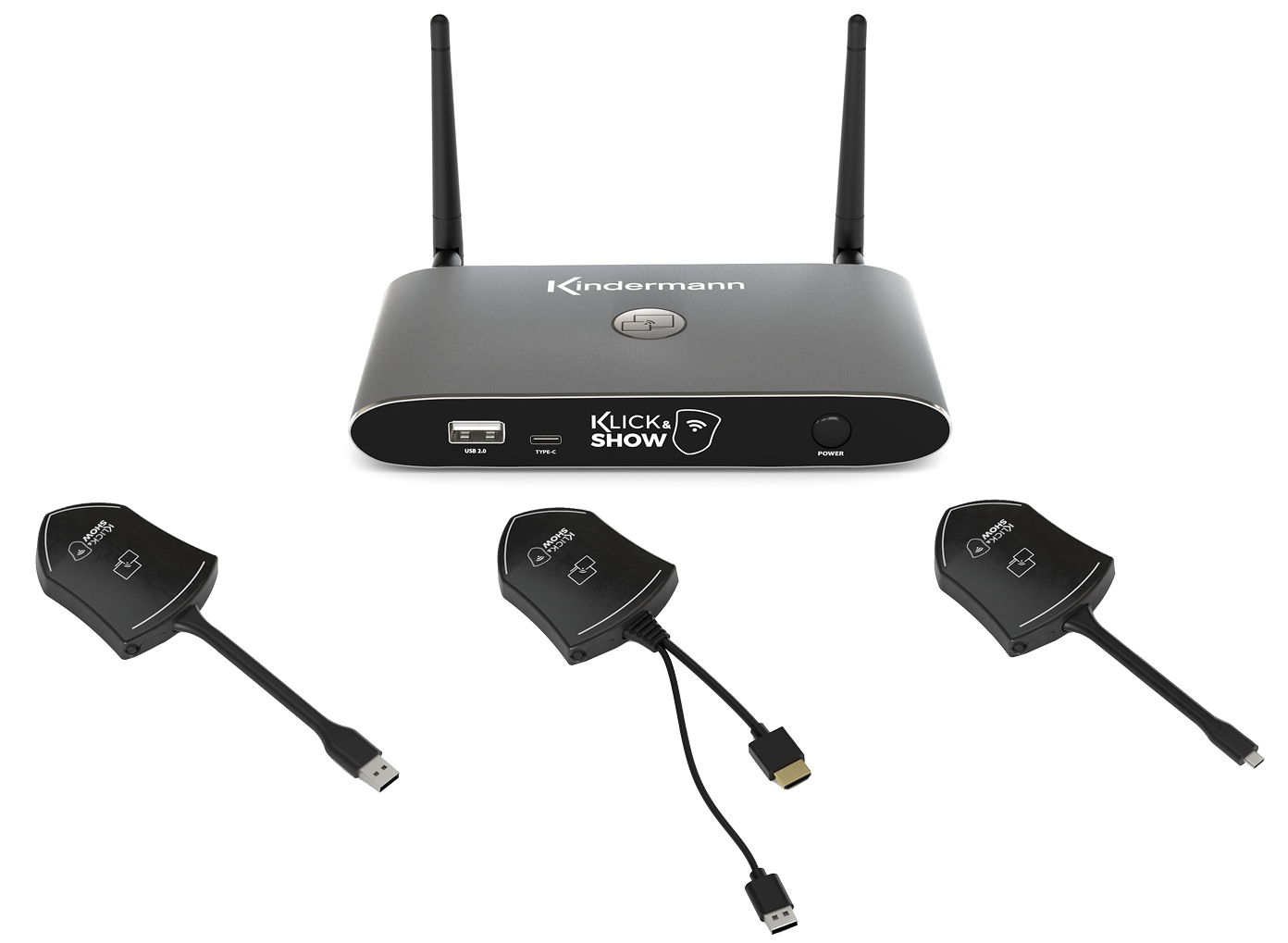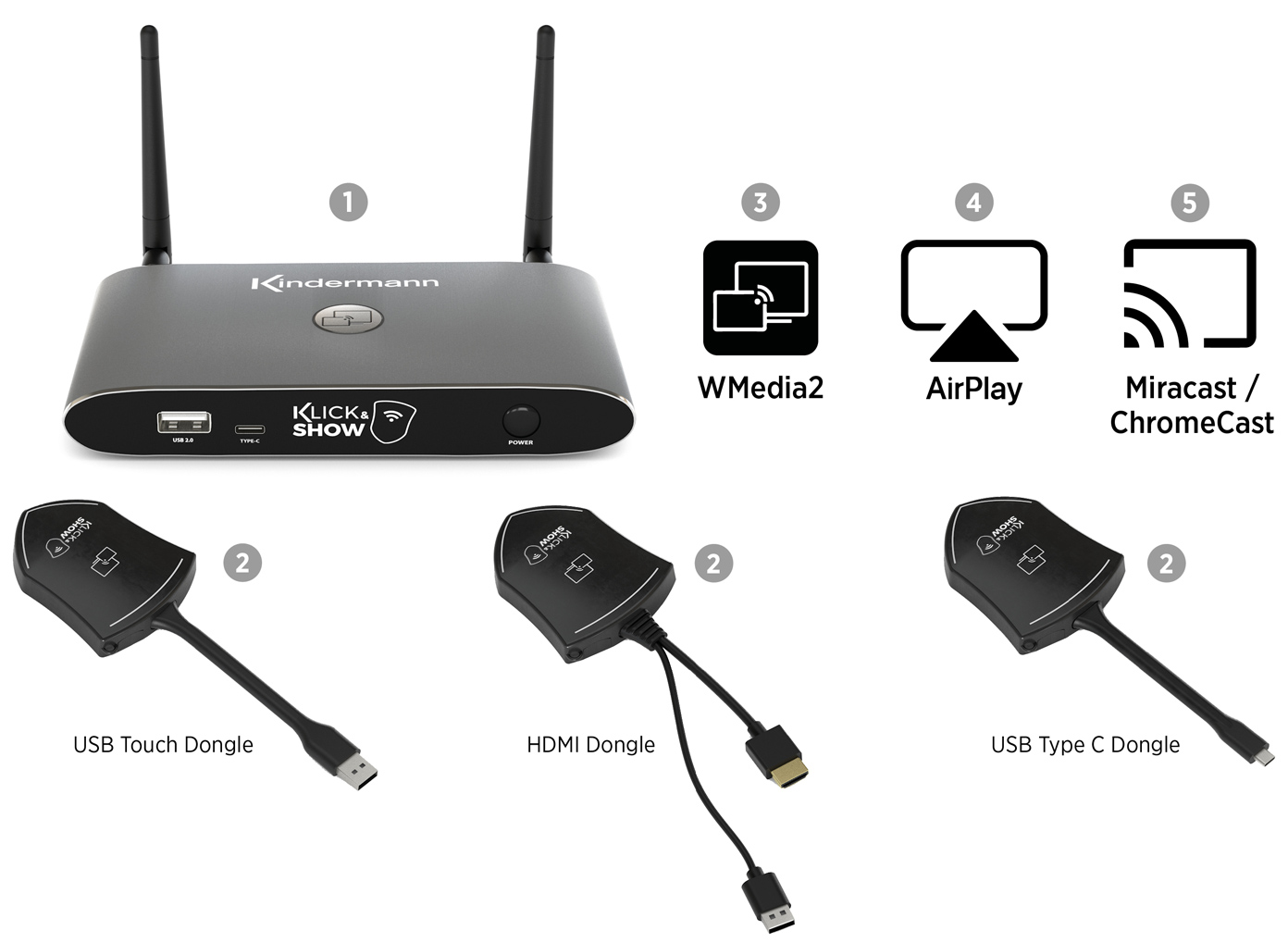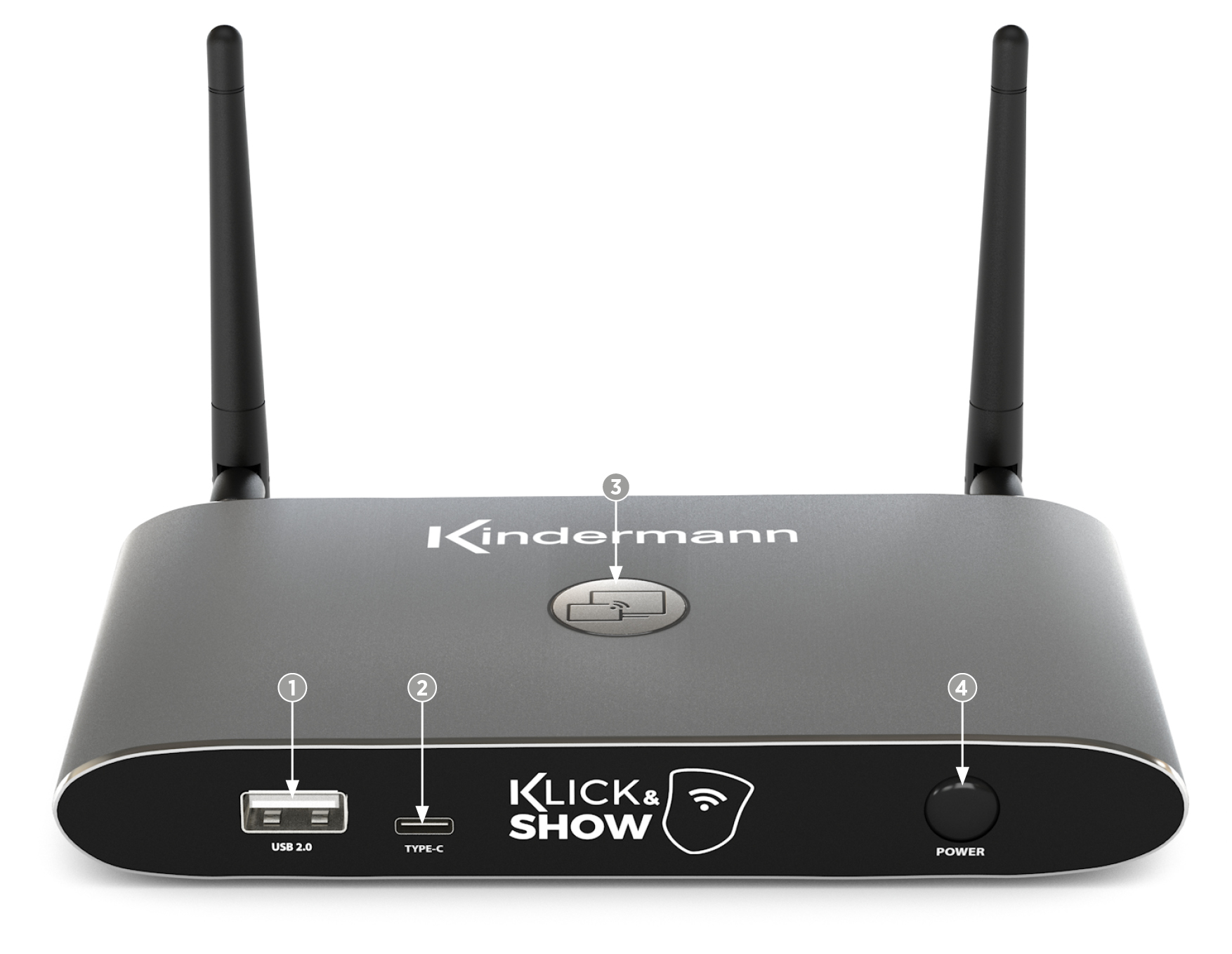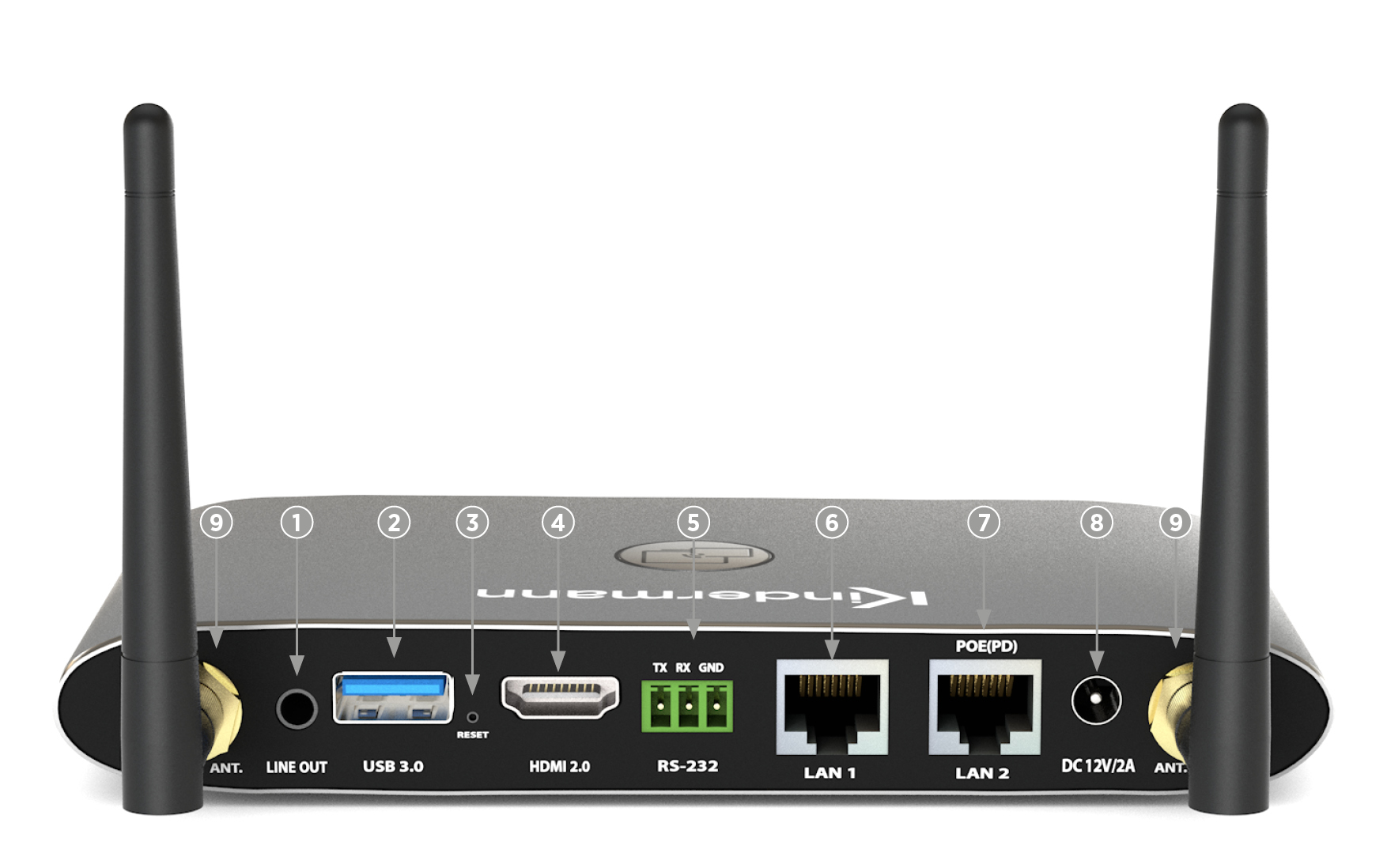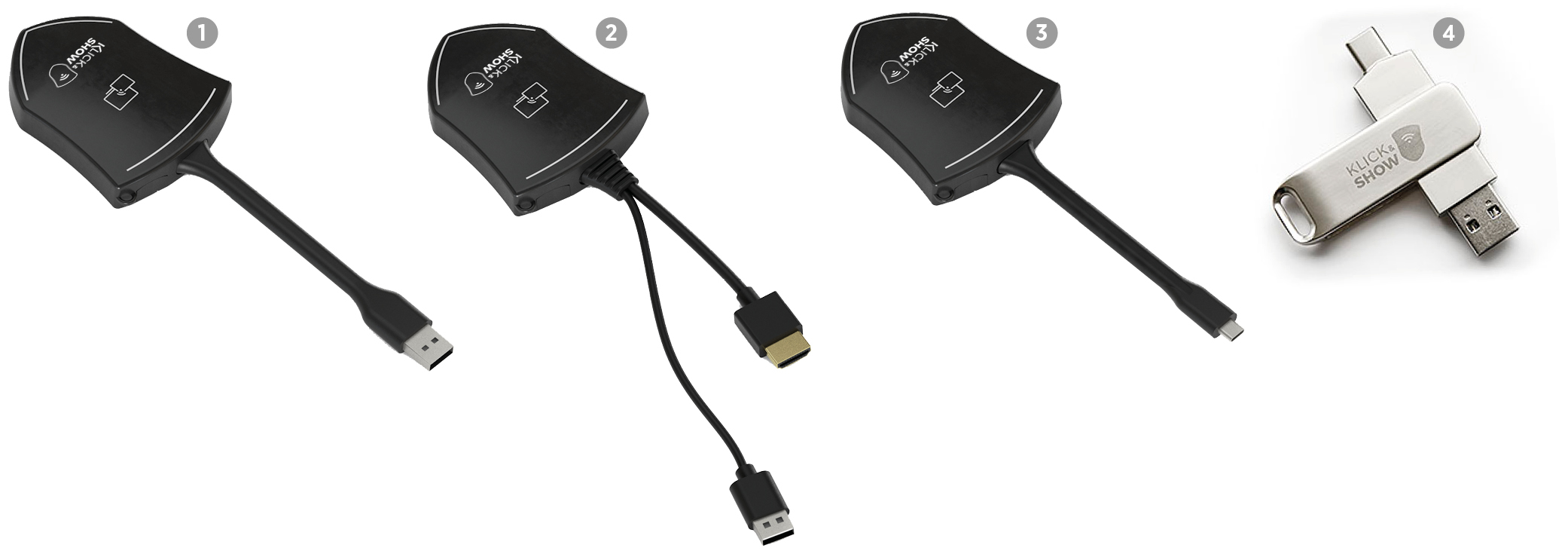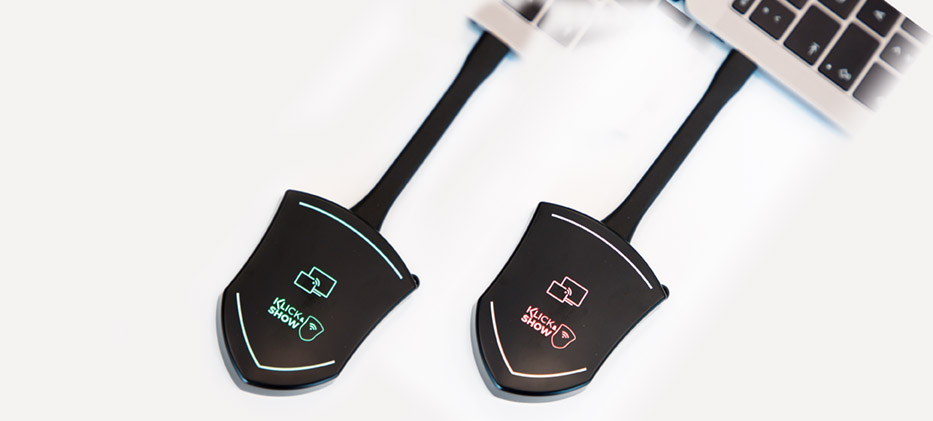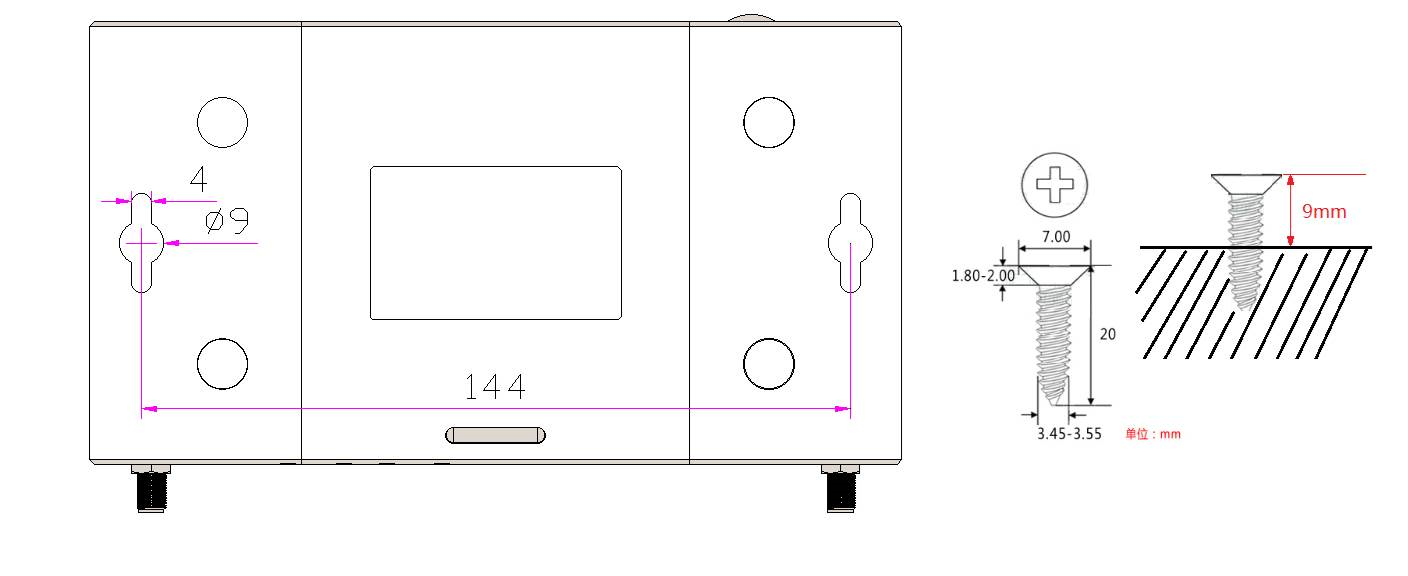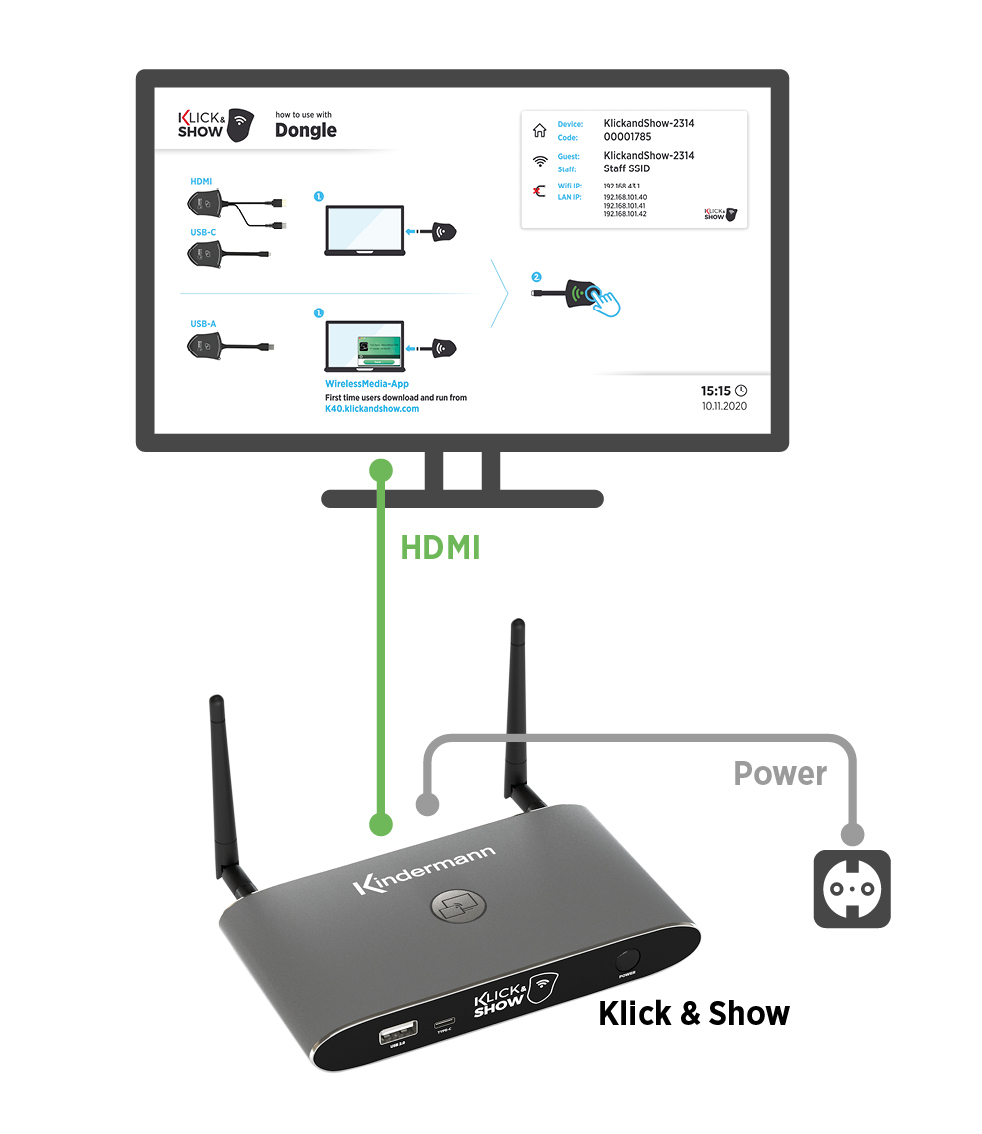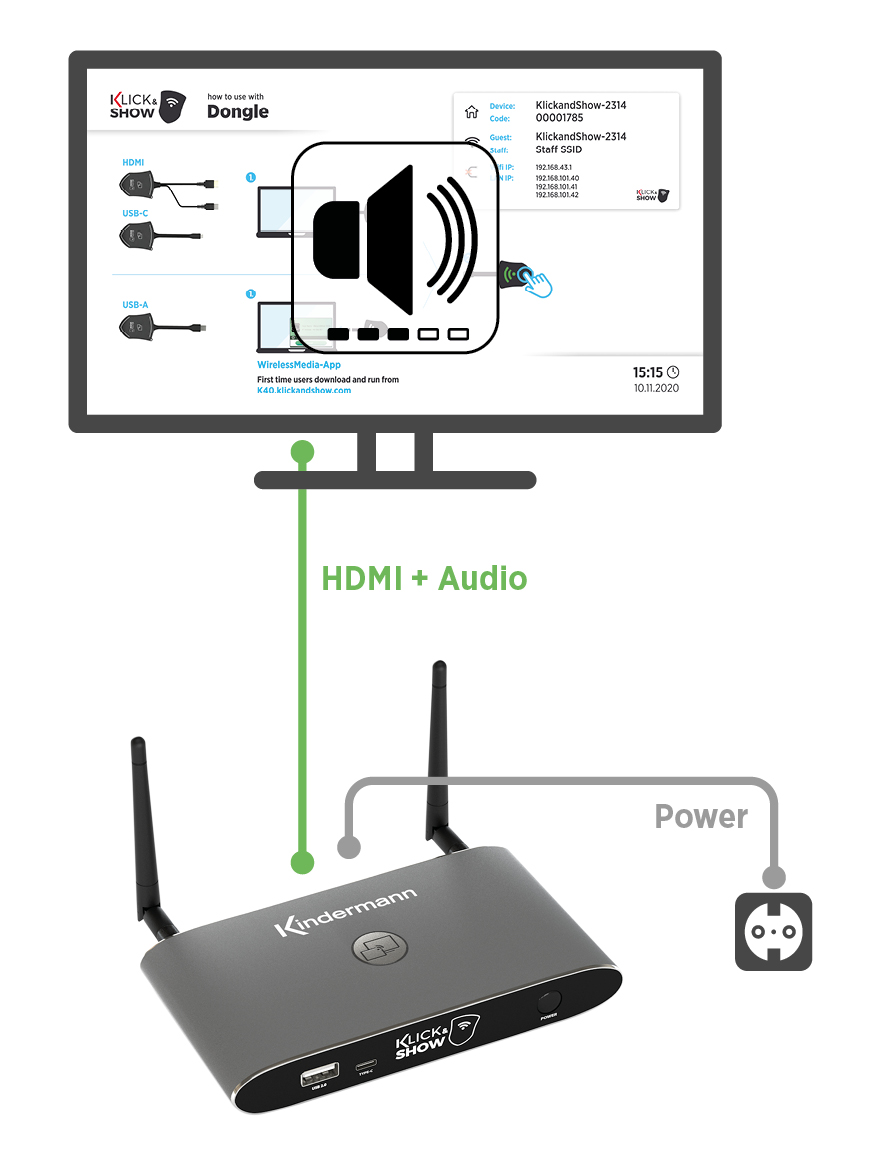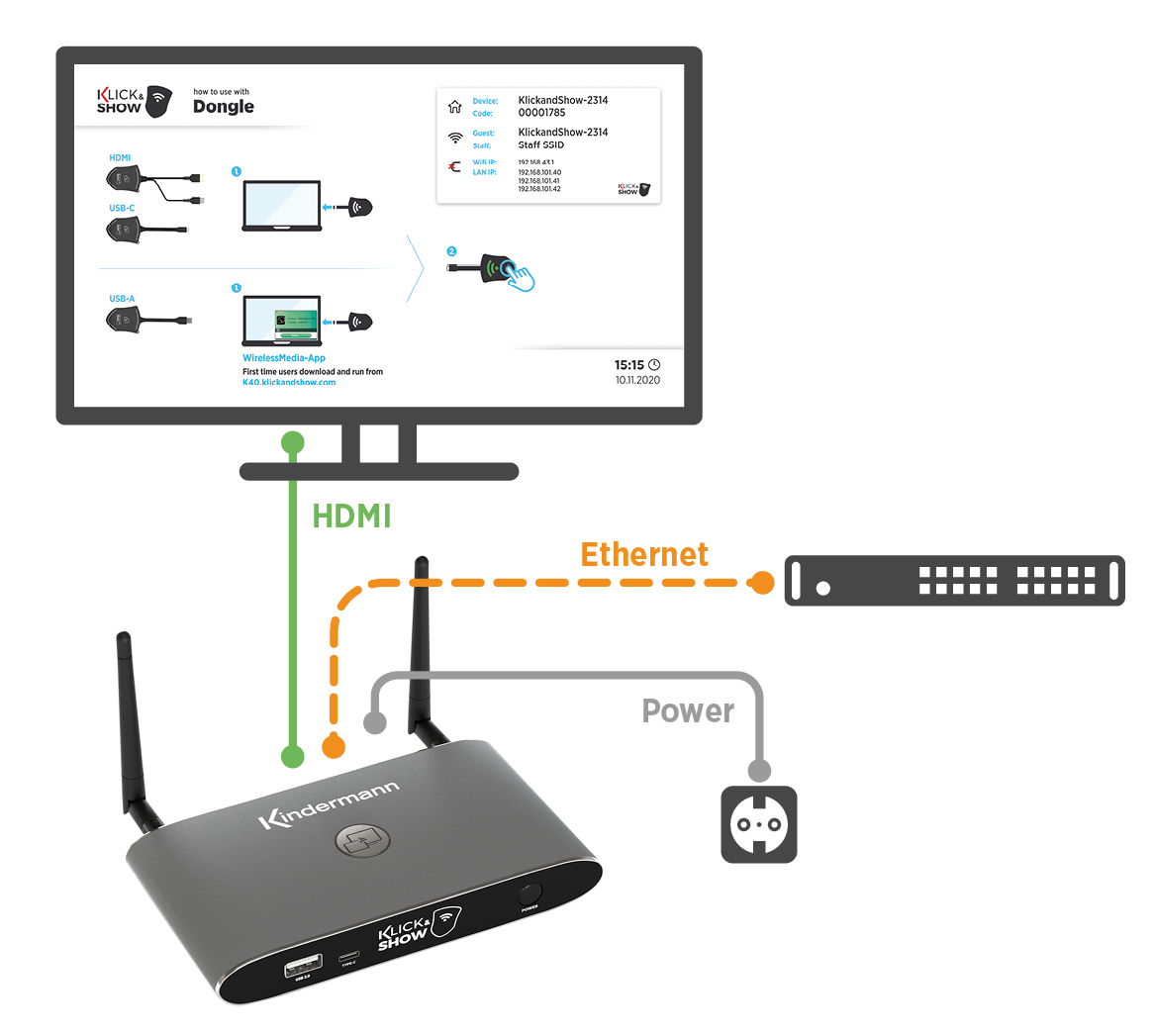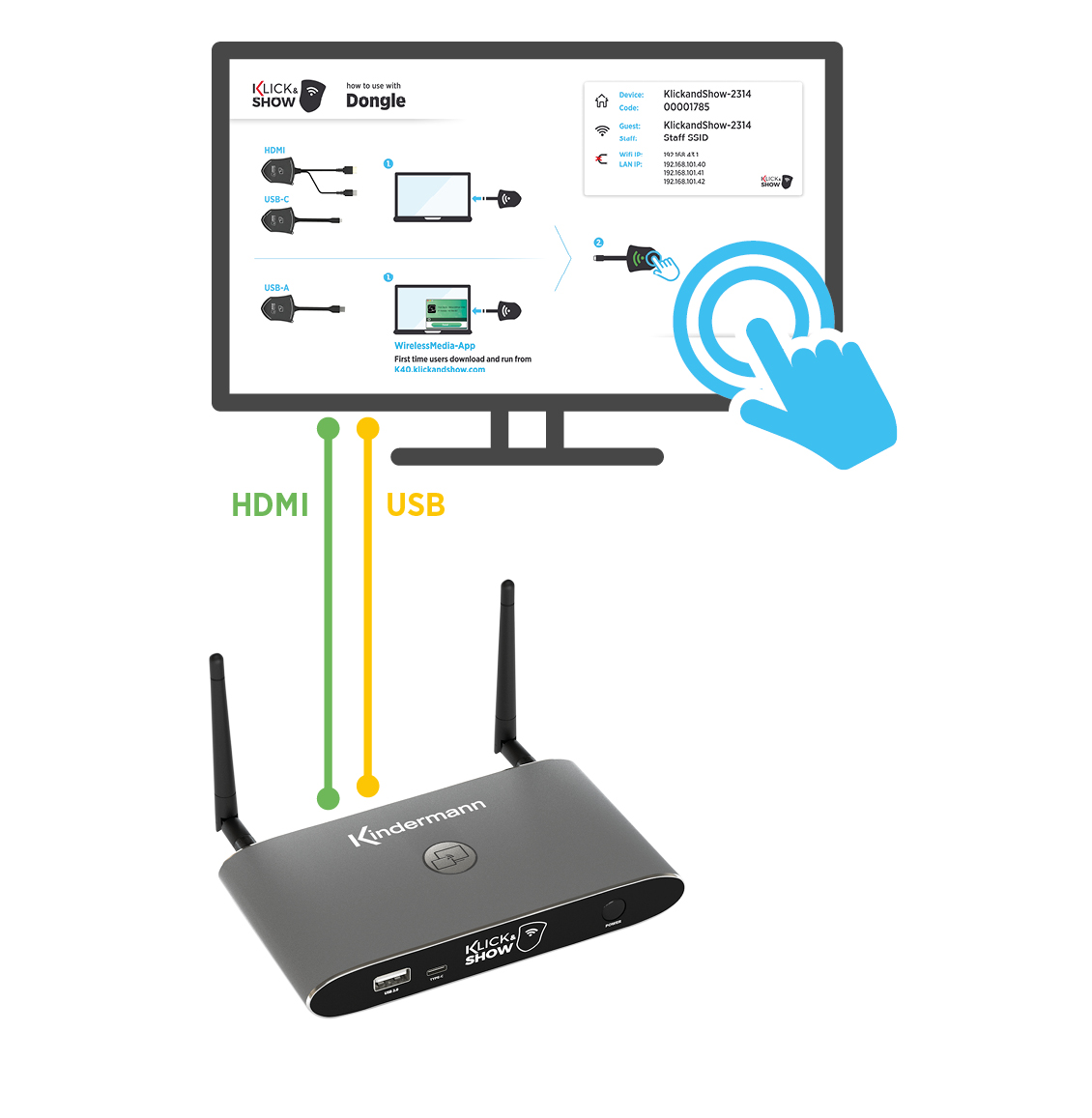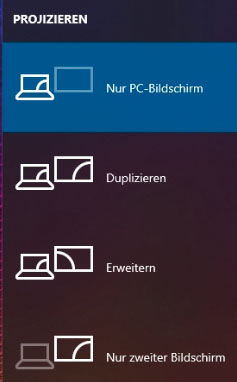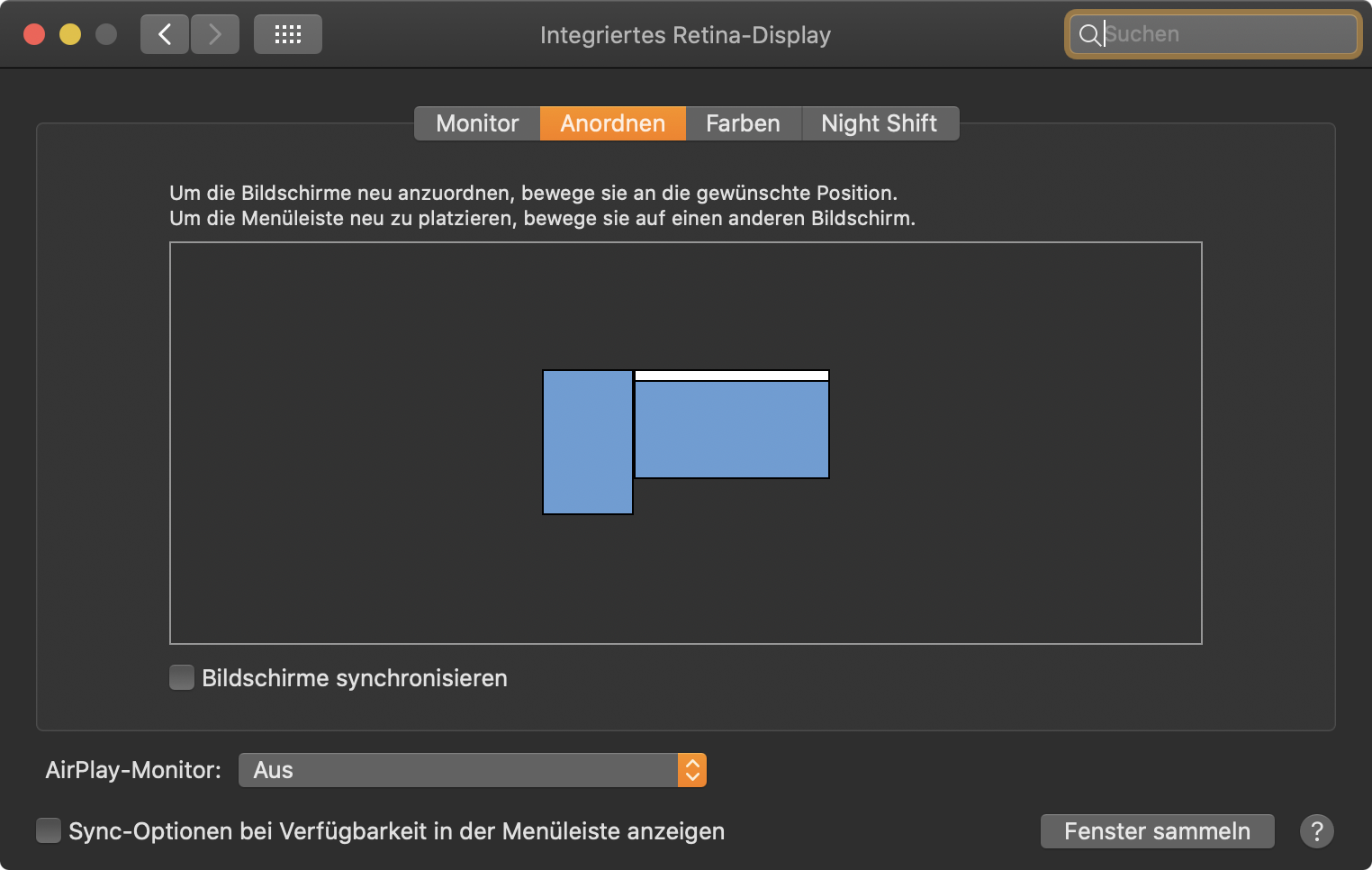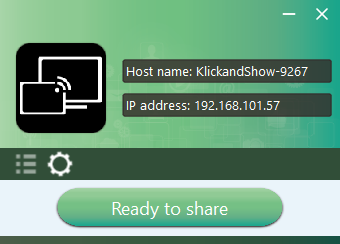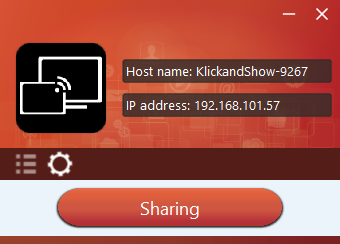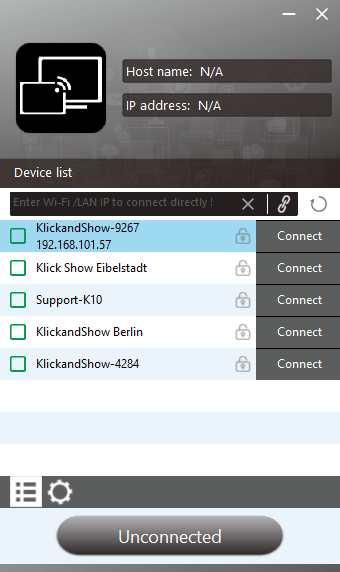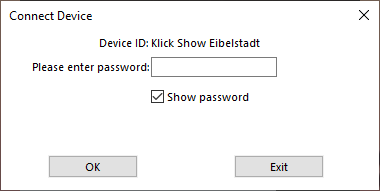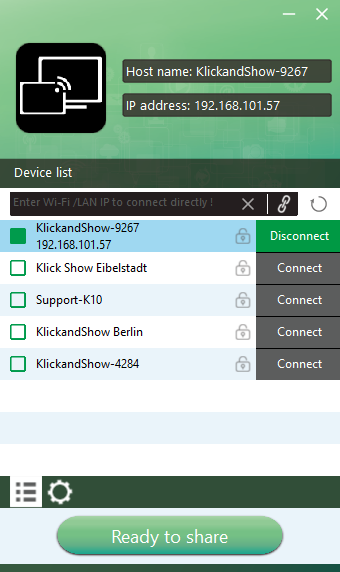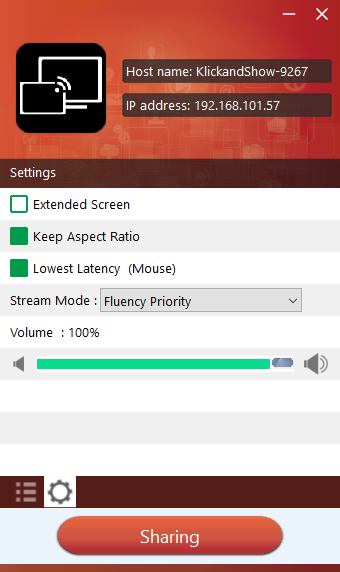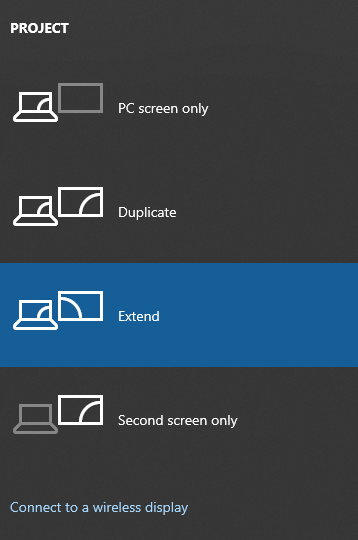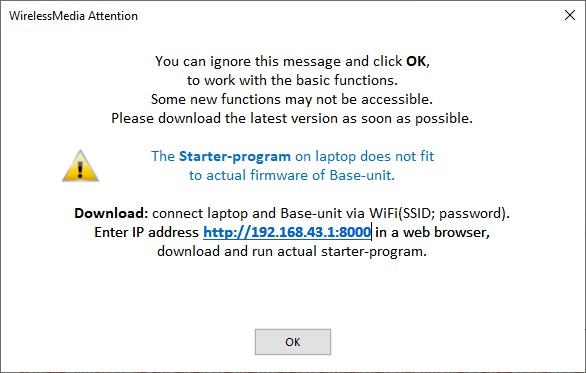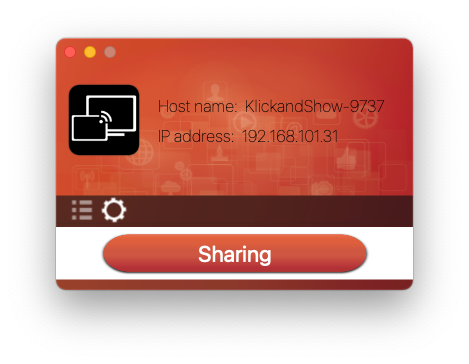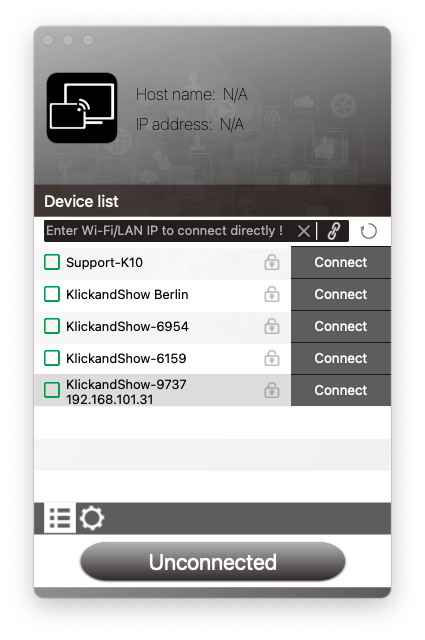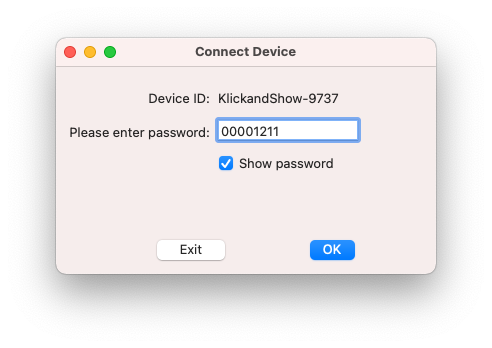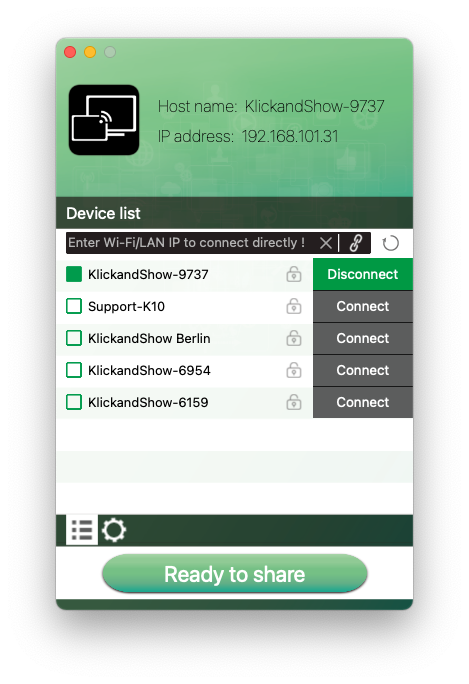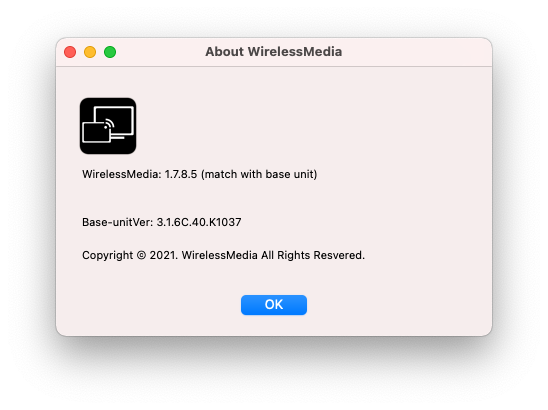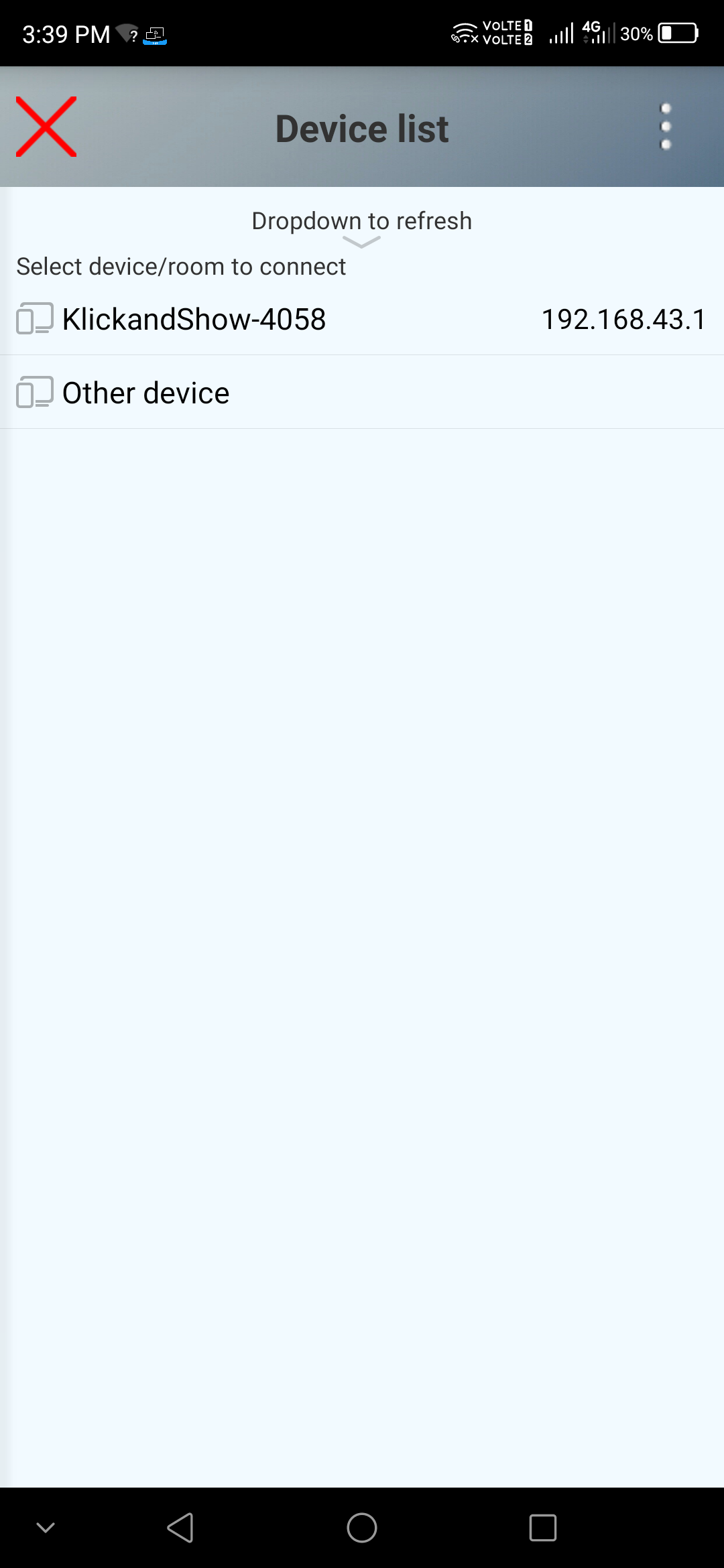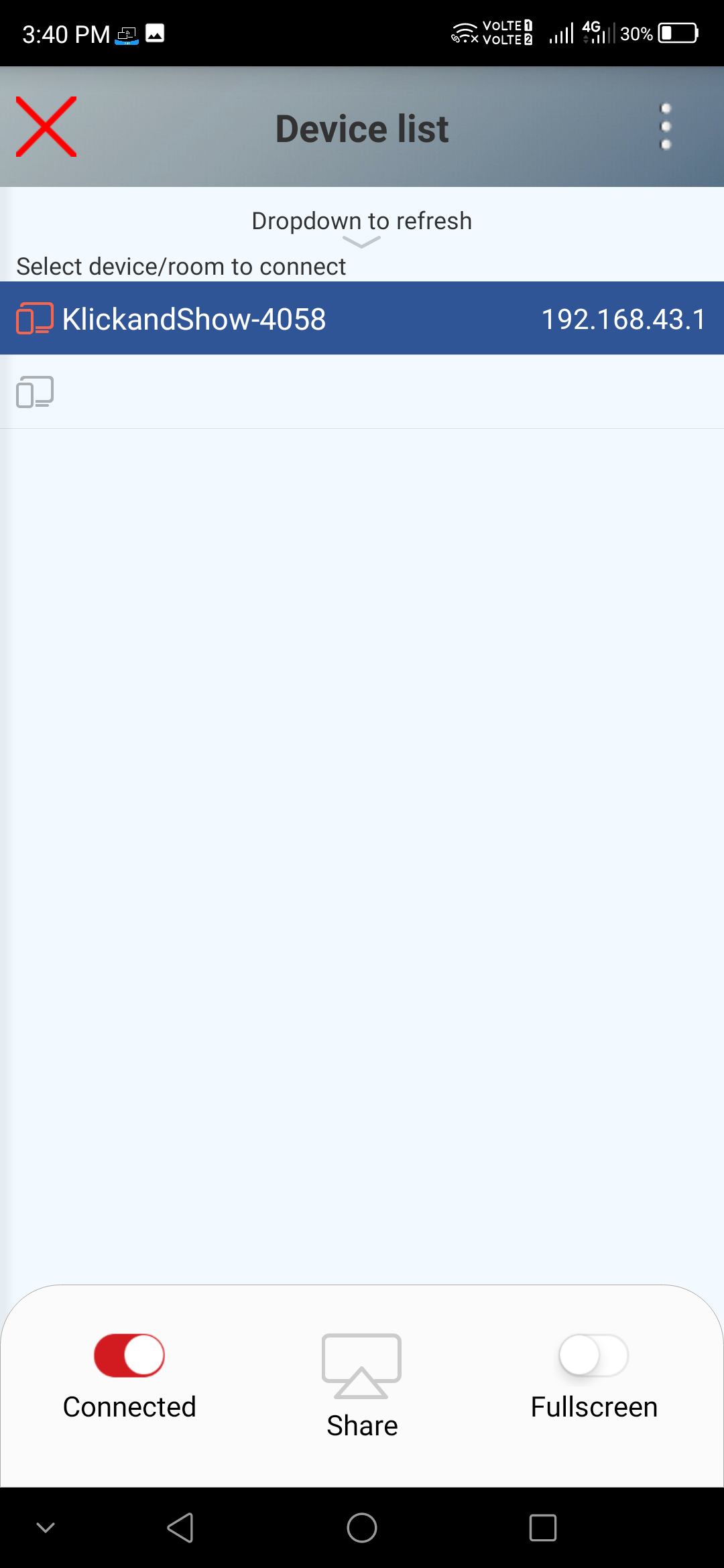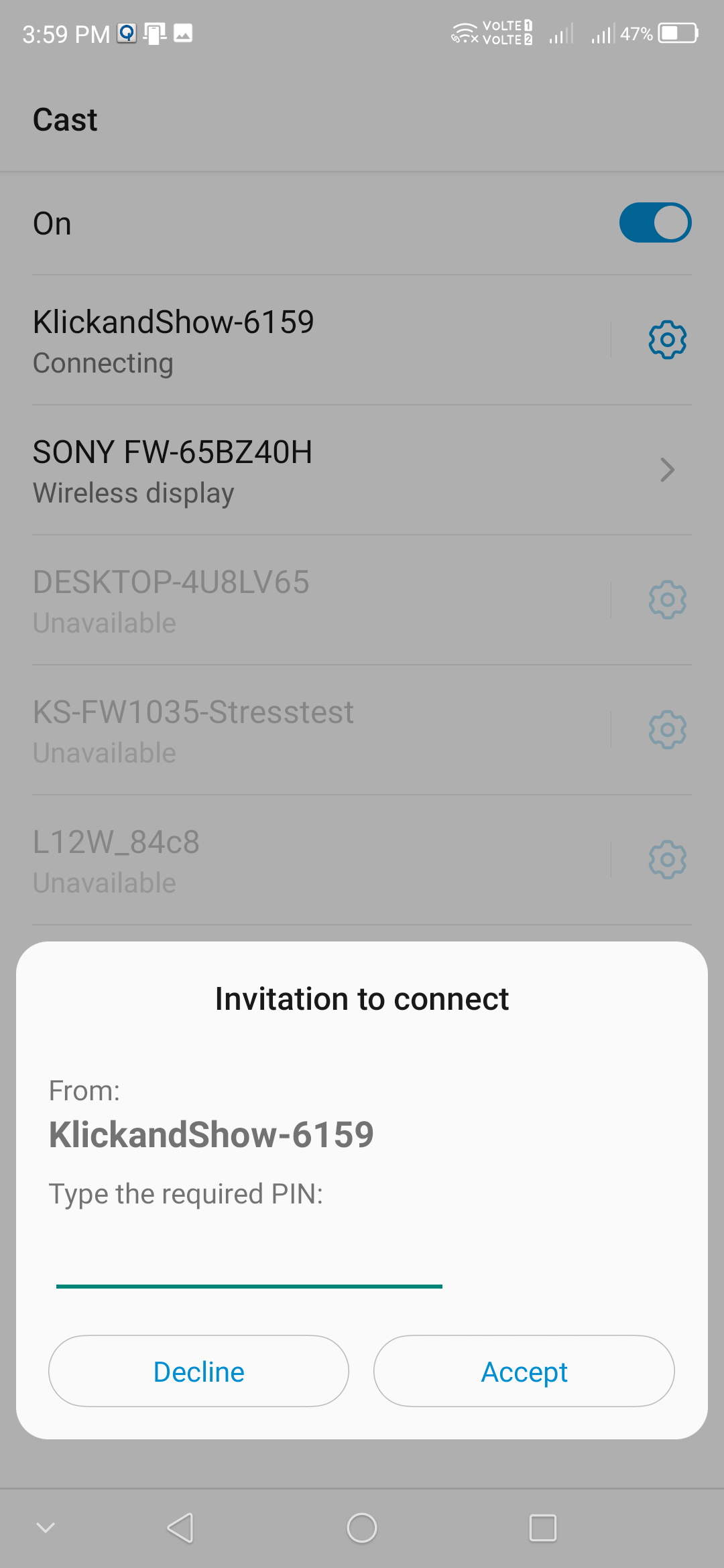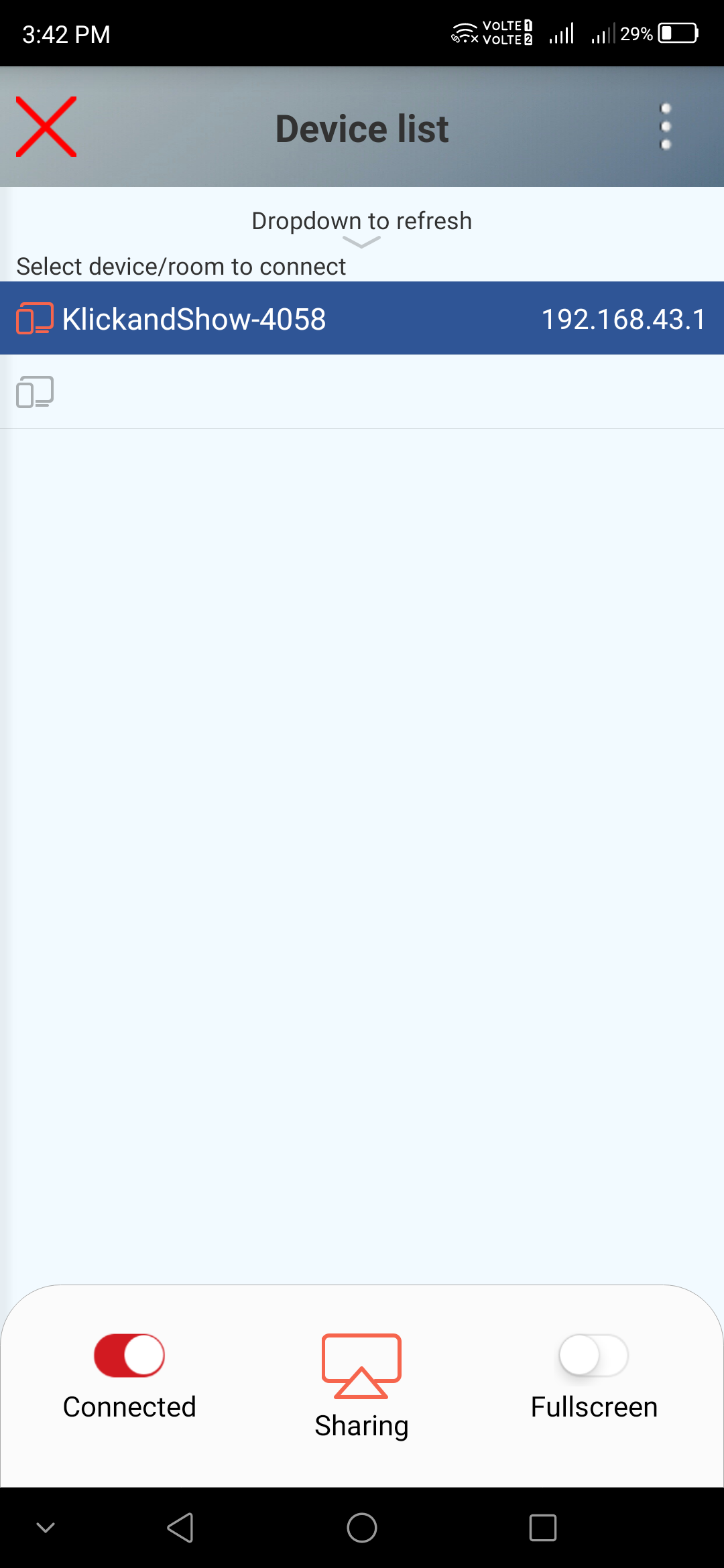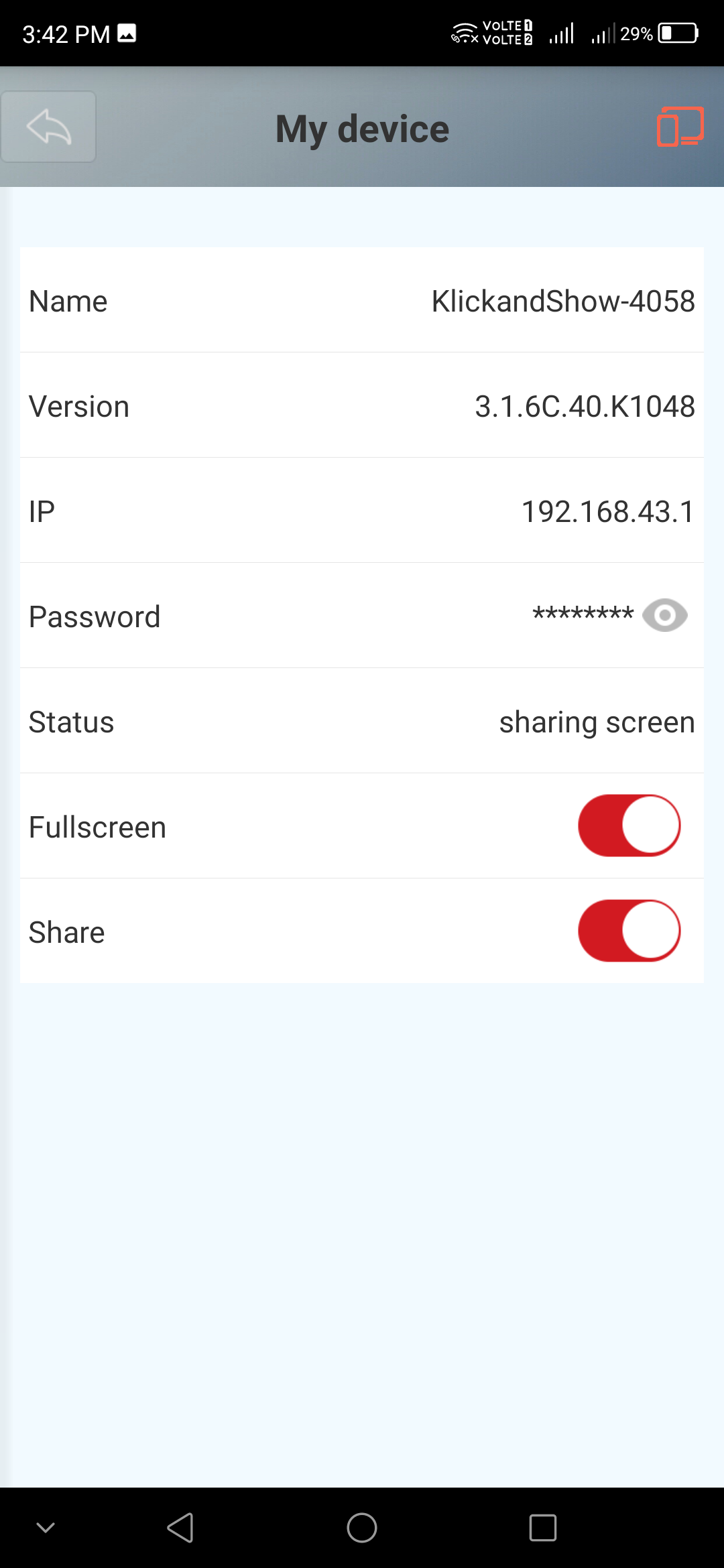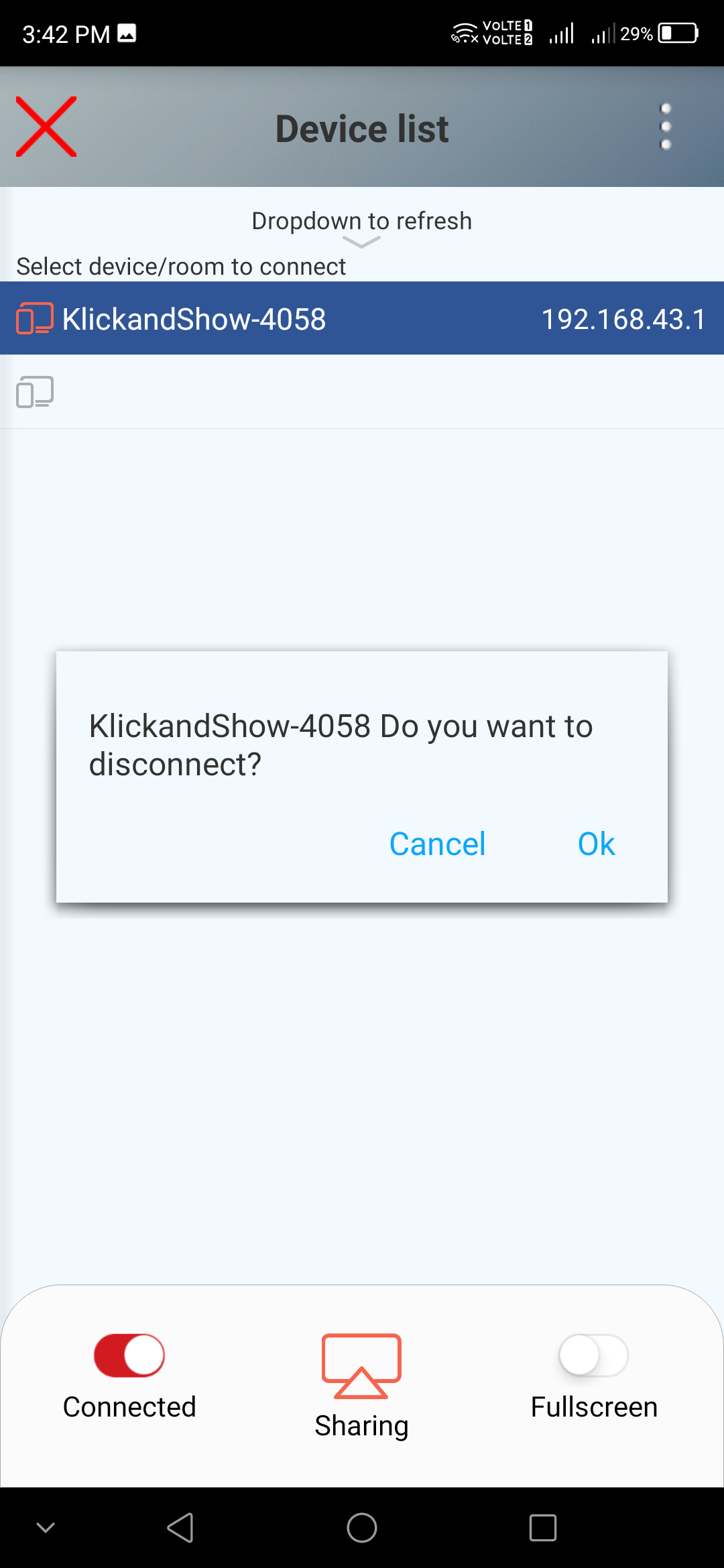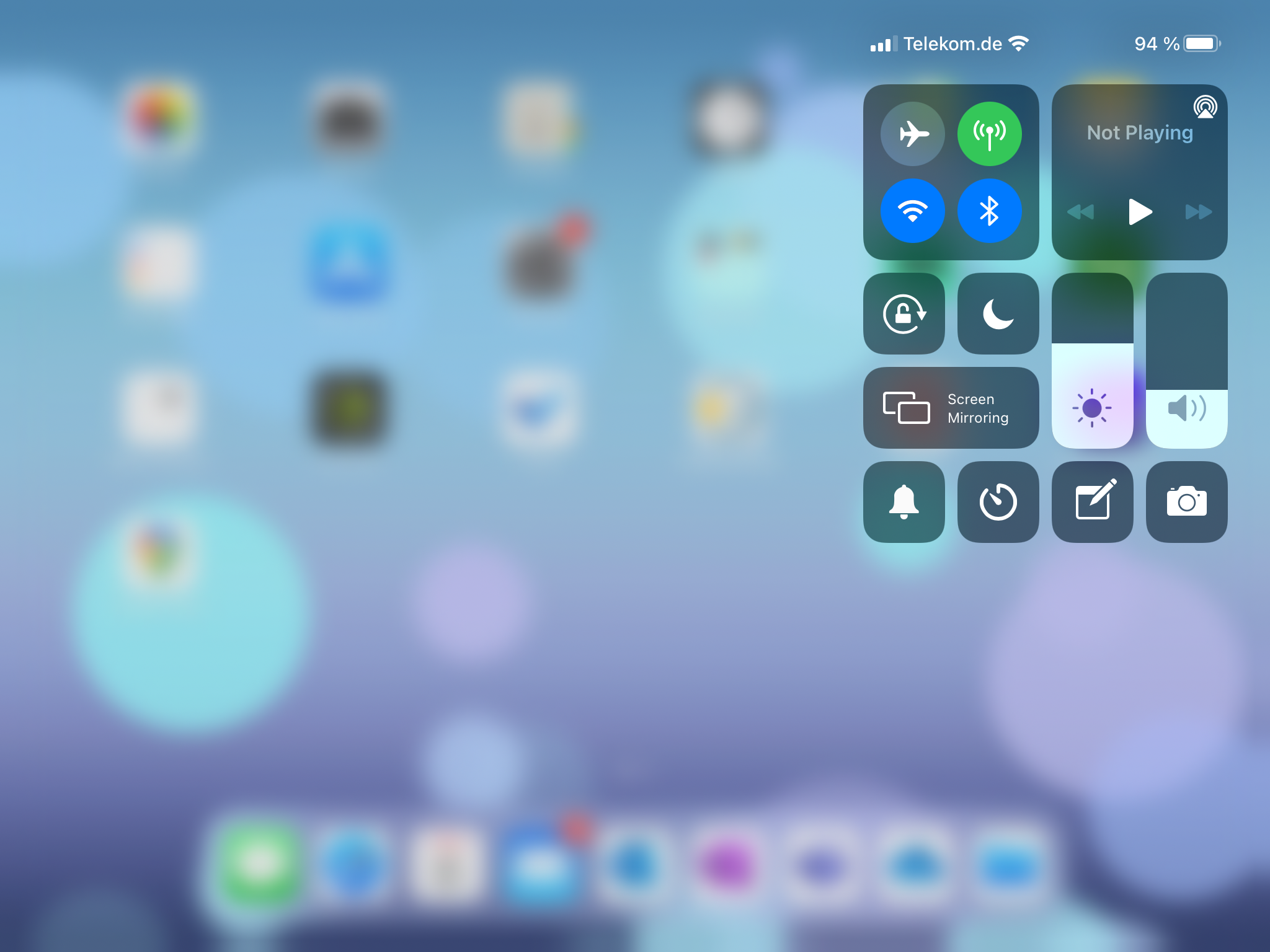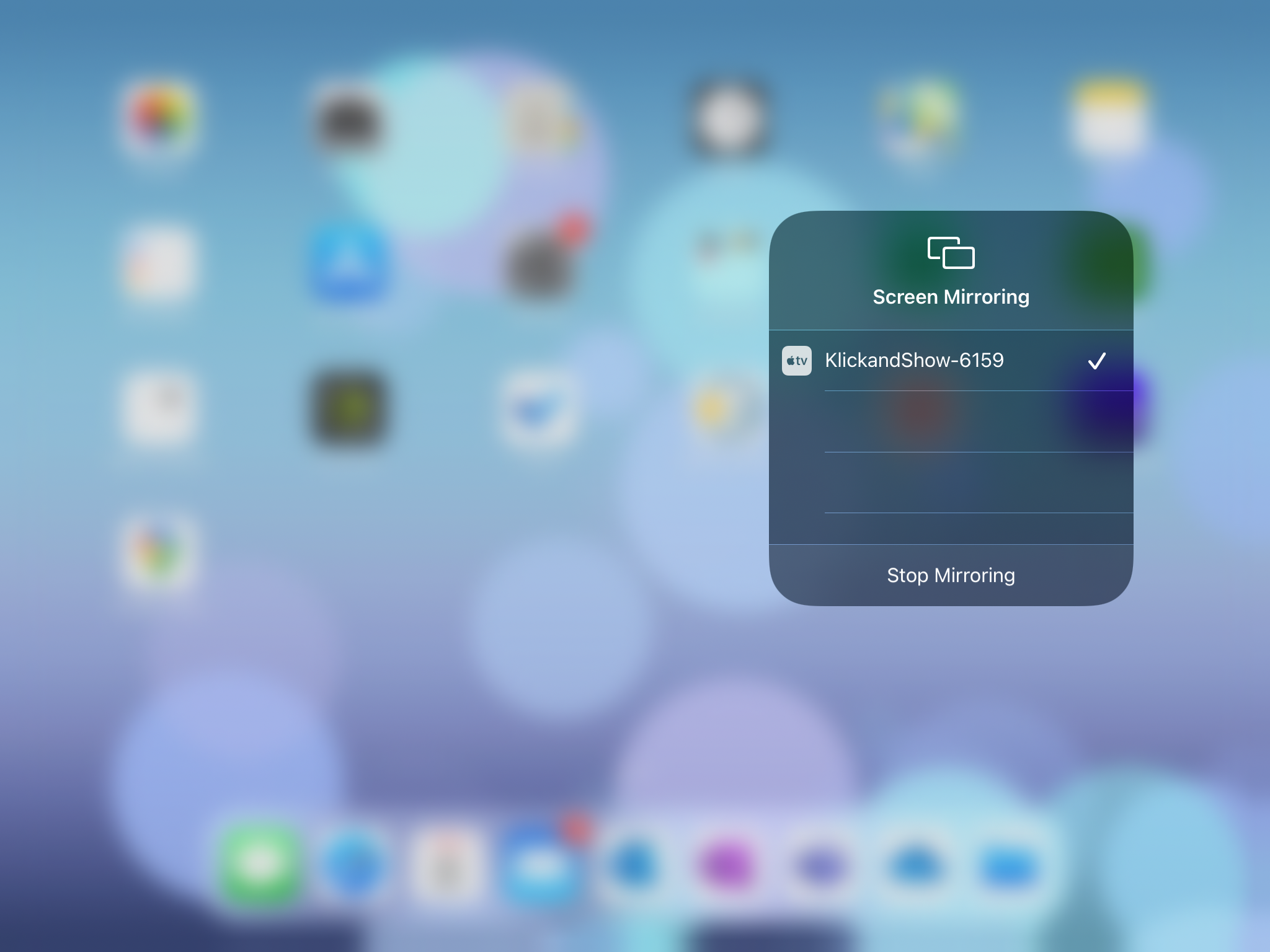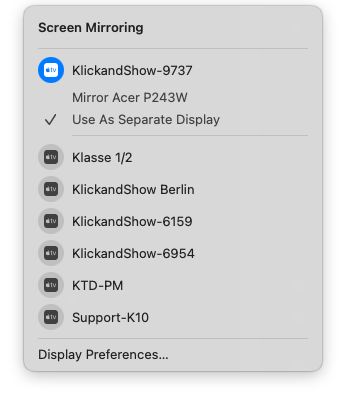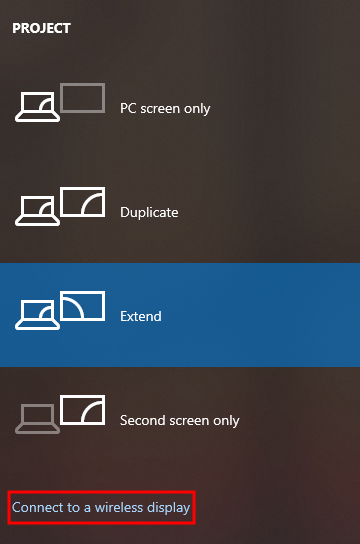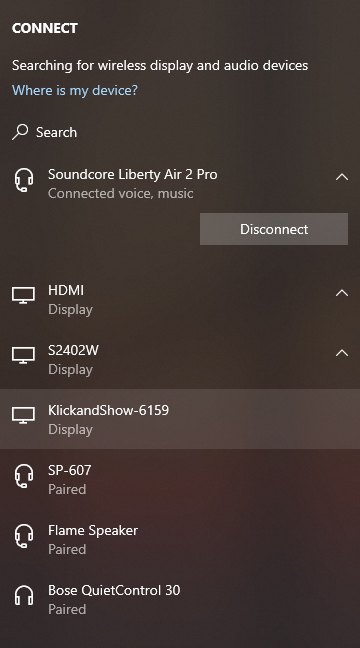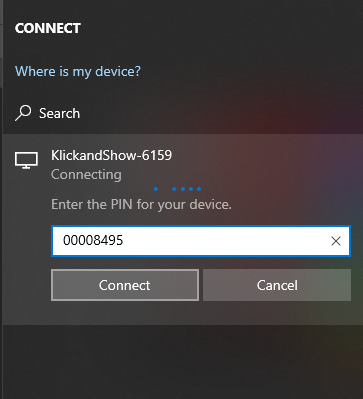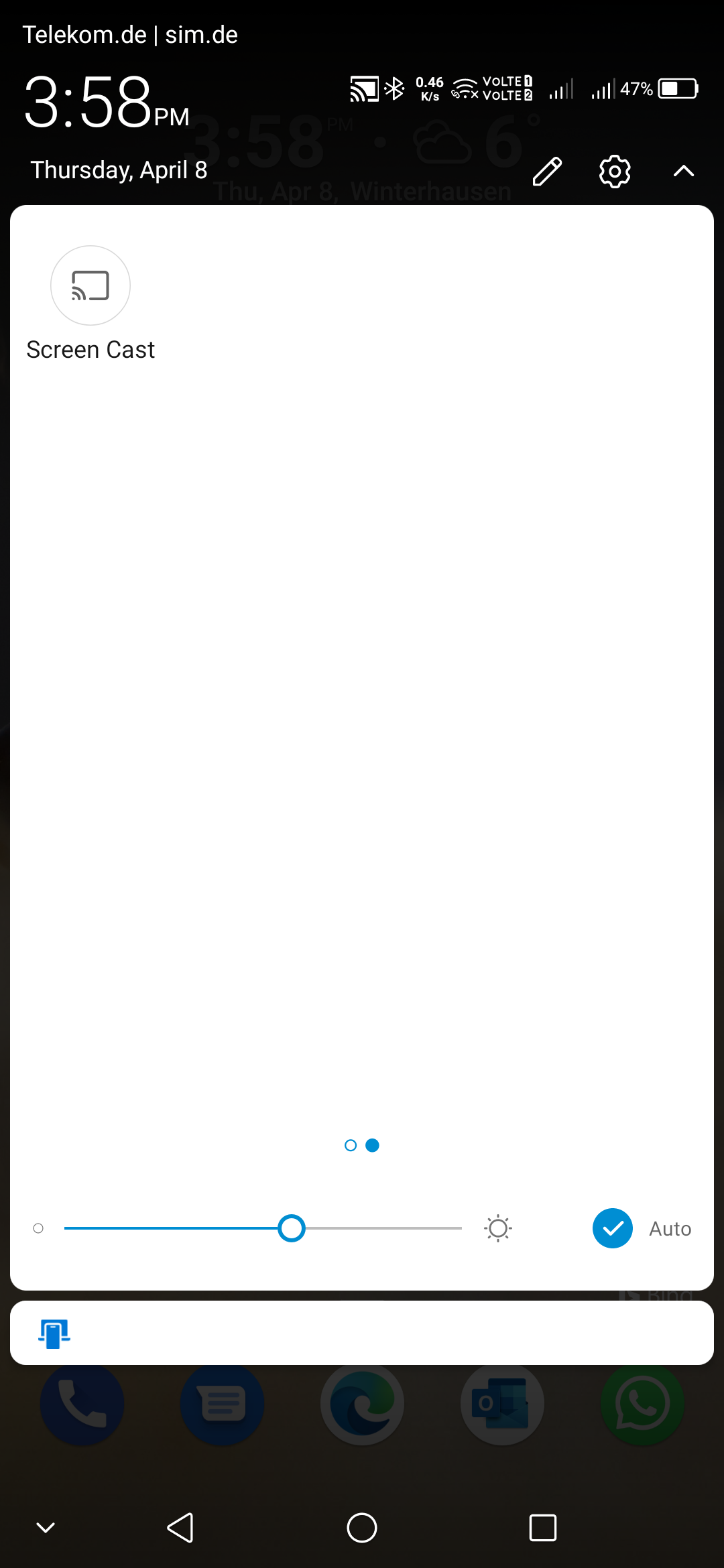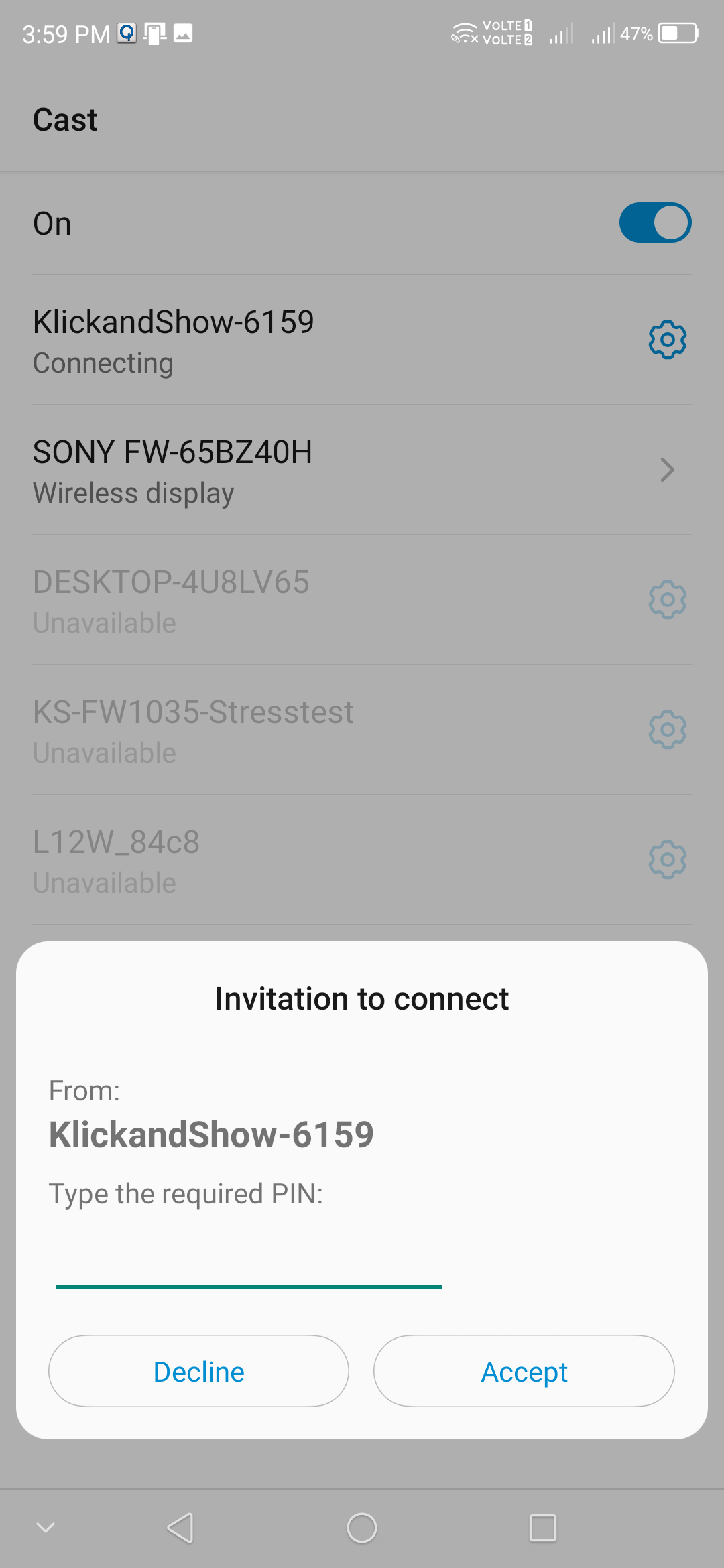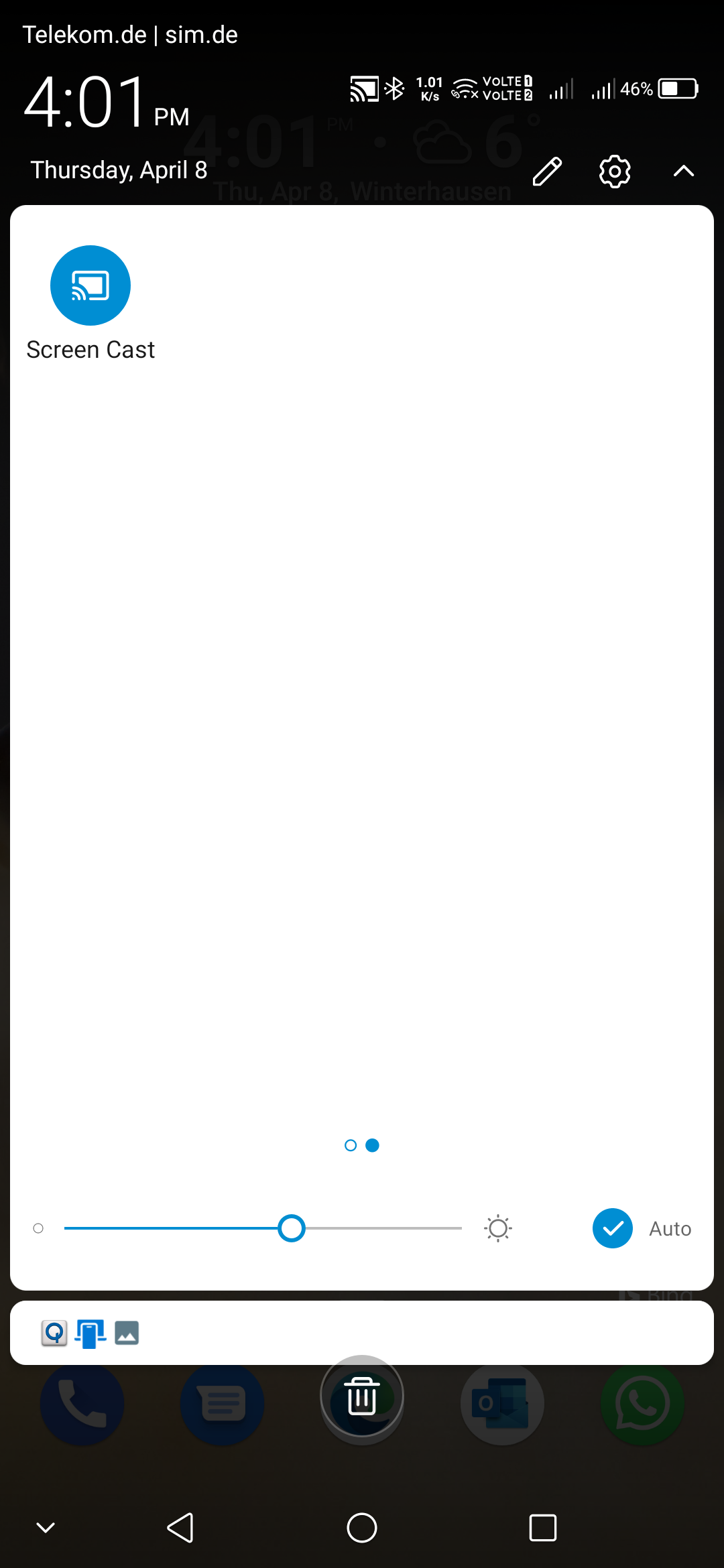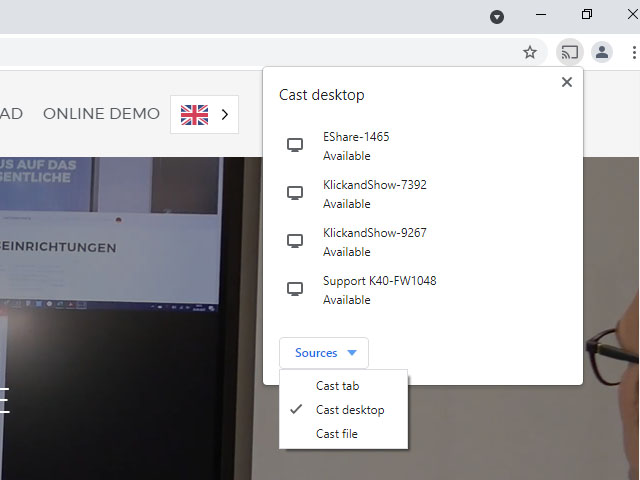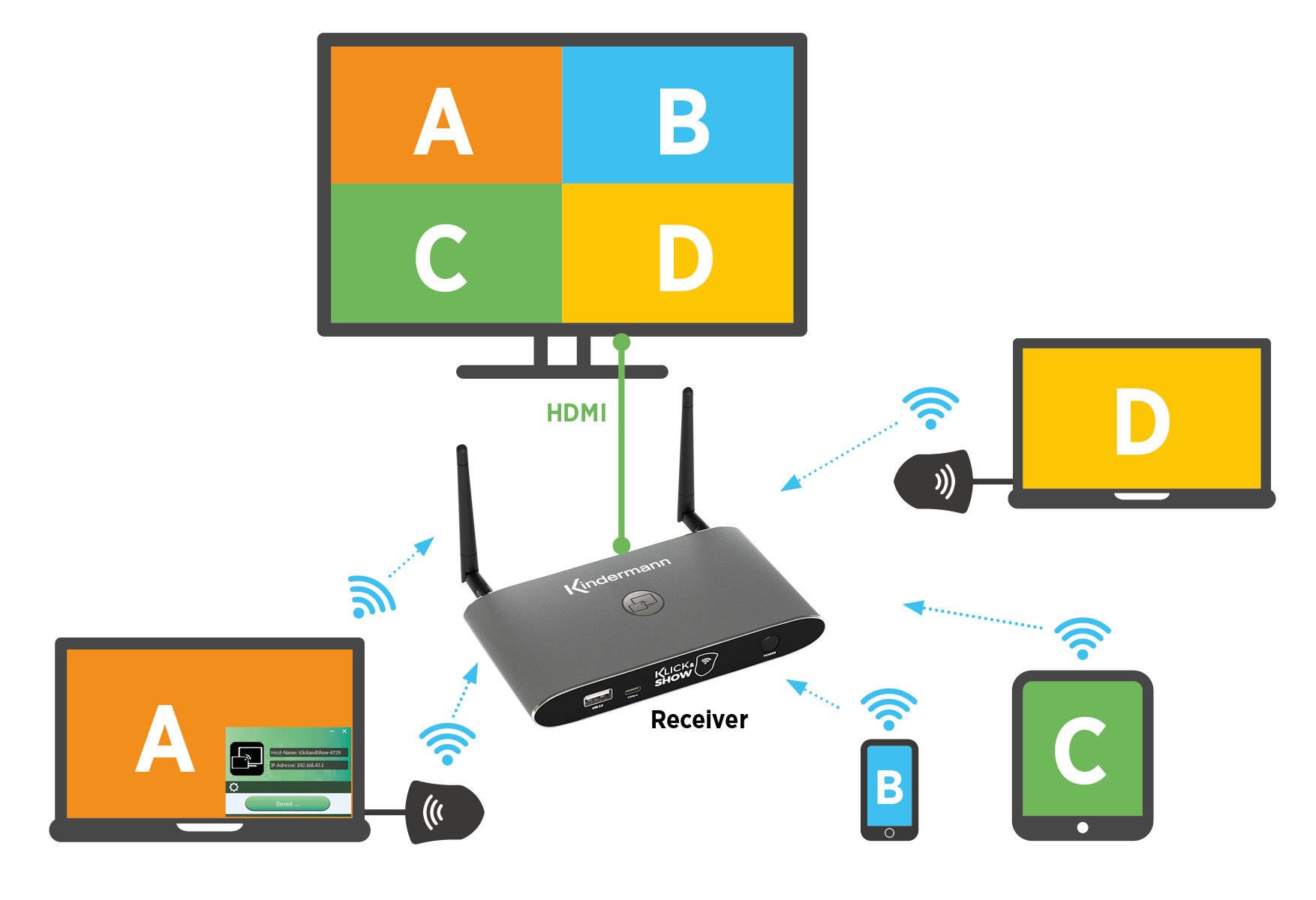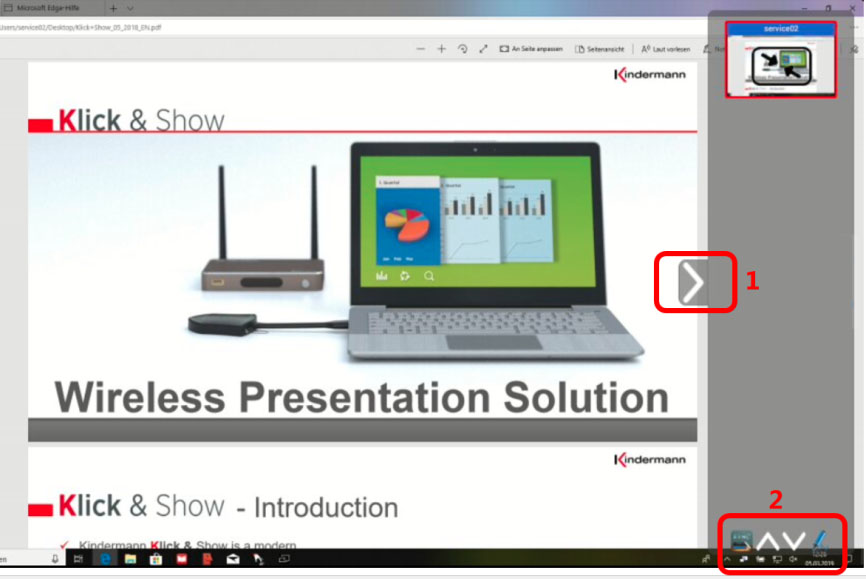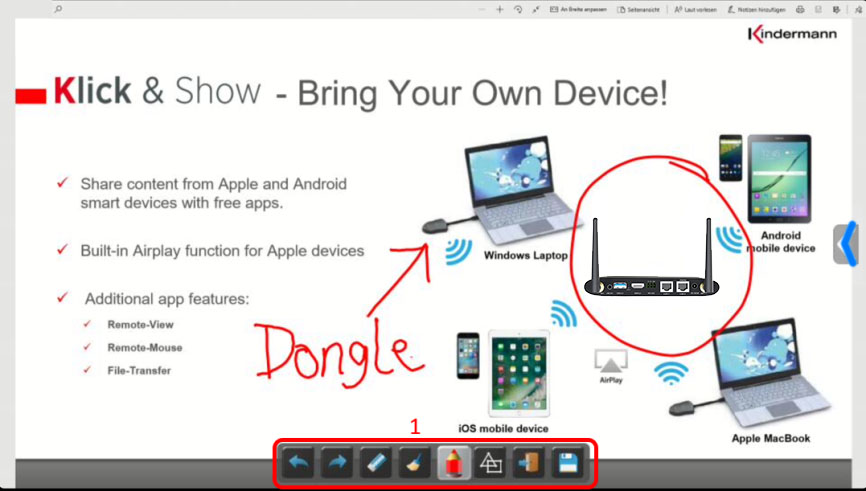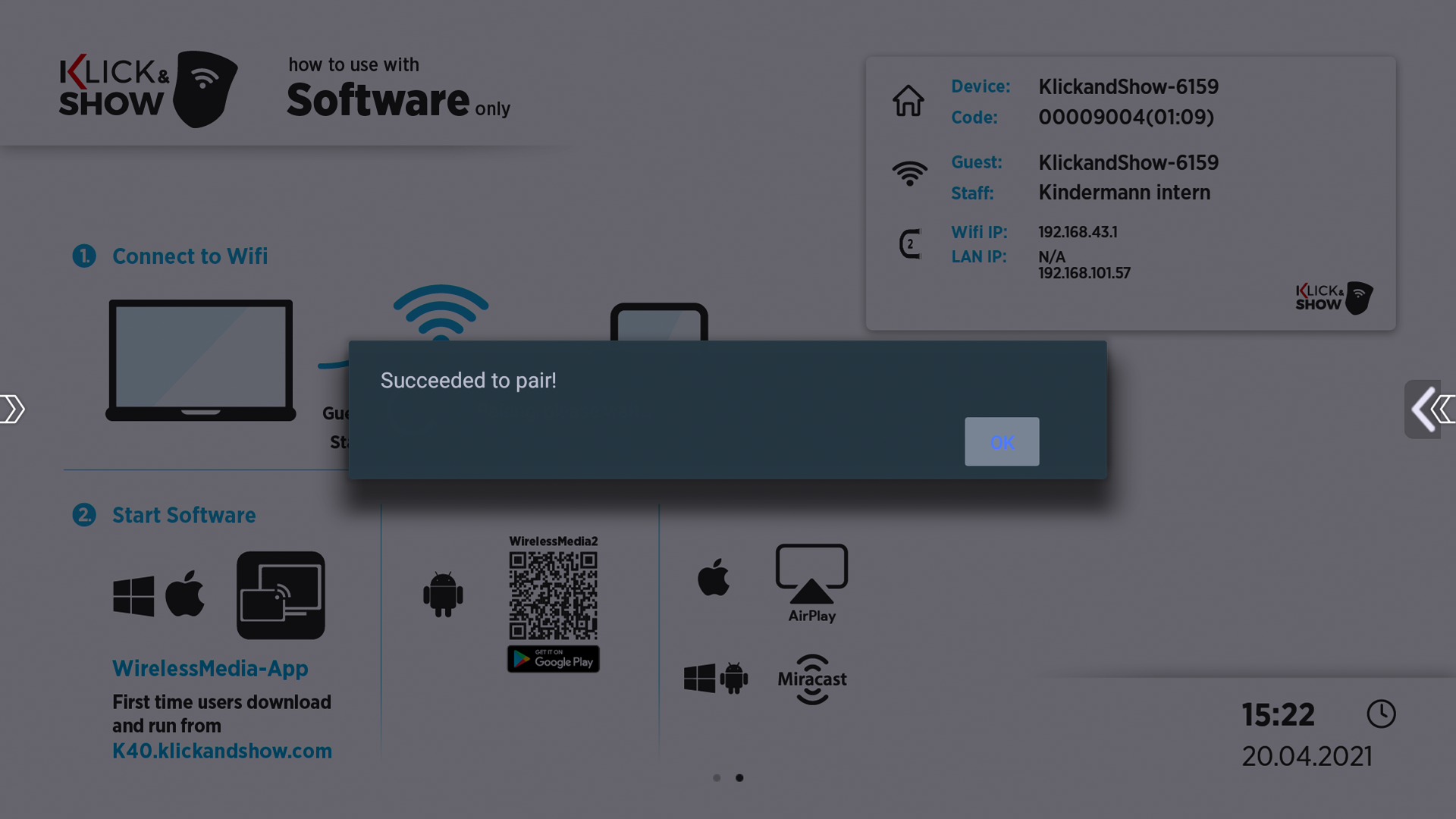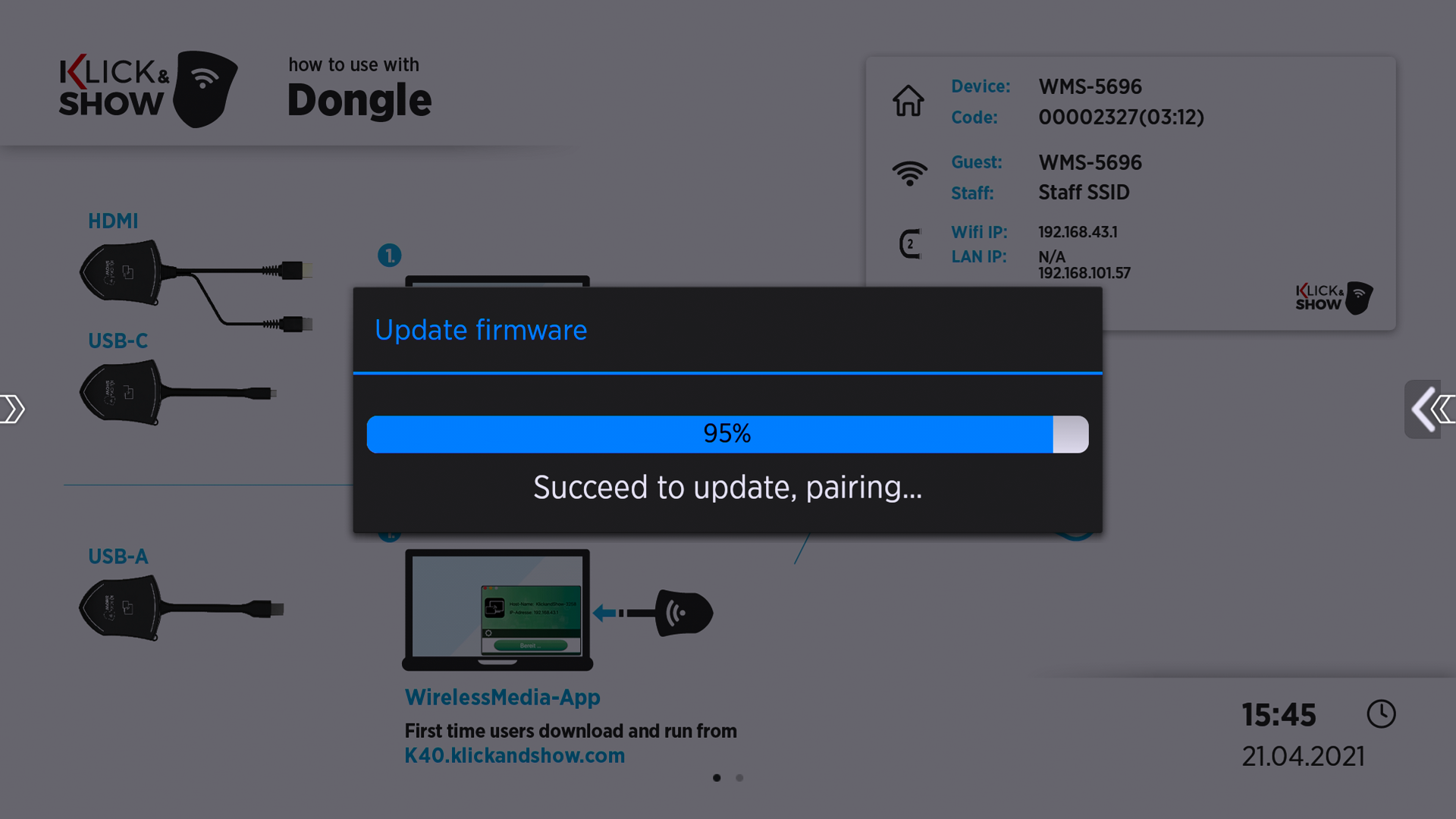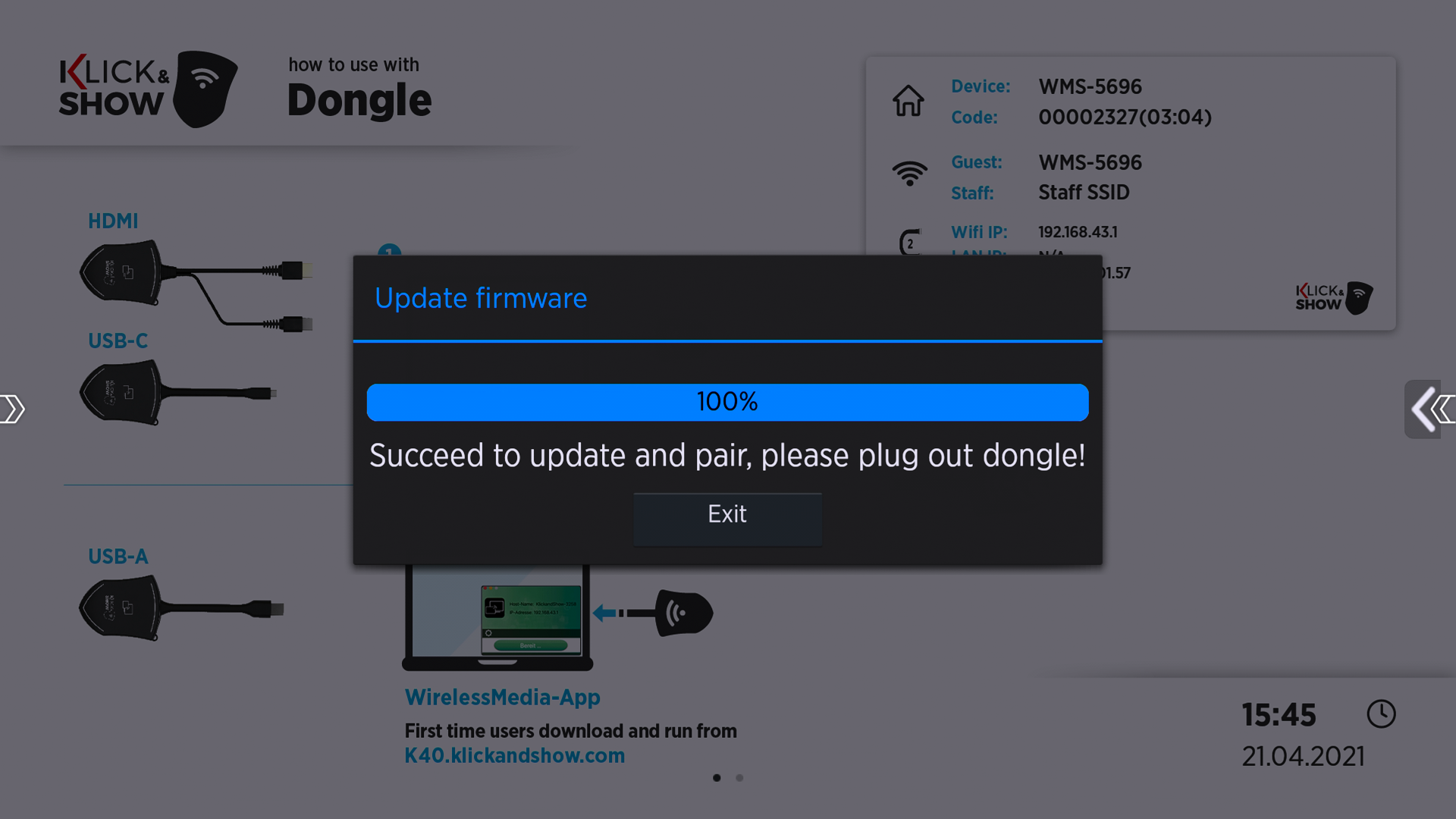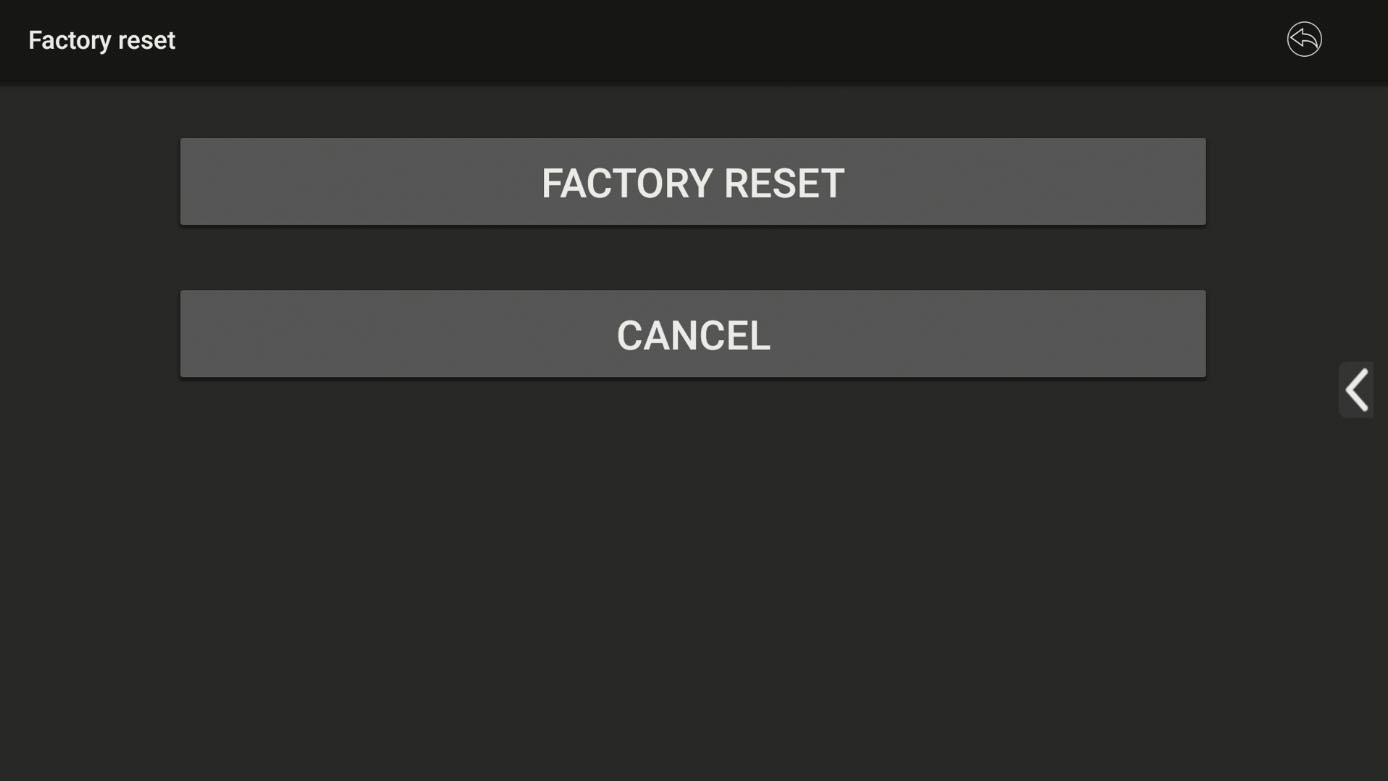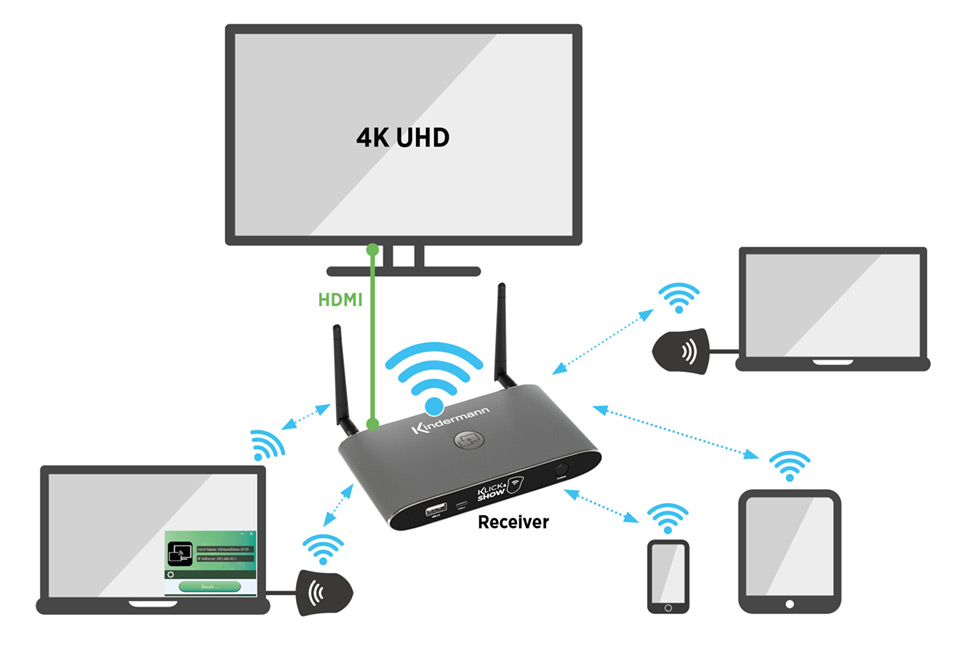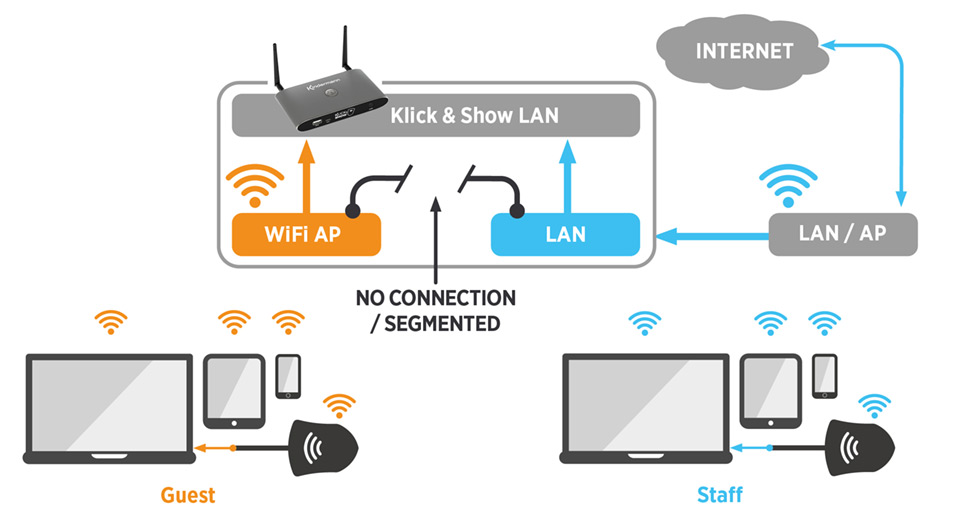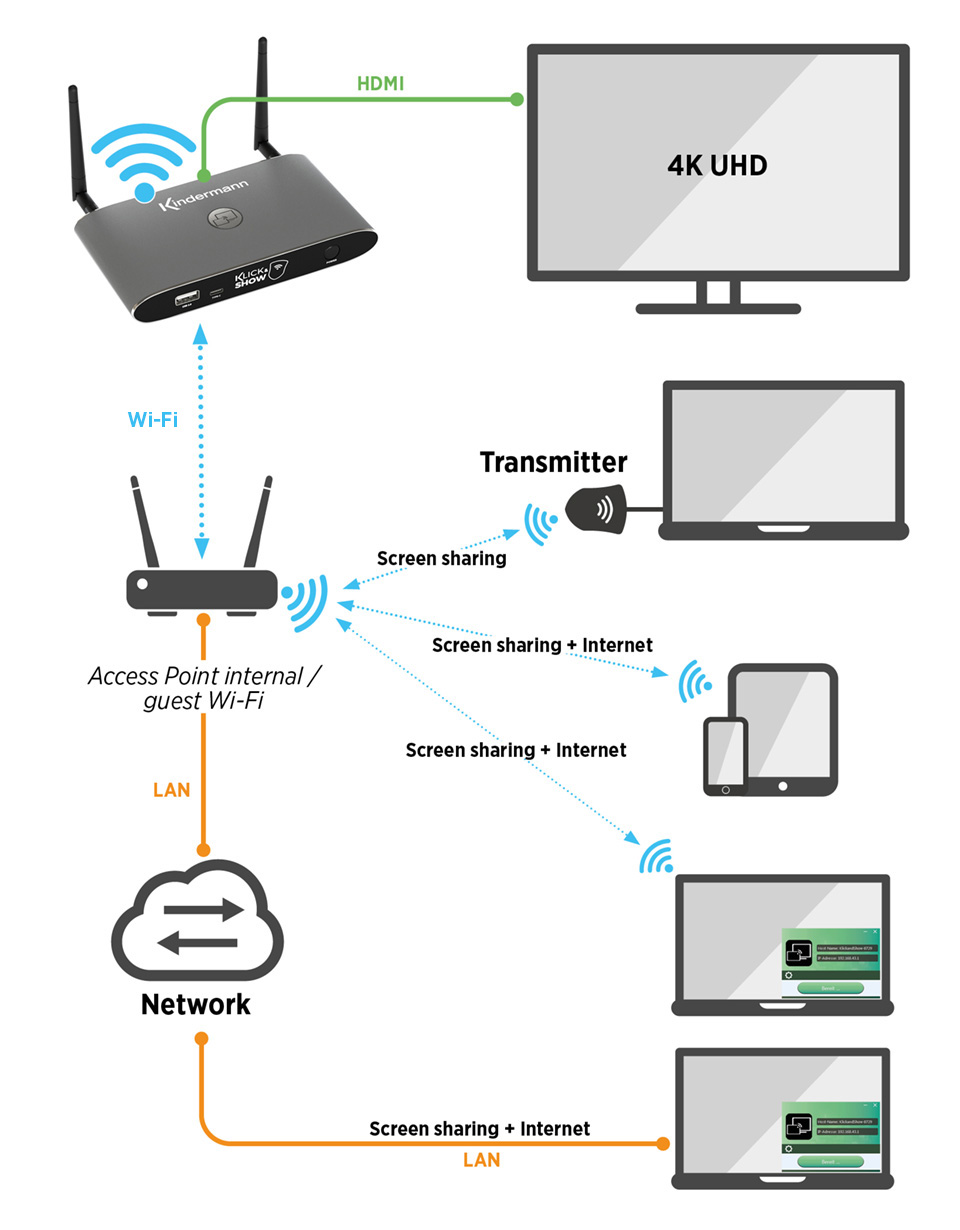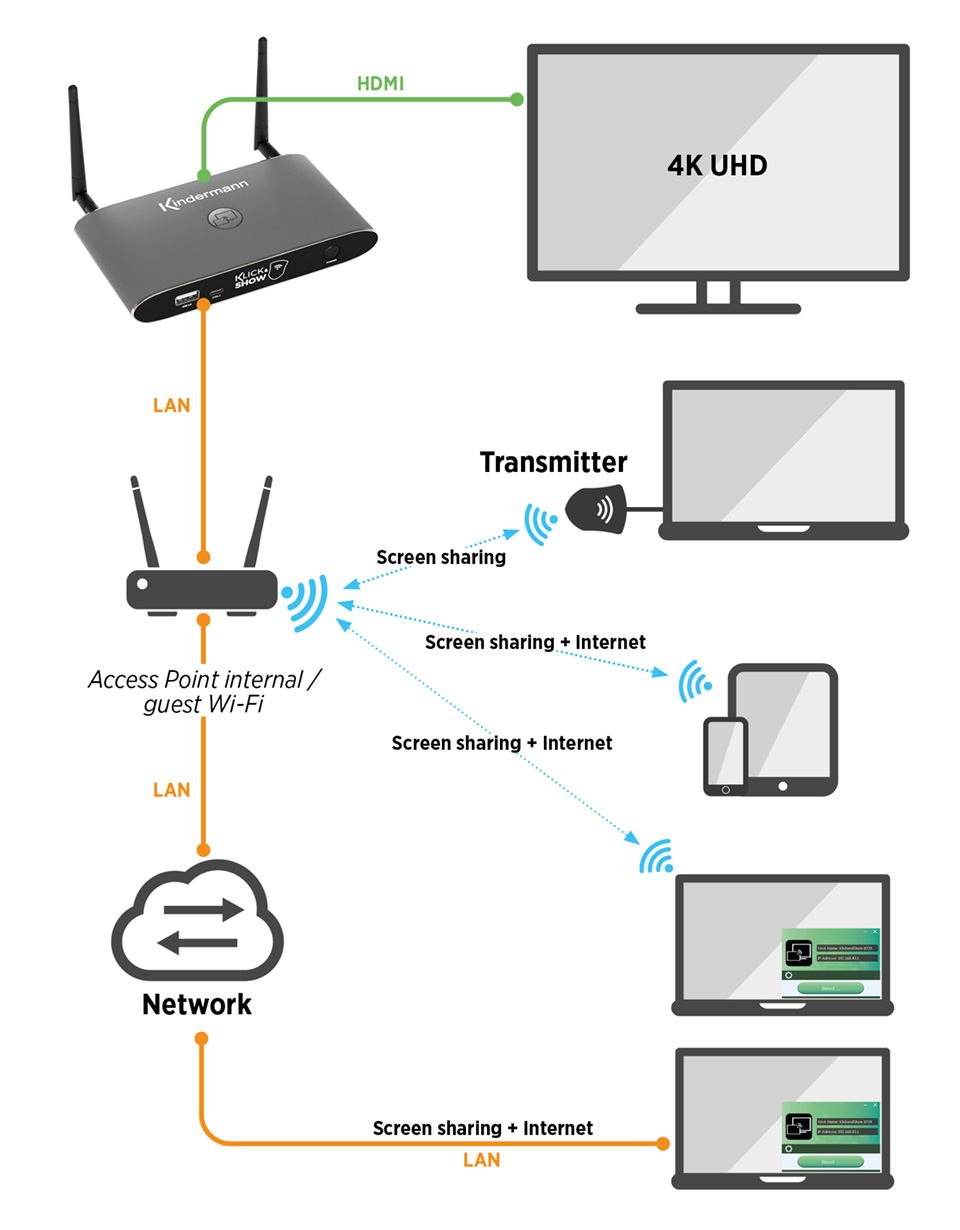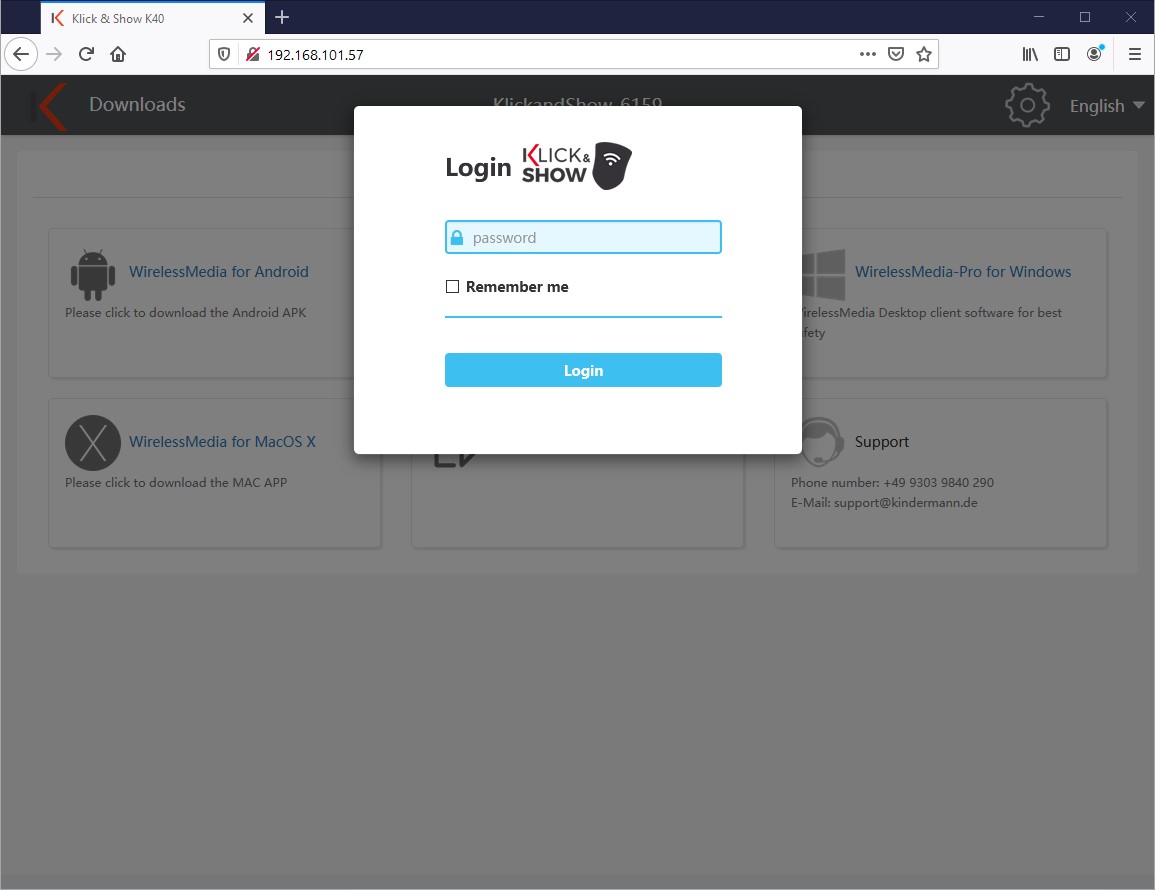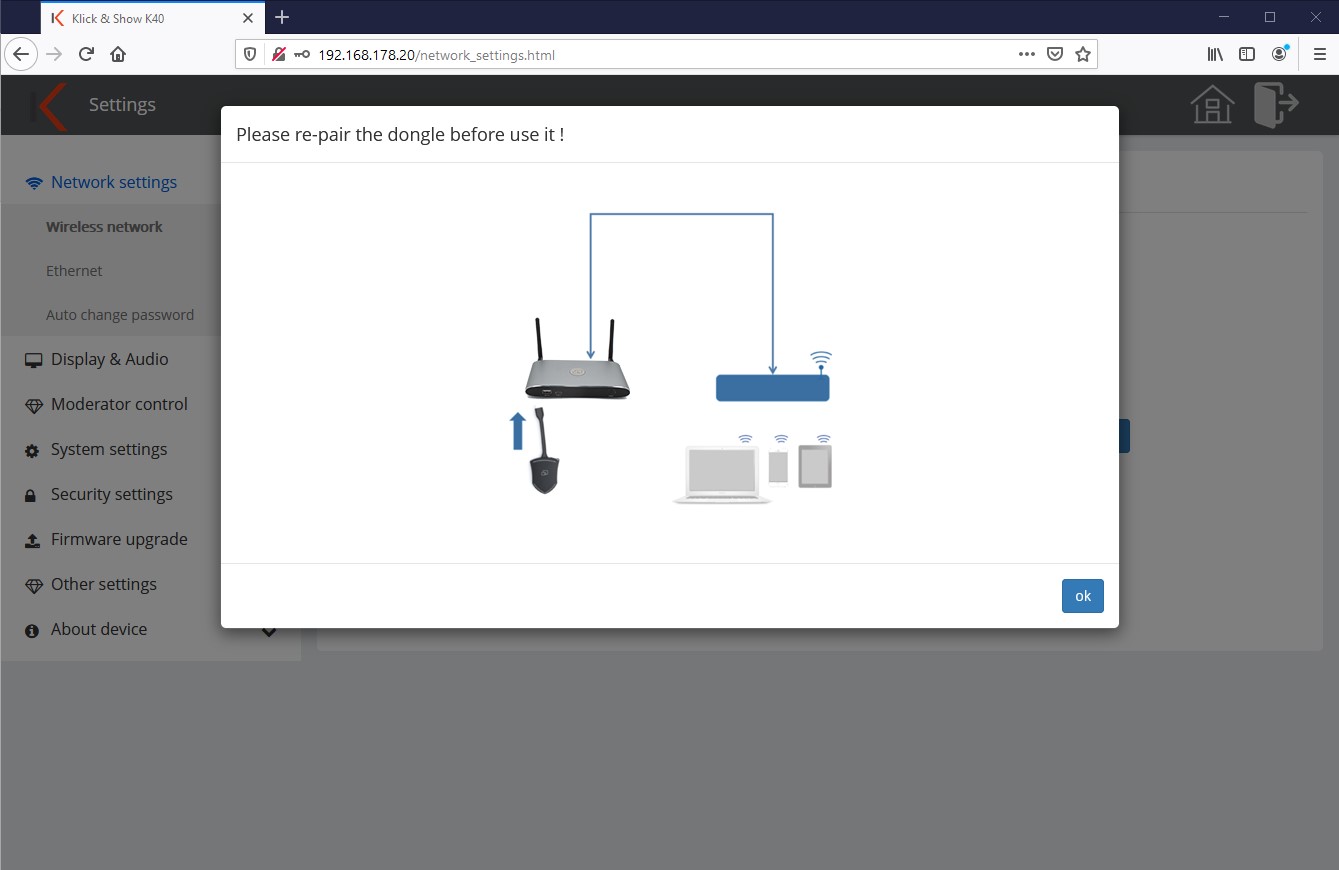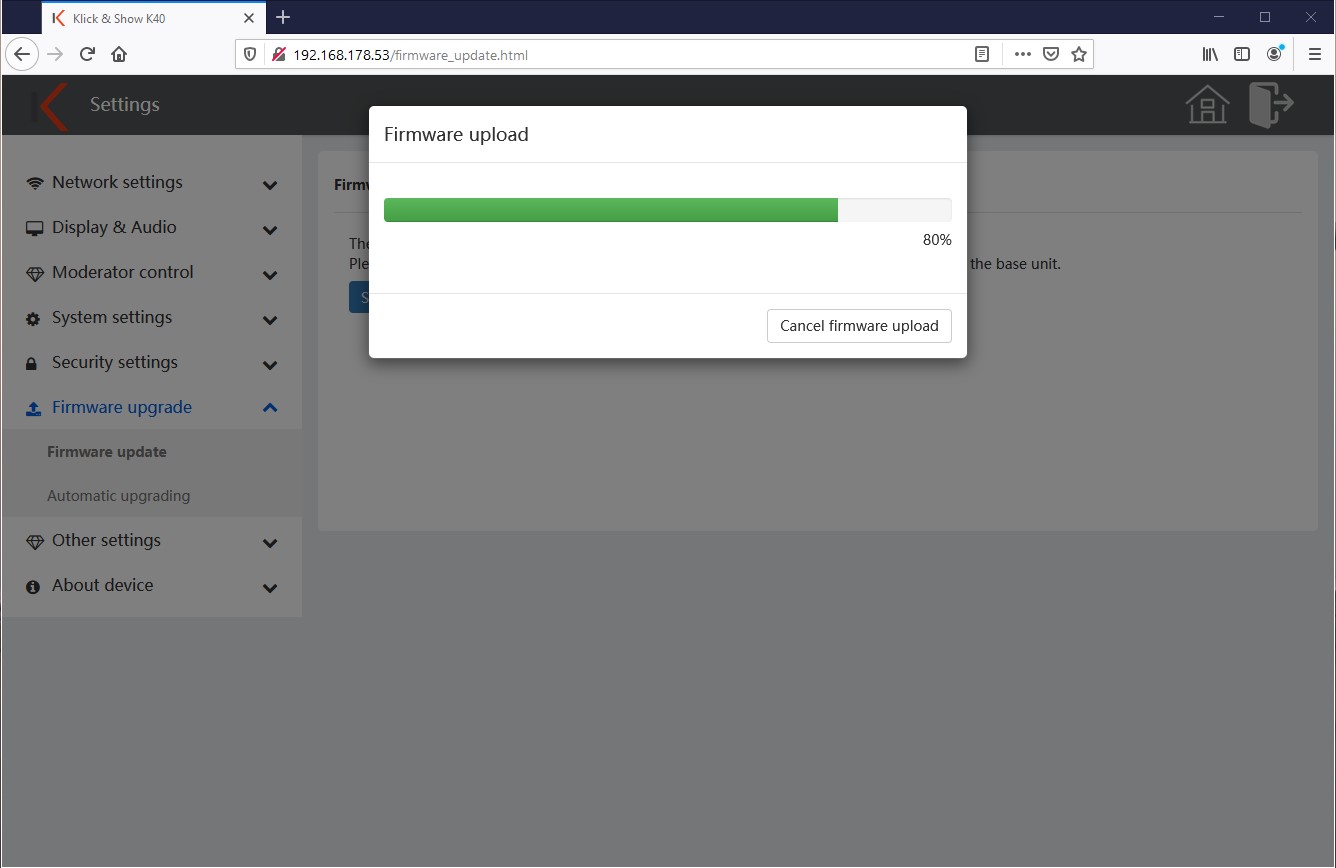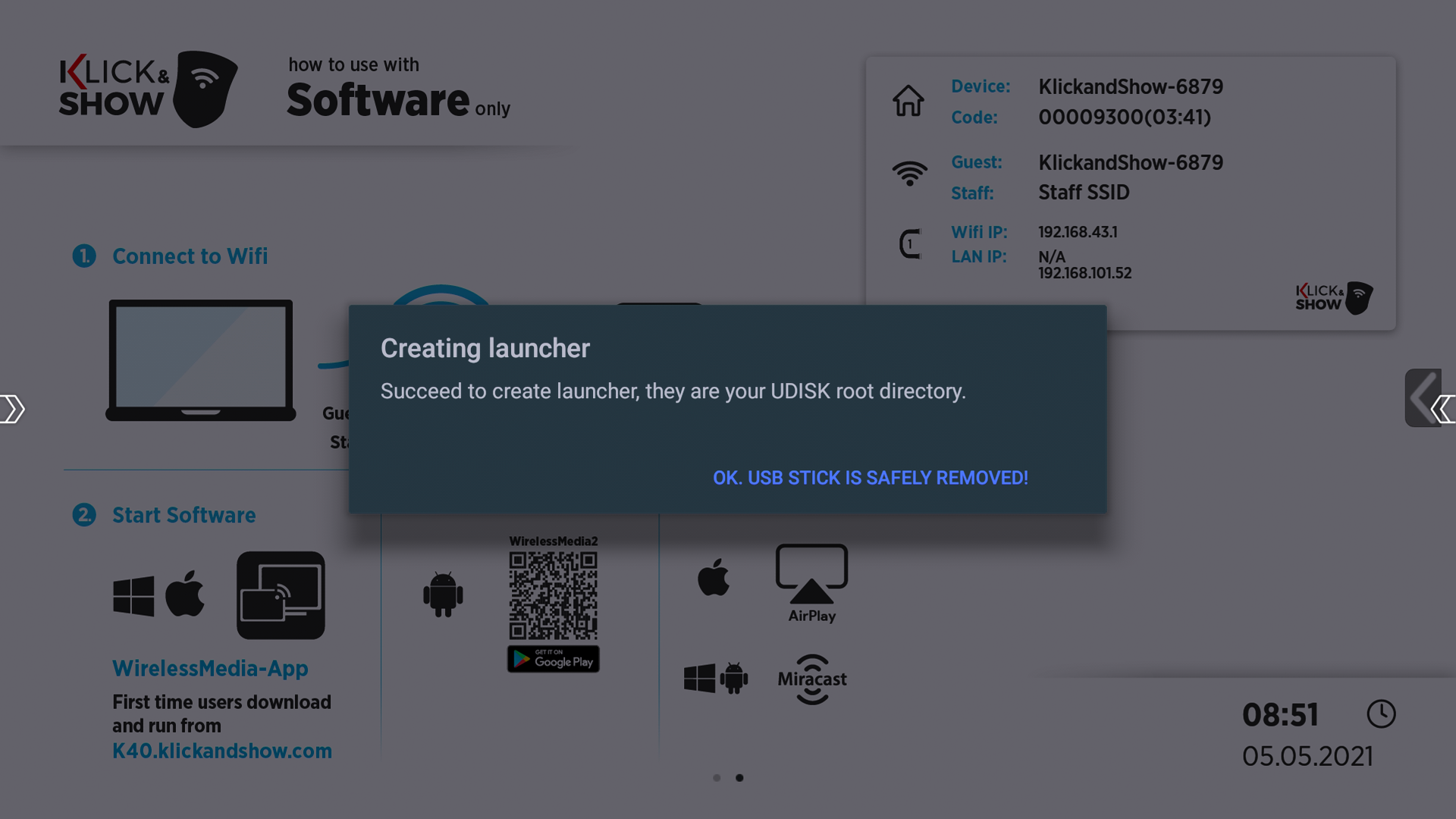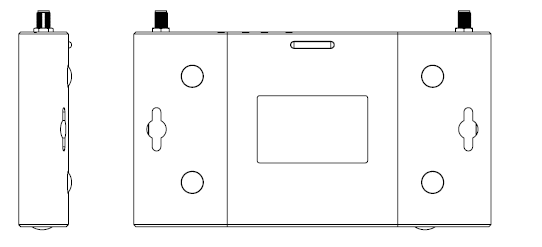
Installation and User's Guide
Klick & Show K-42U – Item No. 7488000310
Klick & Show K-42H – Item No. 7488000330
Klick & Show K-42UC – Item No. 7488000312
Klick & Show K-40 Base unit– Item No. 7488000315
table of contents:
1. Preface
2. Safety instructions
3. Product description
4. Device description
4.1 Connectors and buttons on the base device
5. Installation
5.1 Installation of the basic device
6. Commissioning
6.1.1 Home screen for the use of transmitters
6.1.2 Homescreen for use via software
6.2 Use of Klick & Show HDMI and Klick & Show USB-C Transmitters
6.3 Use of Klick & Show USB-A Transmitters
6.4 How do I get the Wireless Media Client?
6.5 WirelessMedia Client for Windows with USB-A Transmitter
6.6 WirelessMedia Client for Windows without transmitter
6.6.1 Advanced Features of the WirelessMedia Client for Windows
6.6.2 Extended user instructions for the WirelessMedia Client for Windows
6.7 WirelessMedia Client for MacOS with USB-A Transmitter
6.8 WirelessMedia Client for MacOS without transmitter
6.8.1 Advanced Features of the WirelessMedia Client for MacOS
6.8.2 Extended operating instructions for the WirelessMedia Client for MacOS
6.9 WirelessMedia2 App for Android
6.9.1 How do I get the WMedia2 Android app?
6.9.2 Use of the WMedia2 Android App
6.10.1 AirPlay Options on MacOS
6.11.1 Using Miracast on Windows
7. Splitscreen, Moderation & Tools
8. Service functions
8.1 Coupling of transmitters (pairing)
8.2 Firmware Update for Transmitters
8.3 Delete older versions of WirelessMedia for Windows
8.4 Restore factory settings (Reset)
9. Introduction to Network Configuration
9.2. Access Point Mode (Basic Configuration)
9.3.1 Wireless Infrastructure Mode
10. WebUI
10.2 Go to the administration menu
11. Klick & Show configure
11.1.2 Wireless Infrastructure Mode
11.1.3 LAN infrastructure mode
11.4.6 Save/install configuration
11.4.7 Serial interface (RS232)
11.6.1 Updating firmware manually
11.6.2 Automatically Update Firmware (OTA)
11.7.1 Create the startup program automatically
12. Port shares for use in THE LAN/WLAN
13. Telnet/RS232 commands
14. Technical data
15. Regulatory
15.1 Provision of open source software
16. Troubleshooting
Status: FW K1048 – Update 08.2021
1. Preface
Before using the product, read this instruction manual carefully. The pictures shown in this manual are for reference only and may differ from the real product. Contact your local dealer for assistance with maintenance.
In a constant effort to improve the product, we reserve the right to change features or parameters without prior notice or obligation. For the latest information, please contact your Kindermann Dealer.
2. Safety instructions

- Read the user manual carefully and keep it.
- Carefully unpack the device and pick up the original packaging and packaging material for possible later shipping.
- Follow basic safety precautions to reduce the risk of fires, electric shocks and injuries to people.
- Never open or modify the device. This can lead to electric shocks or burns.
- The product may only be operated with safety low voltage with the supplied power supply.
- The use of consumables or parts that do not meet the product specifications can lead to damage or malfunction.
- For all maintenance work, contact qualified service personnel.
- The system may only be stored and used in dry environments.
- Place the device in a well-ventilated place to avoid damage from overheating.
- To clean this device, do not use liquid or aerosol cleaners.
- Before cleaning, always unplug the power plug from the socket.
- Unplug the power plug if you are not using the device for a long time.
- Information on the disposal of waste equipment: The device may not be disposed of with household waste, but must be returned via the trade route.
- Before installing, make sure that all components and accessories are included.
- All power switches, plugs, sockets and power cords must be insulated and secure.
- All cables should be connected before switching on.
3. Product description
That Kindermann Klick & Show is a wireless presentation system for huddle spaces, meeting and training rooms, classrooms and many other occasions where flexible presentation is important. Klick & Show enables the screen of a computer, tablet or smartphone to be wirelessly transferred to a central screen and presented – without configuration, cables and waiting times. This makes the use of personal devices (BYOD – Bring Your Own Device) a breeze.
There are various transmission paths to choose from, above all the Klick & Show Transmitter with HDMI, USB-A or -C interface, which allows the use of Klick & Show make it particularly easy. HDMI and USB-C transmitters work without installing any software. Simply connect the transmitter and in a few seconds it is ready for transmission. To do this, a touch of the sensor surface is sufficient and the screen is mirrored to the display.
The software"WirelessMedia" is required for use in conjunction with the USB-A transmitter and is available for Windows or MacOS. Alternatively, this can also be used without a transmitter.
For Android devices, you can find the WirelessMedia2 app for free in the Google Play Store. Users of Apple products can use airplay with the Klick & Show Connect base. From firmware version .1039, screen transmission via Miracast is also possible, which is supported by Windows and Android devices without the installation of additional software.
With firmware version .1048, ChromeCast is also supported. This means that devices with ChromeOS can now also be used. ChromeCast is also available on Windows 10, MacOS X and Linux via the Chrome/Chromium browser.
Klick & Show K-4x allow the simultaneous display of up to four transmissions in a split screen display.
3.1 Features
The technical data can be found here.
3.2 Scope of delivery
Klick & Show K-40 Base (7488000315)
- 1 Kindermann Klick & Show K-40 Base
- 2 WLAN antennas
- 1 universal power supply for mains voltage 100 – 240 VAC, 12 VDC/1.5 A, with EU and UK adapter attachments
- 1 Quick Start Guide Quick Start Guide
Klick & Show K-42U Kit (7488000310)
- 1 Kindermann Klick & Show K-40 Base
- 2 WLAN antennas
- 2 Klick & Show USB-A Transmitter
- 1 Klick & Show A/C USB stick with wireless media software
- 1 universal power supply for mains voltage 100 – 240 VAC, 12 VDC/1.5 A, with EU and UK adapter attachments
- 1 Quick Start Guide Quick Start Guide
Klick & Show K-42UC Kit (7488000312)
- 1 Kindermann Klick & Show K-40 Base
- 2 WLAN antennas
- 2 Klick & Show USB-C Transmitter
- 1 universal power supply for mains voltage 100 – 240 VAC, 12 VDC/1.5 A, with EU and UK adapter attachments
- 1 Quick Start Guide Quick Start Guide
Klick & Show K-42H Kit (7488000330)
- 1 Kindermann Klick & Show K-40 Base
- 2 WLAN antennas
- 2 Klick & Show HDMI Transmitter
- 1 universal power supply for mains voltage 100 – 240 VAC, 12 VDC/1.5 A, with EU and UK adapter attachments
- 1 Quick Start Guide Quick Start Guide
4. Device description
| No. | name | description |
|---|---|---|
| 1 | Klick & Show Basic device | Basic device with WLAN access point |
| 2 | transmitter | With integrated WLAN function for wireless transmission of the screen |
| 3 | WirelessMedia Software | App for Windows, MacOS and Android for wireless transfer of the screen via software |
| 4 | Airplay | Standard protocol for wirelessly transferring the screen from MacOS and iOS devices |
| 5 | Miracast | Standard protocol for wireless transmission of the screen from Windows and Android devices |
| 6 | ChromeCast | Standard protocol for wireless screen transmission via Chrome/Chromium browser (available on ChromeOS, Windows, MacOS X and Linux). |
4.1 Connectors and buttons on the base device
| No. | name | description |
|---|---|---|
| 1 | USB-A socket | For pairing the USB-A and HDMI transmitters, for connecting a touch screen, a mouse and for local firmware update via USB stick |
| 2 | USB-C socket | For pairing the USB-C transmitters, for connecting a touch screen, a mouse and for local firmware update via USB stick |
| 3 | Status LED | Red: Startup process Flashing green: Switched on Constant green: Ready for transmission Turquoise: Active transmission |
| 4 | Stand-by button | To turn on and off |
| No. | name | description |
|---|---|---|
| 1 | LINE OUT | 3.5 mm stereo jack for connection to an analog audio system |
| 2 | USB 3.0 port | For pairing the USB-A and HDMI transmitters, for connecting a touch screen, a mouse and for local firmware update via USB stick |
| 3 | Reset | Reset to factory settings |
| 4 | HDMI 2.0 | HDMI output for connection to displays, projectors, etc. (Supports HDMI 2.0, 4K60Hz) |
| 5 | RS-232 | 3-pin terminal (included) for receiving and sending RS-232 commands |
| 6 | LAN1 | 100 Mbps, to connect to a network |
| 7 | LAN2 | 1 Gbps, to connect to a network with PoE (Power over Ethernet) support |
| 8 | Mains connection | Connect the supplied power supply to the device and the power supply |
| 9 | ANT. | For screwing on the two enclosed WLAN antennas |
4.2 Transmitters
| No. | name | description |
|---|---|---|
| 1 | USB-A Transmitter | To connect to the USB-A socket of a computer, to transfer the screen in conjunction with the Wireless Media Software Client |
| 2 | HDMI transmitter | HDMI connector: transmission of the image signal USB-A connector: For power supply, for transferring touchback information and for pairing with the base |
| 3 | USB-C Transmitter | USB-C connector: transmission of the image signal (DisplayPort Alt Mode), power supply and for the transmission of touchback information as well as for pairing with the base |
| 4 | USB Tokens | USB storage with the WirelessMedia Software Client for Windows or MacOS |
Status LED in transmitter
- Permanently green: Ready for transfer
- Permanently red: Active transmission
- At the base: Pairing is finished, you can pull the transmitter off the base
- Flashes green – on the computer:
– 100ms AN; 300ms OFF = initialization/connection establishment
– 500ms AN; 800ms OFF = Connect to WI-FI
– 200ms AN; Get 800ms AUS = IP
– 800ms AN; 200ms OFF = establish communication to the base
– 300ms AN; 100ms OFF = No communication between PC/Laptop and Sensor Button TOUCH
![]() hint:
hint:
The Klick & Show HDMI Transmitter can be used on almost any device with HDMI output. If the device does not have a USB port that can provide the power supply, you can use a standard USB power supply or a power bank.
5. Installation
5.1 Installation of the basic device
The basic device can be placed on a table or mounted on the wall.
![]() hint:
hint:
Please position the base as close as possible to the playback device to avoid problems with HDMI signal transmission.
Tools needed for wall mounting:
• A drill (depending on the type and nature of the wall)
• Screwdriver or cordless screwdriver suitable for the mounting screws
Required mounting accessories (not included):
• 2 x screws (recommended head diameter: 7 mm)
• 2 x Matching dowels
Installation:
- Drill two holes in the wall at a distance of 144 mm.
- Turn on the mounting screws. Please leave about 4 mm of space between the wall and the screw head so that the base can be inserted in between.
- Place the base device on the wall so that the screw heads of the two mounting screws reach into the holes of the base. Gently press the device against the wall and slide it down or to the side (depending on the mounting situation).
- If the base is too loose, turn the screws a little further.
Mounting of wlan antennas:
In order to avoid damage during transport, the antennas are supplied loosely and should be installed for reception optimization.
- The antennas should be aligned vertically.
- The antennas should be installed at least 50 cm away from metallic surfaces to avoid unwanted reflections. Likewise, at least a distance of 1 meter to other radio systems in the same frequency band should be maintained (e.B. WLAN access points).
- We recommend a direct line of sight between the base and transmitters and the mobile devices.
- Due to the special radiation properties of the dipole antennas, you should use the Klick & Show Do not install the base directly above or below the transmitters (under/ceiling mounting).
5.2 Power supply
Included is a universal power supply for mains voltage 100 – 240 VAC, 12 VDC/1.5A with various regional adapter attachments.
Adapter Types:
- Mount the required type plug adapter of your country.
- Connect the power supply to the base device.
- Plug the power supply into a suitable socket.
![]() hint:
hint:
As soon as the power supply is active, the basic device (boot process) starts.
5.3 Power over Ethernet (PoE):
If the network switch supports PoE (Power over Ethernet), the power can also be provided via the network cable on the LAN2 port. The plug-in power supply is then not required.
![]() hint:
hint:
The base supports the PoE 802.3af standard.
5.4 HDMI port
- Connect the HDMI output of the base through a suitable HDMI cable to a display or projector.
5.5 Audio connectors
The transmitters transmit the audio signal of the computer together with the video signal to the base device.
HDMI audio output:
Via HDMI, image and sound are transmitted digitally. A playback device, e.B display with speakers, can play the sound directly.
Analog audio output
The sound is output analogously at the jack socket "LINE OUT". Here, active speakers or existing audio systems in the room can be connected.
Audio configuration on PC/laptop
In the factory setting shifts Klick & Show Silently silently transmits the computer's internal speaker and transmits the sound to the Klick & Show Base as soon as an image is transmitted.
If the transmitter is disconnected, the computer's previous audio configuration is restored.
![]() Hint: If there is no audio output via the Klick & Show please check the audio configuration of your computer. Here the device "Wireless Media" must be selected.
Hint: If there is no audio output via the Klick & Show please check the audio configuration of your computer. Here the device "Wireless Media" must be selected.
You can adjust the volume via the audio settings of your computer, tablet or smartphone.
5.6 LAN connection
The base can be connected to a network via CAT cable.
Depending on the network configuration, the wired Network access also available in WLAN (bridging).
The network connections can be used for:
- Network integration of the base in guest or corporate network
- Over-the-air update (OTA) of the base
- Access to the WebUI for configuration
- Telnet control of the base
Klick & Show has two separate network interfaces, so it can be connected to two separate networks. The IP addresses through which the Klick & Show can be reached from the respective network, are also displayed on the home screen.

![]() hint:
hint:
Details on network configuration can be found in the chapter WebUI.
5.7 Use of touch screens
Klick & Show transmits image and audio signals as well as touch input to a display at the same time. Klick & Show supports the USB-HID protocol. For example, interactive touch displays, projectors or whiteboards as well as a mouse can be connected to the base via USB in order to
- to control the mouse pointer and click function, perform multitouch gestures, work interactively, etc.
The computer can thus be controlled remotely from the central touch screen, for example.B. - to use the moderator function.
- to use the integrated whiteboard app.
- Firmware upgrades and other info dialogs to confirm.
6. Commissioning
6.1 Home screen
- Turn on the base device.
- After the start process, two home screens are displayed alternately:
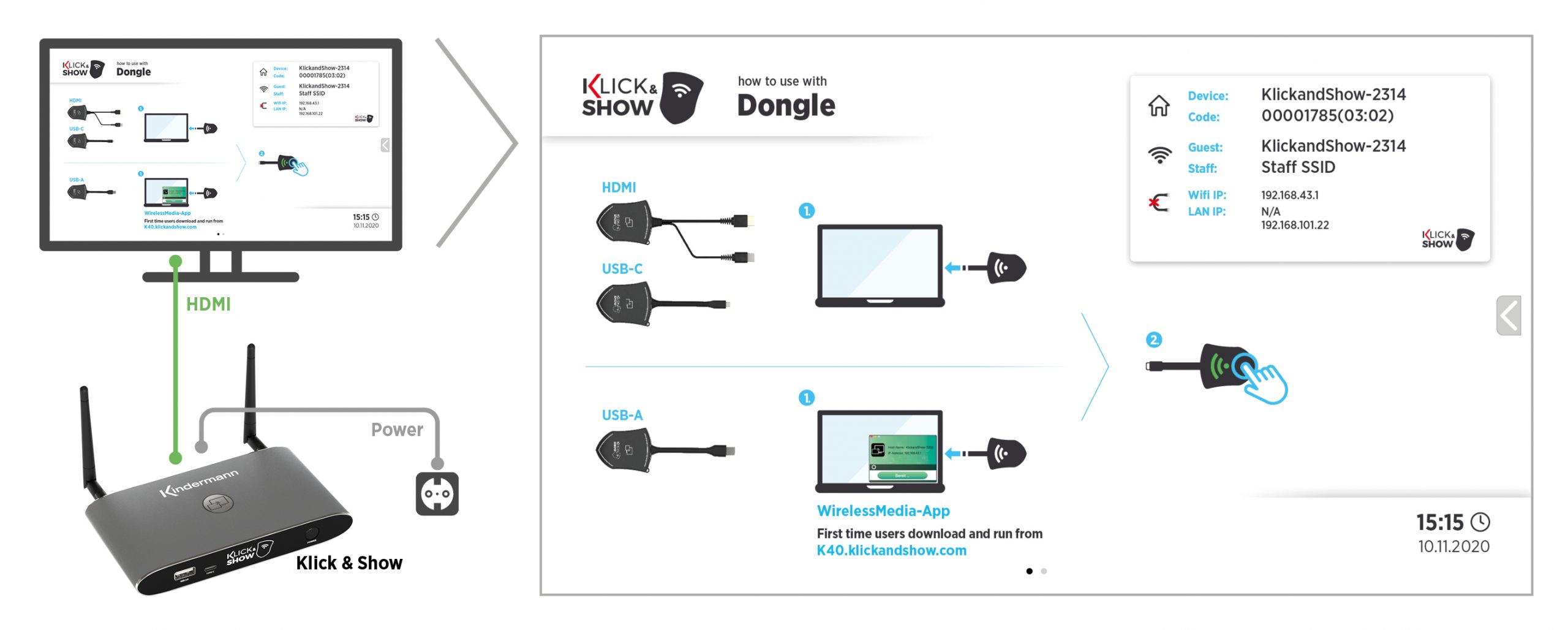
6.1.1 Home screen for the use of transmitters
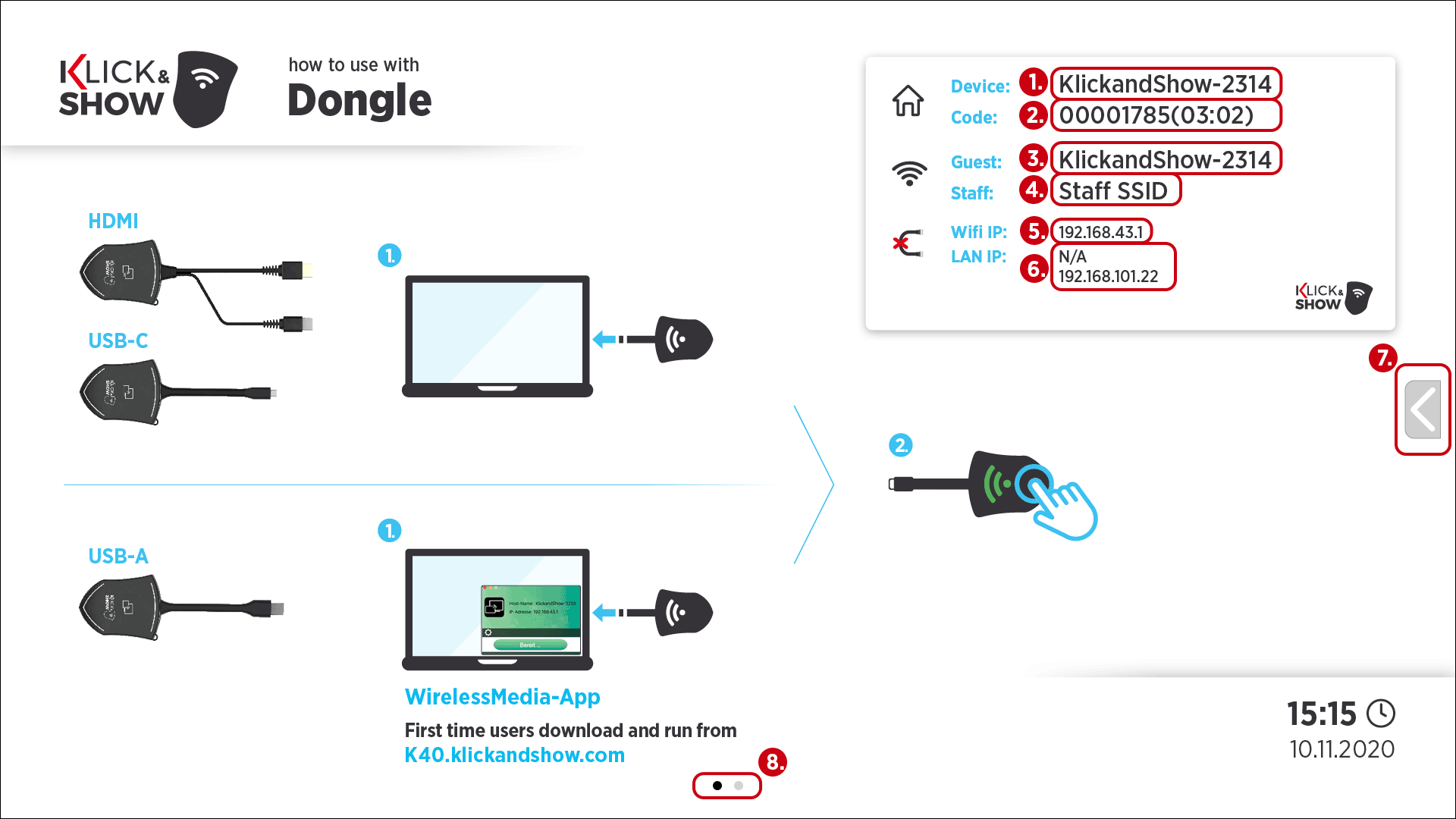
6.1.2 Homescreen for use via software
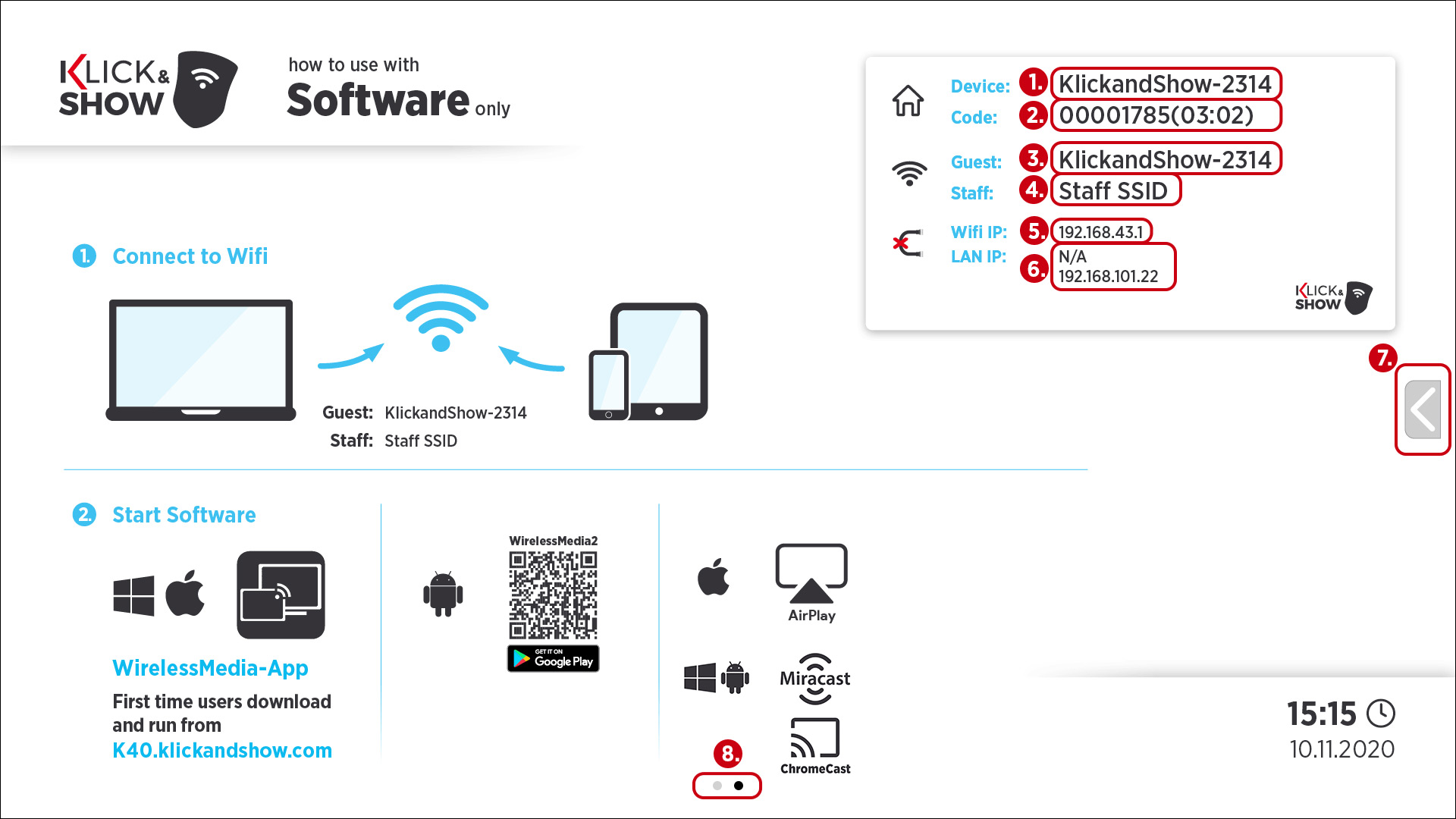
| No. | name | description |
|---|---|---|
| 1 | device | The device name can be freely assigned in the configuration. In the factory setting, the name klickandshow-xxxx The device name is also the WLAN identifier (SSID) |
| 2 | code | WLAN password of the base device (Time until the automatic change of the WLAN password (will only be displayed if active) |
| 3 | guest | WLAN Name (SSID) of the Klick & Show Base |
| 4 | internal | WLAN name (SSID) of the internal network (only display of the name, the network itself must be broadcast from an existing access point) |
| 5 | WLAN IP | IP address of the Klick & Show Basis for access via WLAN |
| 6 | LAN IP | "N/A" = no connection to network or no IP address assigned 192.168.101.40 = Assigned IP address over wired network connection 1 and/or 2 |
| 6 | Status Dual Network (WLAN + LAN) | |
| 7 | Moderation menu Whiteboard App | Opens the moderator menu with the preview function on all connected clients. Provides access to the |
| 8 | Position | Displays the change between the two alternating home screens. |
6.2 Use of Klick & Show HDMI and Klick & Show USB-C Transmitters
Plug the transmitter into the HDMI and USB-A interface or into the USB-C interface of your computer and wait until the transmitter is constantly green.
Now you can touch the surface of the transmitter to activate the transmission. The transmitter will confirm the activation with a slight vibration and a color change of the LED to red.
Your computer's screen is now transferred to the base and displayed on the connected display.
To stop the transmission, tap the transmitter again.
![]() hint:
hint:
The HDMI and USB-C transmitters behave on the computer like an external monitor, i.e. You can also define it as an extended screen. To do this, select the key combination Windows + P on Windows and go to macOS ![]() > SystemPreferences,clickMonitors,and then clickArrange.
> SystemPreferences,clickMonitors,and then clickArrange.
![]() Hint:
Hint:
The USB-C transmitter can also be used in conjunction with Chromebooks, tablets, smartphones, etc. that have a USB-C port. The specific range of functions depends on the hardware of your device and the respective software. Video transmission requires Support for DisplayPort alternate Mode. The range of functions of your device can be found in the manual.
Whether your device supports touchback depends primarily on the operating system.
6.3 Use of Klick & Show USB-A Transmitters
Unlike the HDMI and USB-C transmitters, the USB-A transmitter requires software that captures the screen content several times per second (screen grabbing), encodes and via WLAN to Klick & Show Basis transmits where the individual "screenshots" are decoded again and output to a playback device via HDMI.
This software is the WirelessMedia Client available for Windows 10 and MacOS.
![]() hint:
hint:
If your computer is only USB-C If you have connections, you can use the USB-C/A adapter.
The description of the functionality depending on the operating system can be found in the following chapters:
- 6.5 WirelessMedia Client for Windows with USB-A Transmitter
- 6.6 WirelessMedia Client for Windows without transmitter
- 6.7 WirelessMedia Client for MacOS with USB-A Transmitter
- 6.8 WirelessMedia Client for MacOS without transmitter
6.4 How do I get the Wireless Media Client?
The following options are available:
- By downloading k40.klickandshow.com
- By download from the Klick & Show Base
Enter the IP address displayed on the home screen into the browser and download the "WirelessMedia App" app to match your operating system.
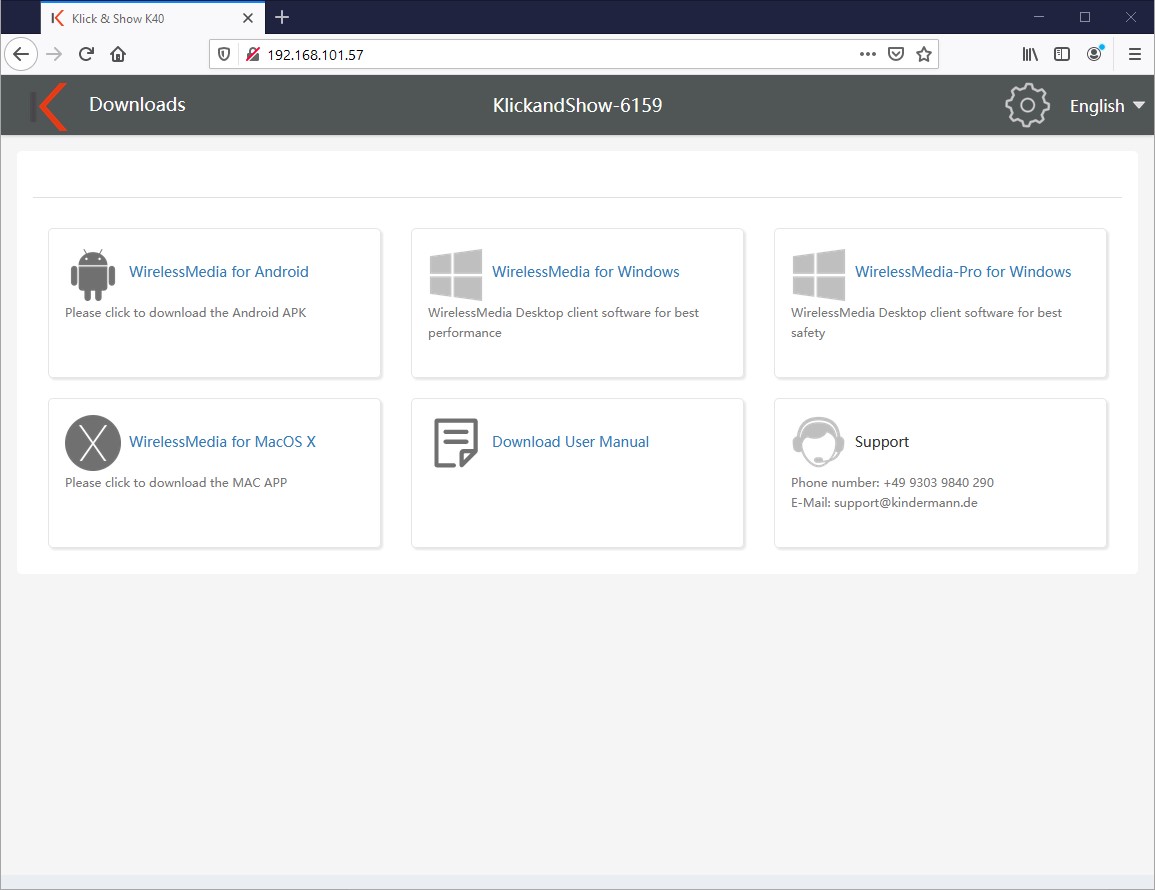
- Copy the app from the enclosed USB token to the PC.
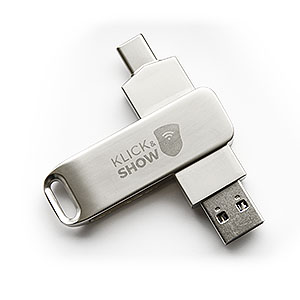
![]() hint:
hint:
The USB token is only available to the Klick & Show K-42U Kit. However, you can purchase it separately or turn any commercially available USB stick into a token by using the apps.
The instructions can be found in chapter 11.7.1.
6.5 WirelessMedia Client for Windows with USB-A Transmitter
If you Klick & Show first use in conjunction with a USB-A transmitter, you must first run the WirelessMedia Client.
If the program has been run once, the Wireless Media Client is automatically started when the transmitter is plugged in.
![]() hint:
hint:
No admin rights are required to run the WirelessMedia Client. However, an entry is made in the registry. In the Autostart section, the WirelessMediaAutoStartC3.exe service is set up, which ensures that the WirelessMedia Client starts automatically when the USB-A transmitter is plugged in.
If, for example, the installation of "auto-starting software" is blocked due to Group Policy (e.B. via Active Directory), you can use the "WirelessMedia Portable for Windows" version. This does not require any installation. However, the "Portable" version of the client must be started manually before each use!
You can use the WirelessMedia Client for Windows either in conjunction with the USB-A transmitter or stand-alone. With several participants in a meeting, a mixed operation is possible. Details on the different usage scenarios can be found in the following chapters.
Plug the transmitter into a USB-A port your computer.
As soon as the LED display of the dongle is constantly green and the color of the WirelessMedia Client changes to green, the system is ready for use.
Now you can touch the surface of the transmitter to activate the transmission or click with the mouse on the button "Ready...". The transmitter will confirm activation with a slight vibration and a color change to red. The WirelessMedia Client also turns red accordingly.
Your computer's screen will now be transferred to the base and displayed on the connected display. The user name of the computer appears briefly.
To stop the transfer, tap the transmitter again or click on the red "... transmits" button in the WirelessMedia Client.
After use, you can simply untract the transmitter from your computer.
![]() hint:
hint:
for information about the options and other features of the wireless media client for windows see points 6.6.1 and 6.6.2
6.6 WirelessMedia Client for Windows without transmitter
Connect your computer to the "GUEST" or "EMPLOYEE" Wi-Fi network that is displayed on the home screen.
Is the Klick & Show Basically connected to a network via CAT cable, all other computers in this network also have access to the Klick & Show Base.
Run the "WirelessMedia Client" ![]() by double-clicking. A list of all available Klick & Show in network is displayed. Select the Klick & Show with which you want to connect and then click on "Connect".
by double-clicking. A list of all available Klick & Show in network is displayed. Select the Klick & Show with which you want to connect and then click on "Connect".
As a rule, access is password-protected ![]() .
.
Enter the 8-digit "code" that is displayed on the home screen. When you have successfully connected to the base, the WirelessMedia Client changes color to green.
Now click on the button "Ready ...", the window color changes to red and the screen content is transferred. The name of the logged-in user appears briefly.
You can minimize the app window. in the windows taskbar you can see if the screen content is transferred ![]()
![]() or not
or not ![]() .
.
To stop the transfer, click on "... transmits", the window color is green again.
![]() Hint:
Hint:
If the desired Klick & Show Base not displayed in the list, you can enter the IP address directly in the black box and then click the ![]() click.
click.
In this case, your computer is either not connected to the same network (segment) or there are network-side restrictions that block an automatic search.
In this case, please contact your network administrator.
To exit the WirelessMedia Clients click on the Close icon (X) or in Windows Sytemtray right-click on the ![]() Icon and then click Exit. A confirmation dialog follows.
Icon and then click Exit. A confirmation dialog follows.
6.6.1 Advanced Features of the WirelessMedia Client for Windows
click the gear icon ![]() in the app to use the "options" or close.
in the app to use the "options" or close.
Options:
- Extended screen:
If this option is selected, the Klick & Show like an external monitor, i.e. a second "virtual" screen is set up and transmitted.
If you use the transfer with Klick & Show ( pause), the extended desktop remains active until you either deselect the "Extended Screen" function in the APP or close the WirelessMedia app. Alternatively, you can use the key combination "Windows + P" in the Windows configuration to select "PC screen only" or "Duplicate".
![]() hint:
hint:
When the Extended Screen feature is activated for the first time, a driver is installed. The installation process requires administrator privileges.
- Keep aspect ratio:
This option is active by default. This ensures that the image on the source device and on the display have the same proportions. If you deselect the function, the image is stretched to the overall width and thus possibly distorted.
- Lowest latency (mouse):
The option is active by default. The mouse pointer is displayed during movements without perceptible delay (~20 ms), which significantly improves ergonomics.
The mouse cursor is displayed the same in all applications, regardless of whether it changes its shape on the PC monitor.
Disabled: The shape of the mouse pointer on the display corresponds to the shape in the application. The movement of the pointer takes place with a small delay (100 – 150 ms). - Stream mode:
– Fluid priority: Here a variable (codec) is used. In the case of fast-moving images, the quality is somewhat reduced in favor of a smooth display.
– Quality priority: In order to ensure the highest possible playback quality, the data rate is increased for fast-changing images, such as a video transmission. This can lead to a slight but perceptible delay (latency).
- Volume: The slider allows the playback volume on the output display or on the analog output of the Klick & Show Basis can be regulated during an active transmission.
6.6.2 Extended user instructions for the WirelessMedia Client for Windows
If the WirelessMedia version does not match the firmware of the base, you will be informed by a message after starting the APP:
In this case, delete the previous version and install the current one.
![]() Hint:
Hint:
A right-click on the icon ![]() in the Windows taskbar, the Klick & Show Context menu. The software tells you versions of the basic device, the transmitters and the WirelessMedia client.
in the Windows taskbar, the Klick & Show Context menu. The software tells you versions of the basic device, the transmitters and the WirelessMedia client.
6.7 WirelessMedia Client for MacOS with USB-A Transmitter
![]() hint:
hint:
To use Klick & Show requires at least MacOS 10.10.
As an alternative to the Wireless Media Client, you can also airplay your MacBook with the Klick & Show connect.
If you Klick & Show To connect to your Mac for the first time, you must first download and run the WirelessMedia for MAC starter program.
If the WirelessMedia Client for MacOS has already been run once, it starts Klick & Show when plugging in the transmitter automatically.
![]() hint:
hint:
If your Mac is just USB-C If you have connections, you can use the USB-C/A adapter.
You can use the WirelessMedia Client for MacOS either in conjunction with the USB-A transmitter or stand-alone. With several participants in a meeting, a mixed operation is possible.
Details on the different usage scenarios can be found in the following chapters.
Plug the transmitter into the USB port. As soon as the LED display of the dongle is constantly green and the color of the WirelessMedia Client changes to green, the system is ready for use.
Now you can touch the surface of the transmitter to activate the transmission or click with the mouse on the button "Ready...". The transmitter will confirm activation with a slight vibration and a color change to red. The WirelessMedia Client also turns red accordingly.
Your Mac's screen will now be transferred to the base and displayed on the connected display. The user name is displayed briefly.
To stop the transfer, tap the transmitter again or click on the red "... transmits" button in the WirelessMedia Client.
In the end, you can simply pull off the transmitter.
![]() hint:
hint:
For information about options and other features of the WirelessMedia Client for MacOS, see Point 6.8.1
6.8 WirelessMedia Client for MacOS without transmitter
Connect your MacBook to the "GUEST" or "EMPLOYEE" Wi-Fi network that is displayed on the home screen.
Is the Klick & Show Basically connected to a network via CAT cable, all other computers in this network also have access to the Klick & Show Base.
3. Run the "WirelessMedia Client" ![]() with a double click. A list of all available Klick & Show in network is displayed. Select the Klick & Show with which you want to connect and then click on "Connect".
with a double click. A list of all available Klick & Show in network is displayed. Select the Klick & Show with which you want to connect and then click on "Connect".
As a rule, access is password-protected ![]() .
.
Enter the 8-digit "code" that is displayed on the home screen. When you have successfully connected to the base, the WirelessMedia Client changes color to green.
Now click on the button "Ready ...", the window color changes to red and the screen content is transferred. The name of the logged-in user appears briefly.
You can minimize the app window. In the MacOS status bar shows an icon ![]() the current connection status.
the current connection status.
To stop the transfer, click on "... transmits", the window color changes back to green.
![]() Hint:
Hint:
If the desired Klick & Show Base not displayed in the list, you can enter the IP address directly in the black box and then click the ![]() click.
click.
In this case, your computer is either not connected to the same network (segment) or there are network-side restrictions that block an automatic search.
In this case, please contact your network administrator.
To exit the WirelessMedia Clients click on the Close icon (red dot) or in the system tray with the right mouse button on the ![]() Icon and then click Exit. A confirmation dialog follows.
Icon and then click Exit. A confirmation dialog follows.
6.8.1 Advanced Features of the WirelessMedia Client for MacOS
click the gear icon ![]() in the app to use the "options" or close.
in the app to use the "options" or close.
Options:
- Keep aspect ratio:
This option is active by default. This ensures that the image on the source device and on the display have the same proportions. If you deselect the function, the image is stretched to the overall width and thus possibly distorted.
- Lowest latency (mouse):
The option is active by default. The mouse pointer is displayed during movements without perceptible delay (~20 ms), which significantly improves ergonomics.
The mouse cursor is displayed the same in all applications, regardless of whether it changes its shape on the PC monitor.
Disabled: The shape of the mouse pointer on the display corresponds to the shape in the application. The movement of the pointer takes place with a small delay (100 – 150 ms). - Share mode:
– Fluid priority: A variable codec is used here. In the case of fast-moving images, the quality is somewhat reduced in favor of a smooth display.
– Quality priority: In order to ensure the highest possible playback quality, the data rate is increased for fast-changing images, such as something of a video transmission. This can lead to a slight but perceptible delay (latency).
6.8.2 Extended operating instructions for the WirelessMedia Client for MacOS
If the WirelessMedia version does not match the firmware of the base, you will be informed by a message after starting the app:
In this case, delete the previous version and install the current one.
![]() Hint:
Hint:
A right-click on the icon ![]() in the Windows taskbar, the Klick & Show Context menu. The software tells you versions of the basic device, the transmitters and the WirelessMedia client.
in the Windows taskbar, the Klick & Show Context menu. The software tells you versions of the basic device, the transmitters and the WirelessMedia client.
6.9 WirelessMedia2 App for Android
6.9.1 How do I get the WMedia2 Android app?
The following options are available:

- By downloading k40.klickandshow.com
- By download from the Klick & Show Base
Enter the IP address displayed on the home screen into the browser and download the "WirelessMedia for Windows" app.

6.9.2 Use of the WMedia2 Android App
Connect your Android device to the "GUEST" or "EMPLOYEE" Wi-Fi network displayed on the home screen.
Is the Klick & Show Basically connected to a network via CAT cable, all other computers in this network also have access to the Klick & Show Base.
Open the WirelessMedia app. The available Klick & Show Devices displayed.
![]() Hint:
Hint:
To update the available Klick & Show Devices drag the "Drop-down refresh" arrow down.
Via the list entry "Other device" you can enter the IP address directly in the black field and then click on the icon. In this case, your mobile device is either not connected to the same network (segment) or there are network-side restrictions that block an automatic search.
In this case, please contact your network administrator.
Select the desired device from the list and, if necessary, enter the 8-digit code that is displayed on the home screen.
To end the transfer, disable "Share screen".
The "Fullscreen" option is available if more than one participant presents at the same time and the Klick & Show displays a split image on the display. With the activation of this function, your Android device will be displayed in full screen and the other active transfers(s) will be terminated.
By clicking on the device name you get further detailed information about the selected Klick & Show.
To disconnect, click on "Connected" and confirm the security question.
![]() hint:
hint:
Details about the split screen function can be found in chapter 7.1
6.10 Use of AirPlay
Devices that work with a current version of MacOS, iPad OS or iOS can use Apple's own streaming service "AirPlay".
Connect your Android device to the "GUEST" or "EMPLOYEE" Wi-Fi network that is displayed on the home screen.
Is the Klick & Show Basically connected to a network via CAT cable, all other computers in this network also have access to the Klick & Show Base.
On your Apple device, open Control Center and select Screen Mirroring. If your device is on the same network as the Klick & Show , it appears in the list. Select the desired Klick & Show to connect.
You will be prompted to enter the 8-digit code that is displayed on the home screen.
Now your screen content will become Klick & Show mirrored and displayed on the connected display. You can recognize the active transfer by the AirPlay icon in the status bar: ![]()
To interrupt the transfer, open the Control Panel again with the appropriate gesture and select "Stop Mirroring".
6.10.1 AirPlay Options on MacOS
On MacOS, AirPlay allows more options.
- Use as an "extended screen"
This means that the Klick & Show treated as an additional (extended) screen. - Quality setting (scaling)
This allows you to choose between high display quality and improved performance.
6.11 Use of Miracast
Supported from firmware version K1039 Klick & Show Miracast.
![]() hint:
hint:
How to update the firmware of your Klick & Shows to the latest version can be read in chapter 11.6.
Klick & Show supports both Miracast operating modes, the "Wifi direct mode" known from Consumer Electronic, in which a direct (peer to peer) connection between the transmitter and the receiver WLAN is established, and the professional infrastructure mode (MS MICE).
Prerequisite for the use of the Wifi direct mode is the installation of the optional WLAN USB dongle, which must be plugged into one of the two USB ports of the Klick & Show.
For MS MICE, Klick & Show are operating in one of the two infrastructure modes and the computer or mobile device is connected to the corresponding network. MS MICE is installed in wireless infrastructure mode of Klick & Show also supported without the optional WLAN USB dongle, whereas in LAN infrastructure mode the optional WLAN USB dongle is required.
6.11.1 Using Miracast on Windows
To connect via Miracast, you can optionally use the familiar keyboard shortcut Windows + P and then click on the link marked in red. This takes you to the connection menu, which you can also call up directly with the key combination Windows + K. Select Klick & Show and, if necessary, enter the code that appears on the home screen.
At the top of the screen, a black bar appears indicating the connection status.
Here the transmission can also be separated again.
6.11.2 Miracast on Android devices
Miracast is available on almost every Android device. Depending on the manufacturer and Android version, however, it can be labeled differently.
In our example, we use a smartphone with Android 10. Select the "Transfer Screen" feature. The available devices are searched. Select Klick & Show and, if necessary, enter the code that appears on the home screen.
An active transfer will be in the status bar ![]() displayed. To exit, disable the transfer.
displayed. To exit, disable the transfer.
6.12 Using ChromeCast
Supported from firmware version K1048 Klick & Show ChromeCast.
![]() hint:
hint:
How to update the firmware of your Klick & Shows to the latest version can be read in chapter 11.6.
ChromeCast is currently available via the Google Chrome/Chromium browser on the platforms ChromeOS, Windows, MacOS and Linux. If necessary, please install the browser on your computer.
Connect your device to the "GUEST" or "EMPLOYEE" Wi-Fi network displayed on the home screen.
Is the Klick & Show Basically connected to a network via CAT cable, all other computers in this network also have access to the Klick & Show Base.
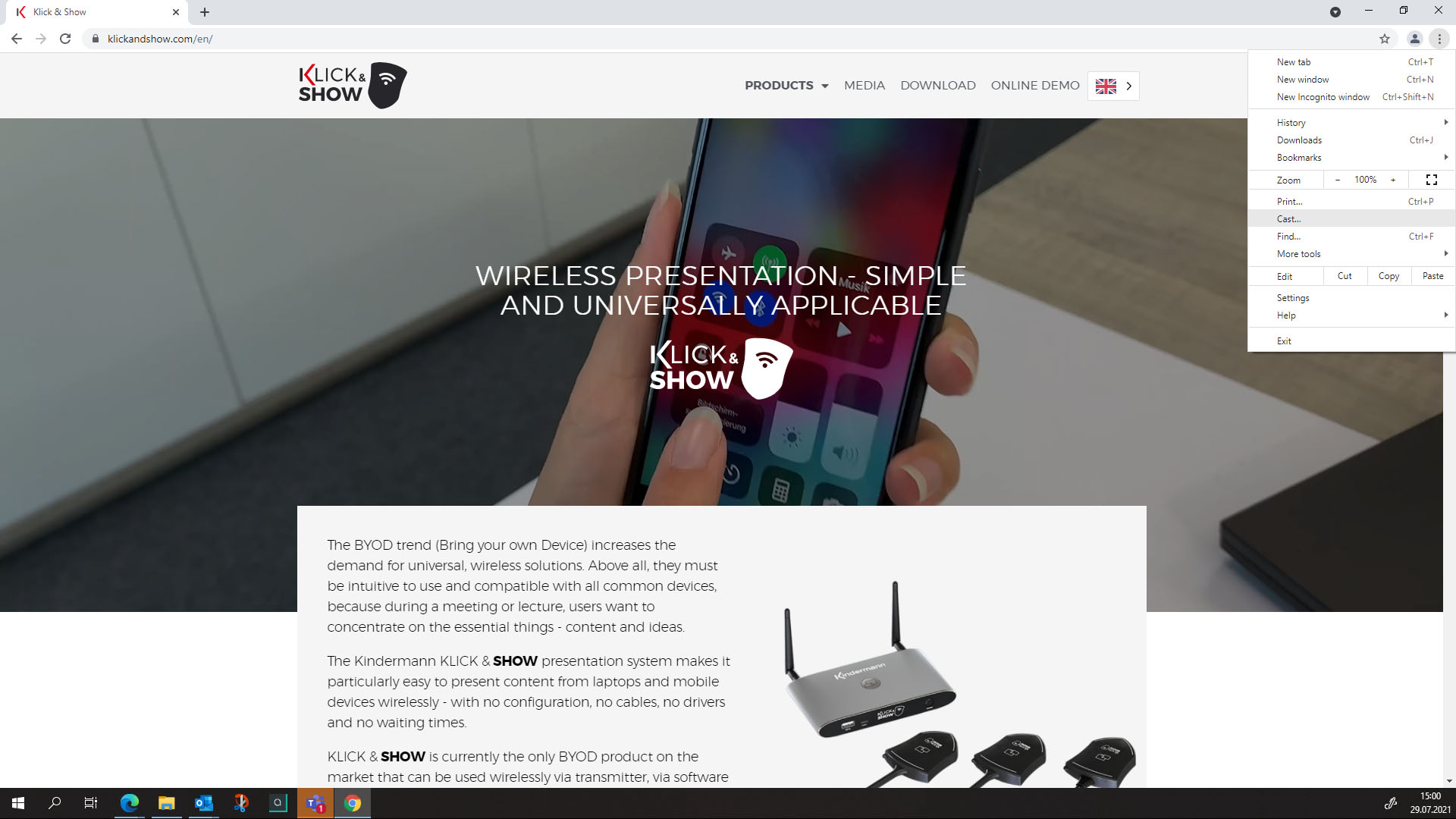
Open the Chrome browser and select top right ![]() > Stream. Then click Sources. Here you can decide which part of your screen they want to share. You can choose between the current browser tap, the entire screen or a file. The selection cannot be changed during an ongoing transfer. If you want to change the source, you must first stop the transfer, select the new source and start the transfer again.
> Stream. Then click Sources. Here you can decide which part of your screen they want to share. You can choose between the current browser tap, the entire screen or a file. The selection cannot be changed during an ongoing transfer. If you want to change the source, you must first stop the transfer, select the new source and start the transfer again.
Then select the Klick & Show from where you want to show the content.
To exit, select the same menu or icon ![]() and click Stop.
and click Stop.
7. Splitscreen, Moderation & Tools
Klick & Show offers in addition to the basic function of screen sharing other helpful tools that can support users in the presentation and contribute to a productive meeting.
7.1 Splitscreen
In certain situations, it can be useful to display more than one screen, e.B. to compare different ideas or to show additional information that is difficult to combine on one screen.
Supported for this Klick & Show the split-screen display of up to four sources simultaneously. You can select the number and display in the WebUI.
The split-screen function is automatically activated as soon as more than one device simultaneously drives the image transmission. The assignment of the positions is done automatically depending on the order of the presentation.
As soon as a fifth source wants to be displayed, it "pushes" the first one out of the picture.
![]() Hint:
Hint:
To switch its screen from split screen to full screen, you can press and hold the dongle for 2 seconds.
In the WirelessMedia 2 app for Android, the "Full Screen" button performs the same function.
Airplay and Miracast do not support this feature, so all other devices must separate so that these devices can present in full screen.
7.2 Moderation
![]() hint:
hint:
For the best possible user experience, we recommend using the following functions in conjunction with a touch display.
To enter the moderation menu, tap the arrow (1) that appears on the right side of the screen.
In the sidebar, all connected devices are displayed and can be brought to the presentation by the moderator. Whether a preview image is displayed depends on the setting or whether a transmitter is used.
The moderation function is not available for Airplay and Miracast due to technology.
![]() Note:
Note:
This feature can be disabled via the WebUI. In this case, no Pfleil or only a reduced menu is displayed, which allows access to the whiteboard and annotation function.
7.3 Whiteboard App
Tap the ![]() Icon to open the "Whiteboard App" with a blank page.
Icon to open the "Whiteboard App" with a blank page.
Select a tool from the following table.
| Toolbars #. | Tool Function |
|---|---|
| Toolbar 1 | |
| Toolbar 2 | the pen color can be selected by long tapping the color can be selected by long tapping (the previously created drawing is retained) |
| Toolbar 3 | Appears when the blackboard color, shapes, or pen are pressed and held. |
| Toolbar 4 file options | The files can be downloaded from the base via a web address or QR code. |
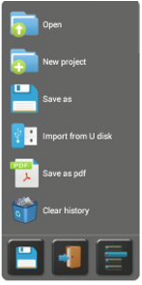 | Open: Open WMN file from local storage and continue editing project (Attention: depending on the security setting, the files are deleted regularly) New Project – Opens a new whiteboard file Save as: By entering a file name (as PNG and WMN, for further editing) The files can be downloaded from the base via a web address or QR code. Import from USB data carrier Save as PDF file The files can be downloaded from the base via a web address or QR code. Clear history: – all previously created whiteboards and annotations in temporary memory will be deleted. |
7.4 Annotation (notes)
In contrast to the whiteboard, the annotation function has no background, but works transparently on a "virtual layer" above the displayed video image. The original image remains unchanged.
Tap or click the icon ![]() to open the function.
to open the function.
The following tools are available.
| Toolbars #. | Tool Function |
|---|---|
| Toolbar1 | the pen color can be selected by long tapping the color can be selected by long tapping |
Saving Whiteboard/Annotation Files
![]() Hint:
Hint:
As soon as the last Wi-Fi connection to the Klick & Show For security reasons, the memory is automatically deleted so that subsequent users can no longer access the previously stored content.
You can configure this setting individually in the security settings of the WebUI.
When you save a file, you will be shown a QR code and a corresponding web address where the files can be downloaded.
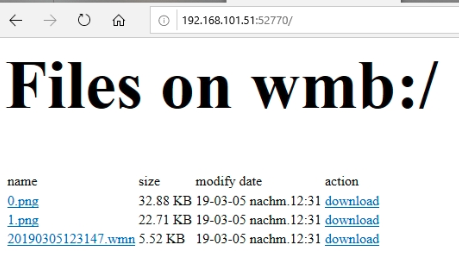
![]() Hint:
Hint:
To access the stored files, your computer or mobile device must be connected to the same (Wi-Fi) network with the Klick & Show condition.
The number after the colon is the network portthat must be shared to access the files.
You can copy the WMN file(s) to a USB memory and use the "Import from USB Disk" function in the Whiteboard app on the Klick & Show open again and continue editing.
8. Service functions
8.1 Coupling of transmitters (pairing)
When you purchase a set, the transmitters are paired ex works with the respective base and ready for use. However, as soon as you change the network configuration or if you purchase additional transmitters, for example, you will have to recoup them.
![]() Note: What does pairing mean?
Note: What does pairing mean?
The base and transmitter communicate with each other via WLAN. As with a computer or mobile device, the transmitter must know which WLAN network (SSID) it should connect to and which password it uses. This information is exchanged during pairing. A transmitter can only ever be attached to one Base to be coupled. The transmitter always connects to the last coupled base.
Plug the USB port of the transmitter into one of the USB sockets on the Klick & Show Base. The transmitter is automatically detected and the process is started.
If you see the success message on the screen, you can simply pull off the transmitter. Proceed accordingly with all other transmitters.
![]() hint:
hint:
As of version K1048, the firmware updates for the HDMI and USB-C transmitters can be transferred to the transmitters during use in the background.
For installations with multiple devices, we recommend using the ManageTool. This allows all transmitters at the workplace to be coupled to any base.
8.2 Firmware Update for Transmitters
We develop Klick & Show constantly to supplement new functions or to adapt to changing conditions in the IT environment. For this purpose, we provide regular firmware updates that are installed on the base.
In order to load the new firmware onto the transmitters, they must be plugged in there after updating the base.
The transmitter is automatically detected and the process is started.
If you see the success message on the screen, you can simply pull off the transmitter.
![]() hint:
hint:
As of version K1048, the firmware updates for the HDMI and USB-C transmitters can be transferred to the transmitters during use in the background.
For installations with multiple devices, we recommend using the ManageTool. This allows all transmitters at the workplace to be coupled to any base.
8.3 Delete older versions of WirelessMedia for Windows
If you still receive an error message when plugging the USB-A transmitter into a laptop, even though all programs have been updated, an older version is probably active on the computer.
The cleaning tool WindowsClear or MacClear can delete the traces of the old version. Run this file and start the current version of the starter program.
8.4 Restore factory settings (Reset)
A hardwarereset is triggered by pressing the reset button on the Klick & Show Base. Alternatively, you can also initiate it via the administration interface. Both paths lead to the same result.
![]() hint:
hint:
You can save the current configuration and read it back in after the reset.
- Turn on the base device.
- Once the home screen is visible, press the Reset button with a pointed object, e.B a bent paper clip. Press and hold the button for at least 2 seconds until this"Factory Reset" message appears. Klick & Show will restart after another 3 seconds with the factory settings.
- If you have no display connected, hold down the reset button until the LED display on the top lights up red to perform the reset.
![]() Note:
Note:
All settings are lost and Klick & Show needs to be re-set up.
After resetting to factory settings, all transmitters must be paired (paired) again with the base device.
9. Introduction to Network Configuration
9.1 Basic rules for WLAN
So that devices do not interfere with each other, the "WLAN hygiene" is essential, i.e. You must ensure that only one access point is sent on the WLAN channel or on the neighbouring channels. There are various professional WLAN scanners and measuring devices for a first overview, but free apps such as the Wifi Analyser also help.
Difference between 2.4 GHz and 5 GHz frequency band
For the use of WLAN, two frequency bands are available worldwide. Both offer different advantages and disadvantages.
- 2.4 GHz
- Oldest standard – compatible with any device with WI-FI
- Due to technical reasons, longer range or better penetration
- Fewer, heavily frequented channels
- Less bandwidth
- 5 GHz
- More or less busy channels
- More fire width
- Due to technology, short range and poorer penetration
- Compatible with modern, WLAN-enabled devices
![]() hint:
hint:
We recommend using the channel in the 5 GHz band.
To achieve the best transmission quality, we recommend a "line of sight" between the Klick & Show Base and the transmitter or mobile device, so that the radio transmission can take place unhindered. Avoid proximity to objects made of metal or other dense materials.
In difficult installations, it may make sense to install the antennas with an extension in a better place for reception, e.B. outside a technical rack.
To offer all the possibilities of Klick & Show should be able to use it, Klick & Show be properly integrated into the existing corporate or campus network structure.
This is all the more recommendable if several clicks & shows are to be installed in a small space, e.B. in neighboring rooms.
In this case, the number of available network channels can quickly become scarce and the quality and user experience can suffer due to the overlapping of the signals.
In such a usage scenario, we recommend the WLAN of the Klick & Show Base and integrate it into the central network infrastructure. Thus, many individual WLAN networks can be concentrated into a single or a few.
In this context, please remember to provide sufficient bandwidth and prioritization in the network. You can expect a data rate of up to 4 Mbit/s per active stream.
9.2. Access Point Mode (Basic Configuration)
Starts during the first start-up or after the factory reset Klick & Show in the standard configuration Access Point mode,in which the base unit broadcasts its own WLAN access point to which all transmitters, computers and mobile devices can connect. This is a useful scenario for a quick, spontaneous setup or temporary installation.
In this configuration, the Klick & Show additionally wired (CAT cable) connected to a network. Depending on the configuration, this network connection is forwarded internally (bridging) and is thus also available to users who are directly connected to the Klick & Show Connect access point.
The icon ![]() for "connected network (LAN + WLAN)" is displayed on the home screen.
for "connected network (LAN + WLAN)" is displayed on the home screen.
![]() hint:
hint:
It depends on the configuration of the wired network whether only internet access or complete access to the company and/or campus network via WLAN is available in this way. Please contact your network administrator.
You can also operate both network accesses separately, then this is Klick & Show still accessible from the wired network. Devices connected to Wi-Fi cannot communicate with those on the wired network and vice versa.
The icon ![]() for "separate networks (LAN + WLAN)" is displayed on the home screen.
for "separate networks (LAN + WLAN)" is displayed on the home screen.
For example, a separation between guest and company network can be realized. Guests and transmitters connect directly to the Wi-Fi of the Klick & Show Basis, where employees use the internal network infrastructure and thus retain their access to network drives, etc.
9.3 Infrastructure modes
The infrastructure modes allow Klick & Show into a structured network. This can be done via WLAN or cable. In both cases, the access point function is deactivated and no longer sends its own network.
![]() hint:
hint:
We recommend the use of infrastructure modes if the following criteria are met:
1. Existing, powerful, administered WLAN network
2. Client devices are operated and administered over the same network
3. Use of many clicks & shows (in the immediate vicinity)
4. Permanent installation of Klick & Show
Please coordinate details as well as the necessary access permissions and port shares in advance with the responsible network administrator.
9.3.1 Wireless Infrastructure Mode
In wireless infrastructure mode, the base connects to an existing access point via WLAN. The communication of the transmitters and the software clients must also take place over this network. By pairing, the transmitters receive the necessary connection information to connect to the network.
9.3.2 LAN infrastructure mode
In LAN infrastructure mode, the base is connected to a network via network cable. The communication of the transmitters and the software clients must also take place over this network. Prerequisite for the use of the transmitters is a WLAN network that is connected to the wired network. By pairing, the transmitters receive the necessary information to connect to it.
10. WebUI
10.1 Home – Software Download
The Klick & Show K-40 Series has an extensive user interface, hereinafter referred to as WebUI, which can be accessed via browser.
![]() hint:
hint:
The WebUI can be called up in the browser by entering the IP address, which is displayed on the home screen in the information area.
On the "home page", which is accessible to all, users can download the latest software and access the online help.
Integrators or the internal IT department can enter the contact details of the user helpdesk here. In the delivery state and as a default setting, the contact details of Kindermann registered.
10.2 Go to the administration menu
Call up the WebUI of the respective Click & Shows via its IP address in the browser. A click on the gear icon ![]() at the top right, the login window calls up. Enter the registration password here.
at the top right, the login window calls up. Enter the registration password here.
The default password on delivery or after a reset is "admin".
![]() hint:
hint:
You can change the admin password or deactivate the password query in the menu item Security Settings. If you forget the password, you must reset the base to factory settings via reset.
After logging in, you have access to all configuration options of the system.
11. Klick & Show configure
11.1 Network settings
11.1.1 Access Point Mode
![]() hint:
hint:
Changes to the network configuration can only be made via a wired network connection!
In the menu Network Settings -> WLAN configuration, select the button "Edit" to set up the WLAN connection.
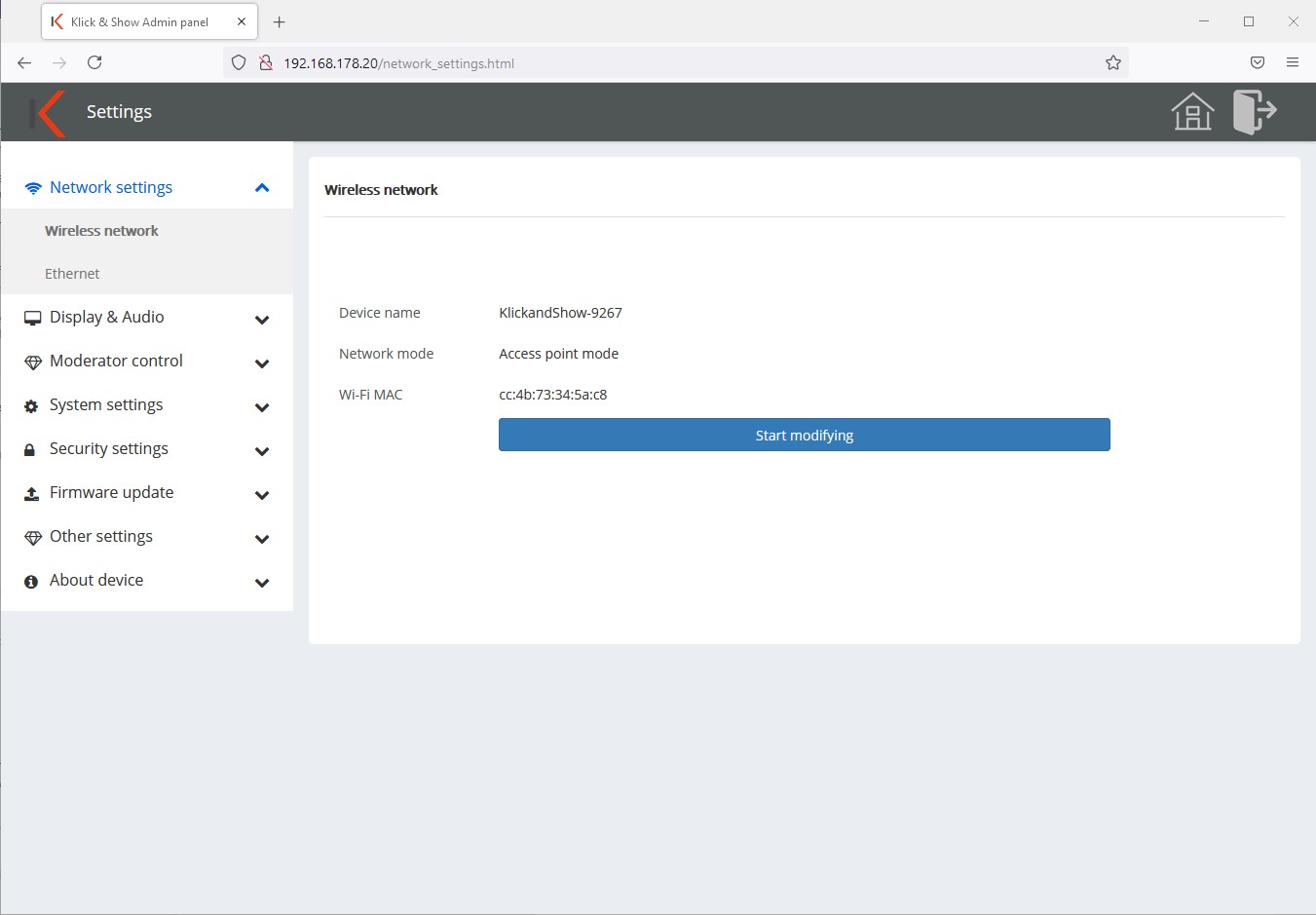
Step 1:
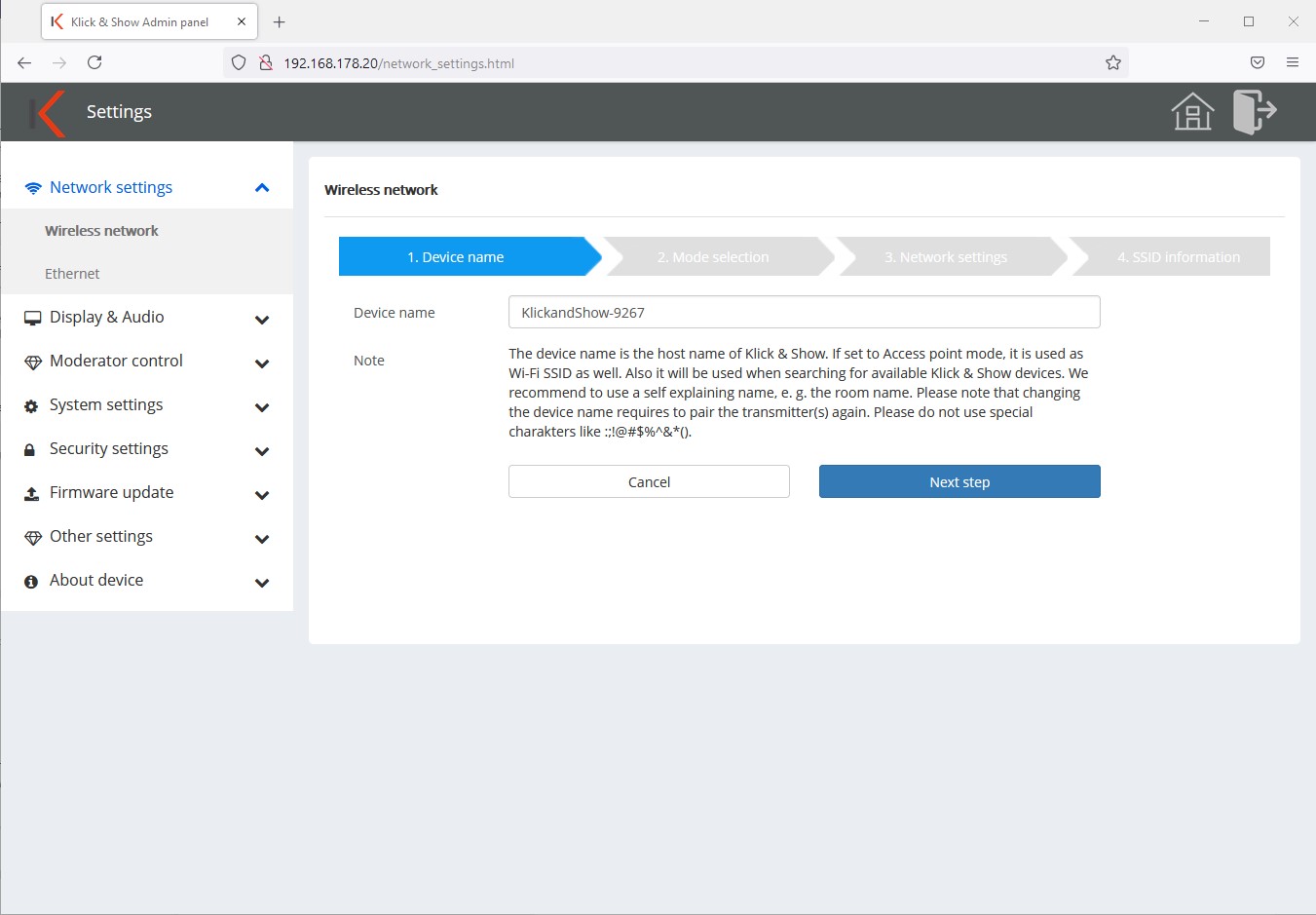
Now you can set the device name of your Klick & Show Change base. We recommend using a name that speaks for itself, e.B. based on the room name. The default name is KlickandShow-xxxx.
In Access Point Mode, the device name is also the WLAN id (SSID)!
![]() hint:
hint:
The name can only contain letters "a-z", "A-Z", digits "0-9" and the characters "-_". National special characters can lead to problems e.B. with Apple AirPlay.
Step 2:

In the next step, select the network operating mode "Access Point Mode", so that works Klick & Show as an access point. Transmitters and mobile devices connect directly to the Klick & Show Base.
![]() hint:
hint:
An explanation of the different modes can be found in Chapter 9. The two infrastructure modes are described in the following chapters.
Step 3:
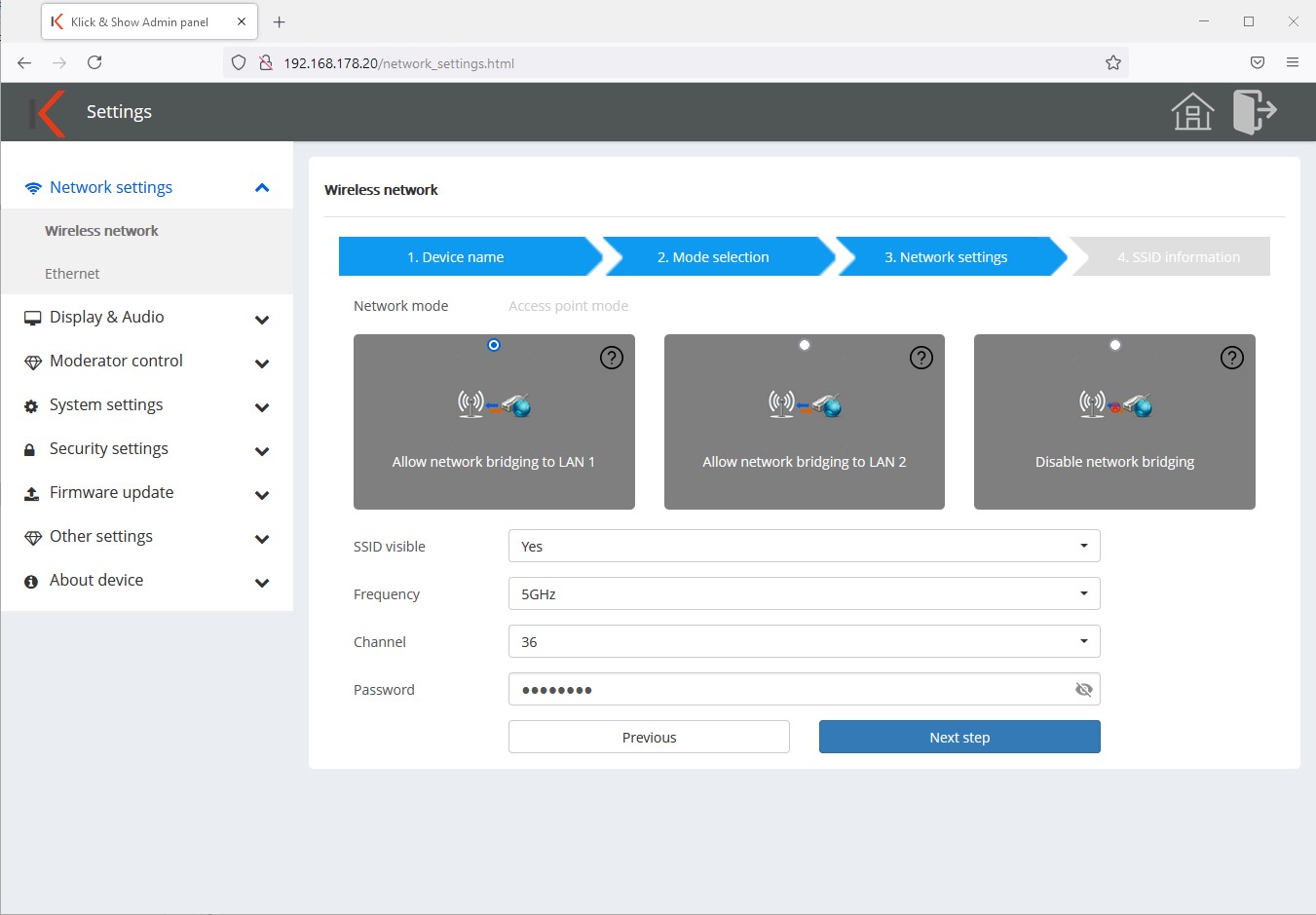
In step 3, you perform the actual network configuration. Select whether the wired network connection on LAN port 1 or 2 should be accessible via the access point via WLAN (bridging) or not.
Furthermore, you can carry out the WLAN configuration of the access point at this point.
- Show SSID: Yes/No
The default is Yes. If you select "No", the Wi-Fi network ID is hidden, i.e. it is not displayed in the list of available networks. However, if you know the SSID, you can manually connect to the Wi-Fi network. - Frequency band: 2.4 or 5 GHz
- Channel: Choose a free Wi-Fi channel
- Password: The WLAN password is automatically assigned in the standard configuration and updated at specified intervals, so the field can remain empty.
If you want to work with your own permanent password, you have the option to assign one at this point.
In this case, the change interval must also be defined as "Never"!
Step 4:
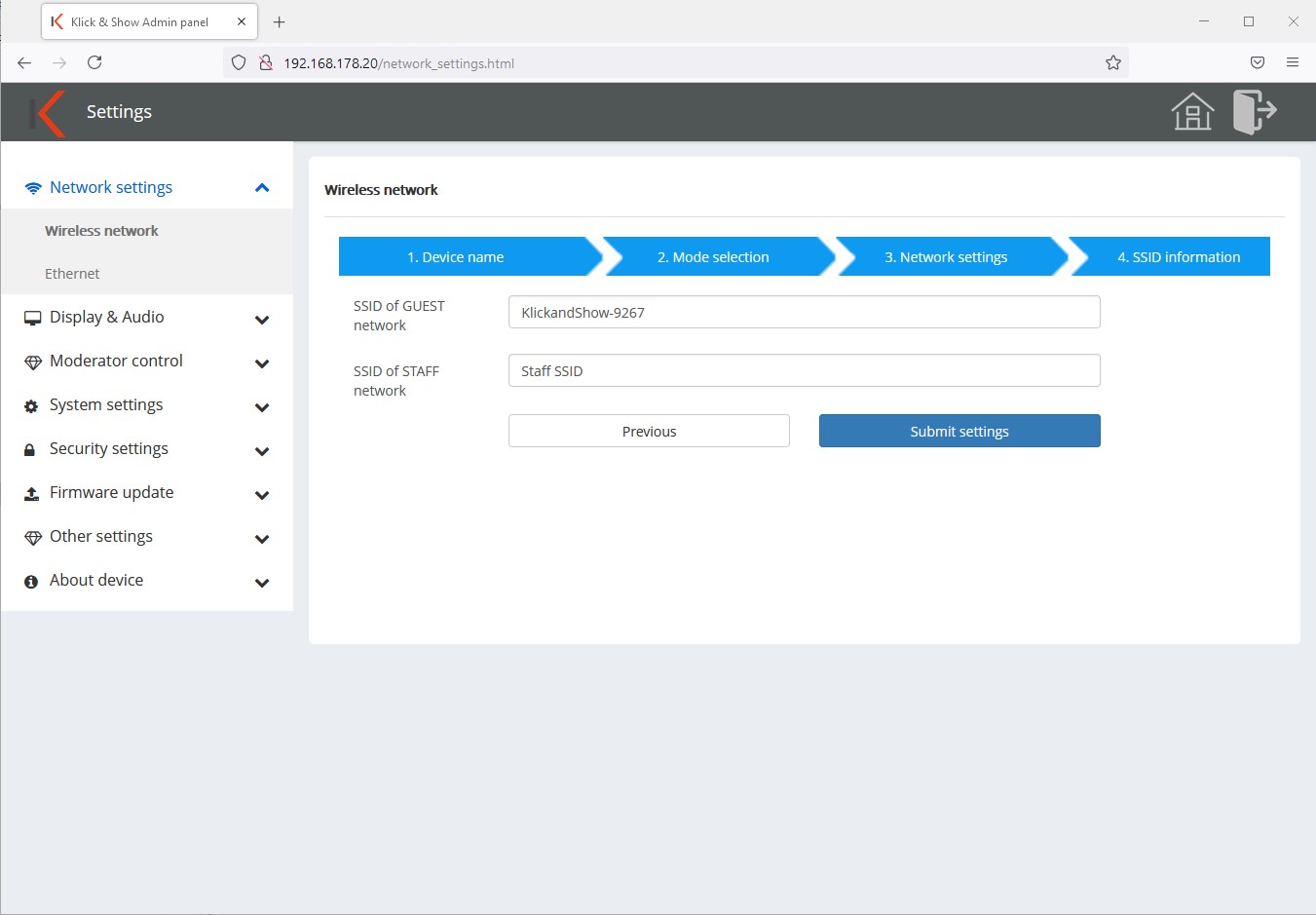
At this point you can manually enter the WLAN SSID information for a guest or company or campus network. These are displayed on the home screen (3 and 4).

![]() hint:
hint:
This is a pure information field. You do not make any network configurations at this point.
Step 5:
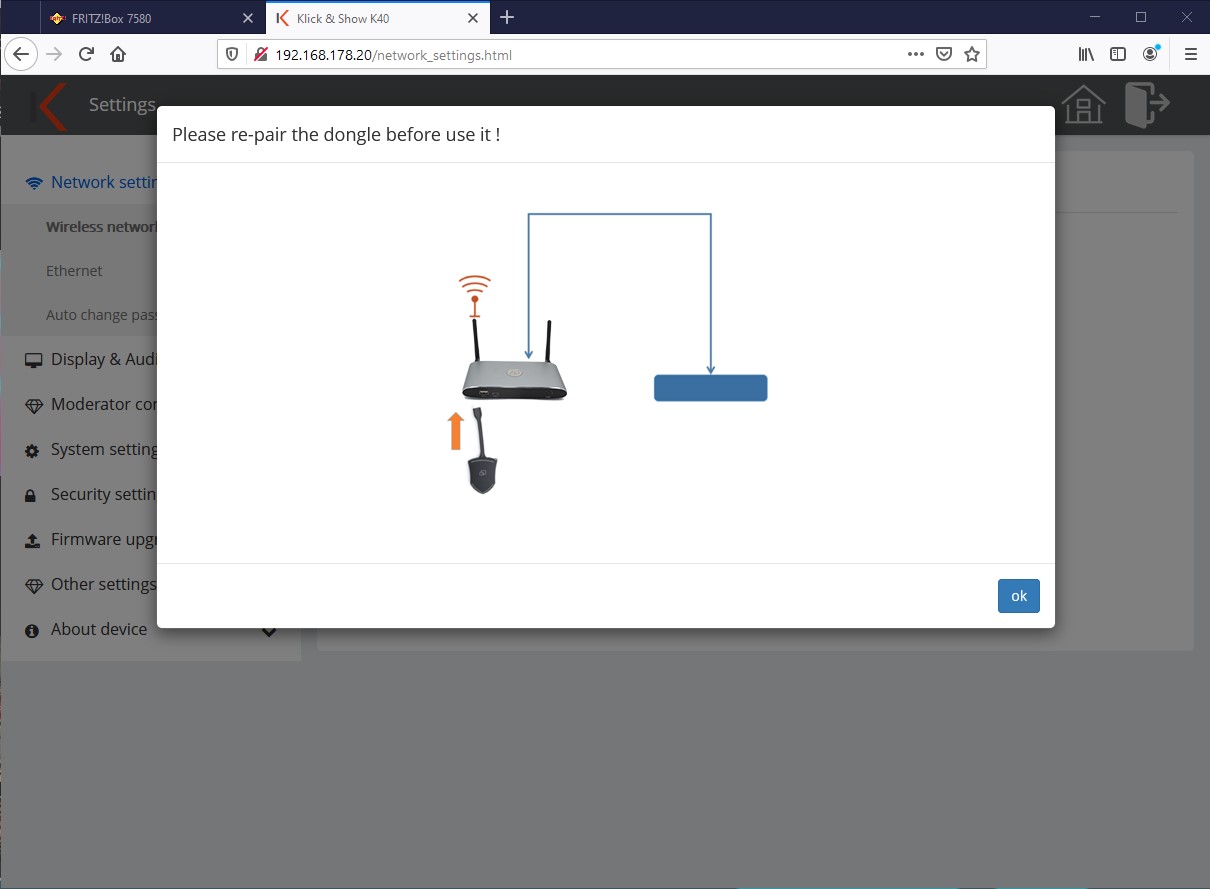
Finally, you will be reminded to recoup (pair) the dongles after the changes to the network configuration.
11.1.2 Wireless Infrastructure Mode
In this operating mode, the Klick & Show System integrated into an existing WLAN network.
![]() hint:
hint:
Changes to the network configuration can only be made via a wired network connection!
In the menu Network Settings -> WLAN configuration, select the button "Edit" to set up the WLAN connection.
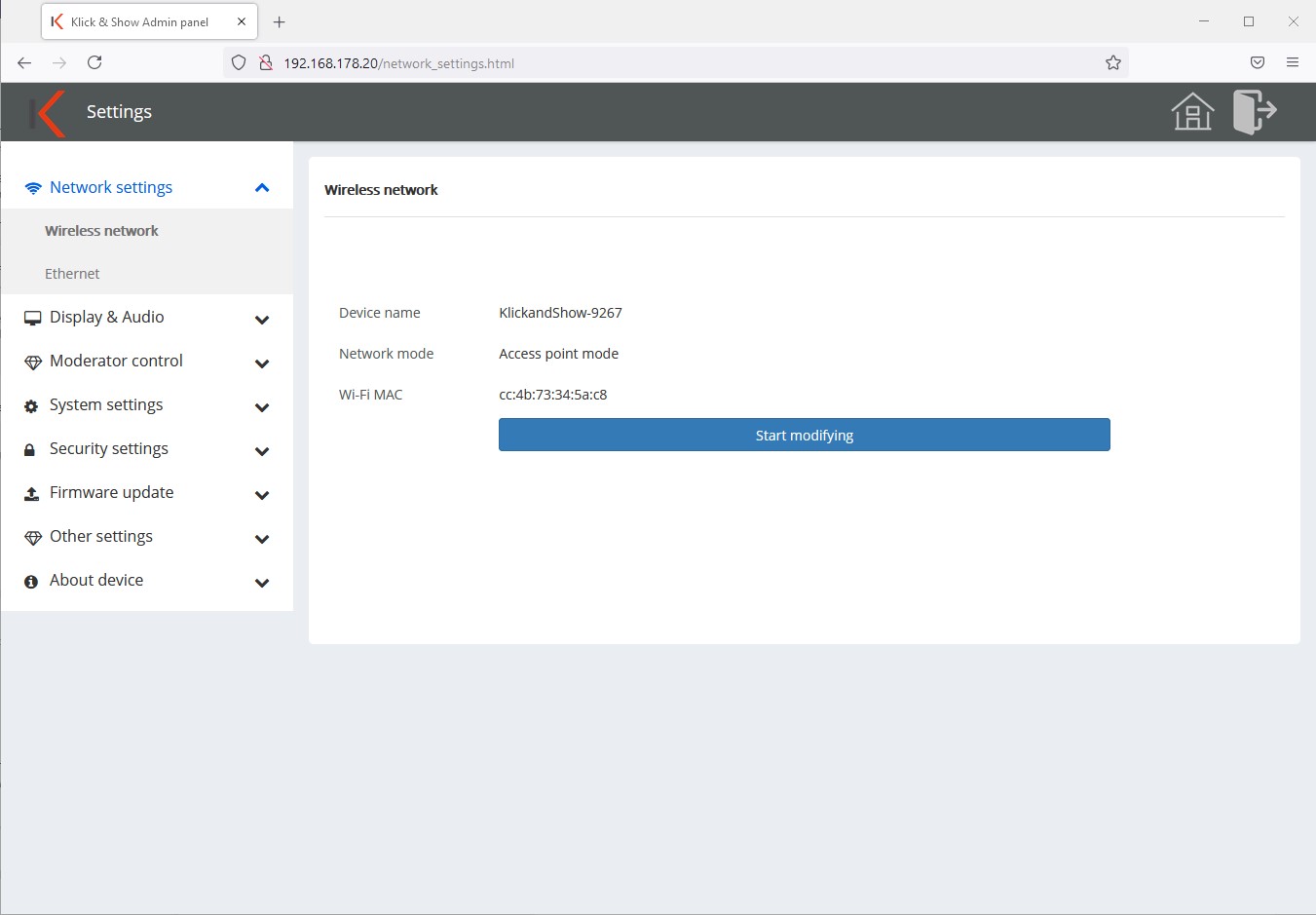
Step 1:

Now you can set the device name of your Klick & Show Change base. We recommend using a name that speaks for itself, e.B. based on the room name. The default name is KlickandShow-xxxx.
The device name is displayed both on the home screen and in the list of available clicks & shows on a network, e.B. in the WirelessMedia Software Client.
Step 2:
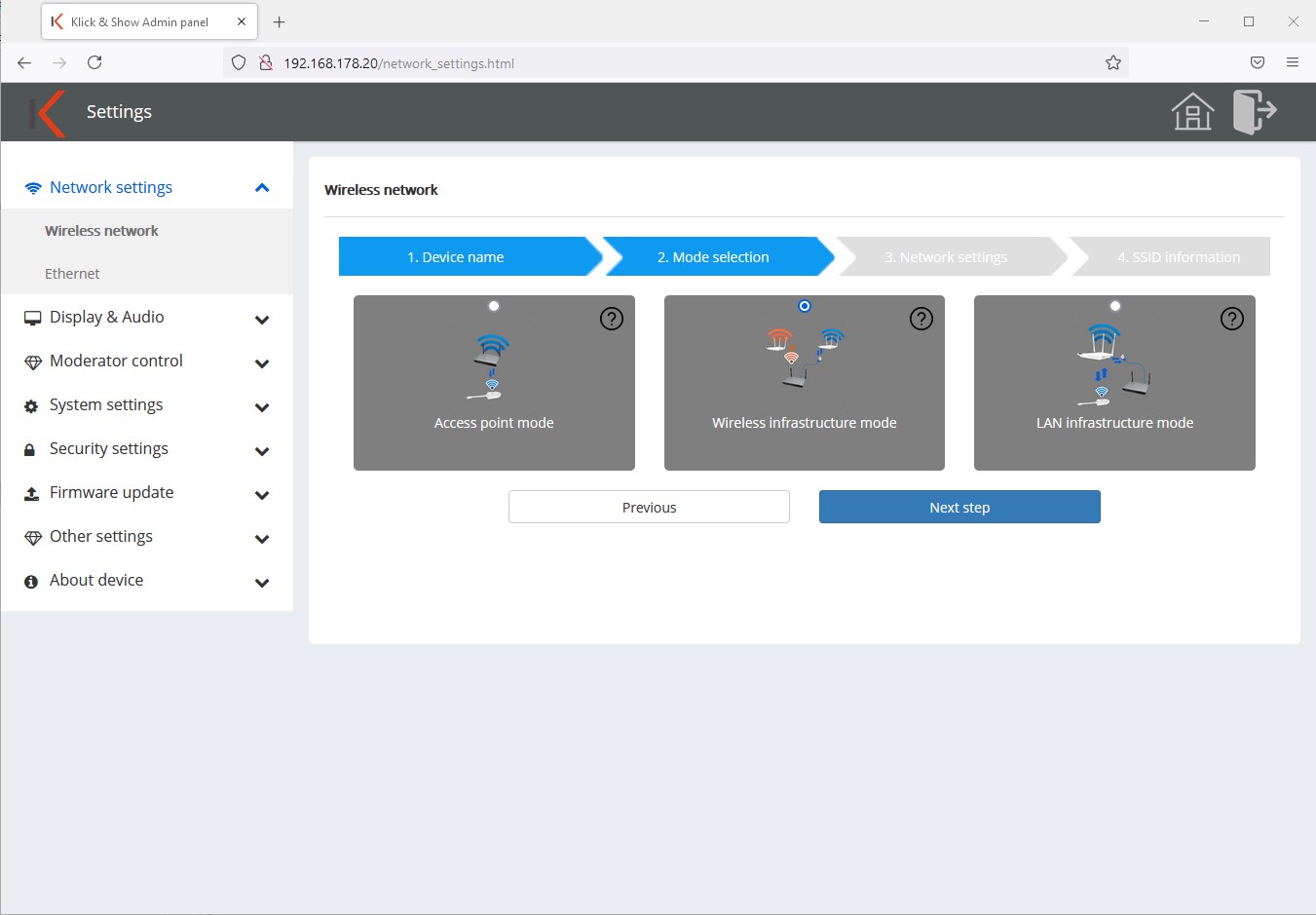
In the next step, select the network operating mode "Wireless Infrastructure Mode".
![]() hint:
hint:
An explanation of the different modes can be found in Chapter 9. The two infrastructure modes are described in the following chapters.
Step 3:
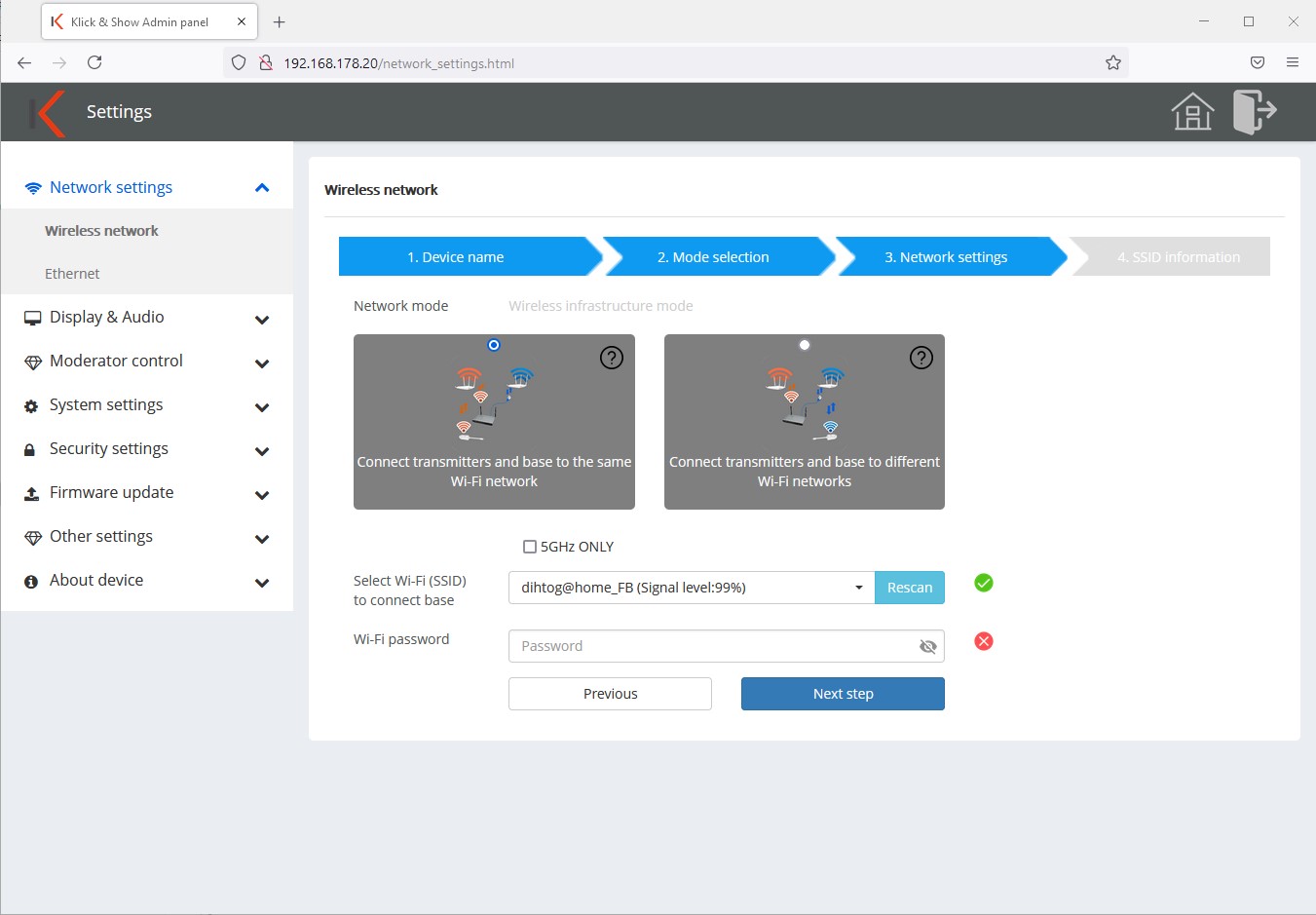
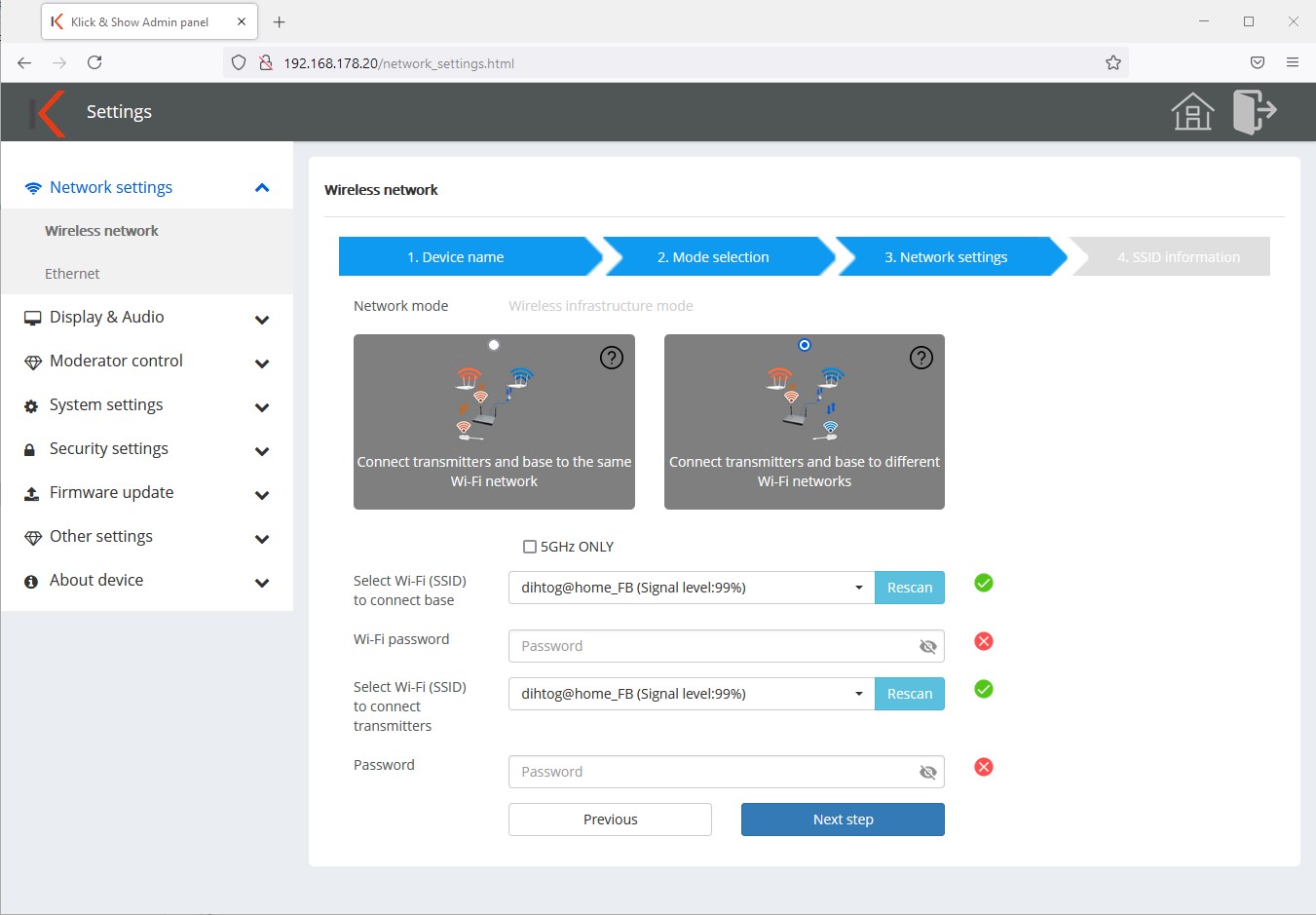
In step 3 you choose whether the transmitters should be connected to the same WLAN network as the Klick & Shows basis (recommended) or whether you want to use separate WLAN networks (Requires an appropriate network configuration).
Select one of the two options.
Decide whether you want to use the Klick & Show with a 2.4 or 5 GHz WLAN network. Depending on this, please activate or deactivate the checkbox "ONLY 5GHz".
Now select the SSID from the list of found networks in which you Klick & Show and enter the WLAN password in the field below. Klick & Show will try to log in to the WLAN immediately after entering the password. The status icon gives you feedback whether the registration was successful or not.
![]() hint:
hint:
If the desired SSID does not appear in the list of found networks, repeat the scan operation or verify that you have selected the correct frequency range.
When choosing, make sure that the level is as high as possible to ensure a stable and high-performance connection.
Step 4:

At this point you can manually enter the WLAN SSID information for a guest or company or campus network. These are displayed on the home screen (3 and 4).

![]() hint:
hint:
This is a pure information field. You do not make any network configurations at this point.
Step 5:
Finally, you will be reminded to recoup (pair) the dongles after the changes to the network configuration.
11.1.3 LAN infrastructure mode
In this operating mode, the Klick & Show Connected to a structured network via a wired network connection (LAN). Configuring the Ethernet settings can be found in the next chapter 11.1.4.
![]() hint:
hint:
Changes to the network configuration can only be made via a wired network connection!
In the menu Network Settings -> WLAN configuration, select the button "Edit".
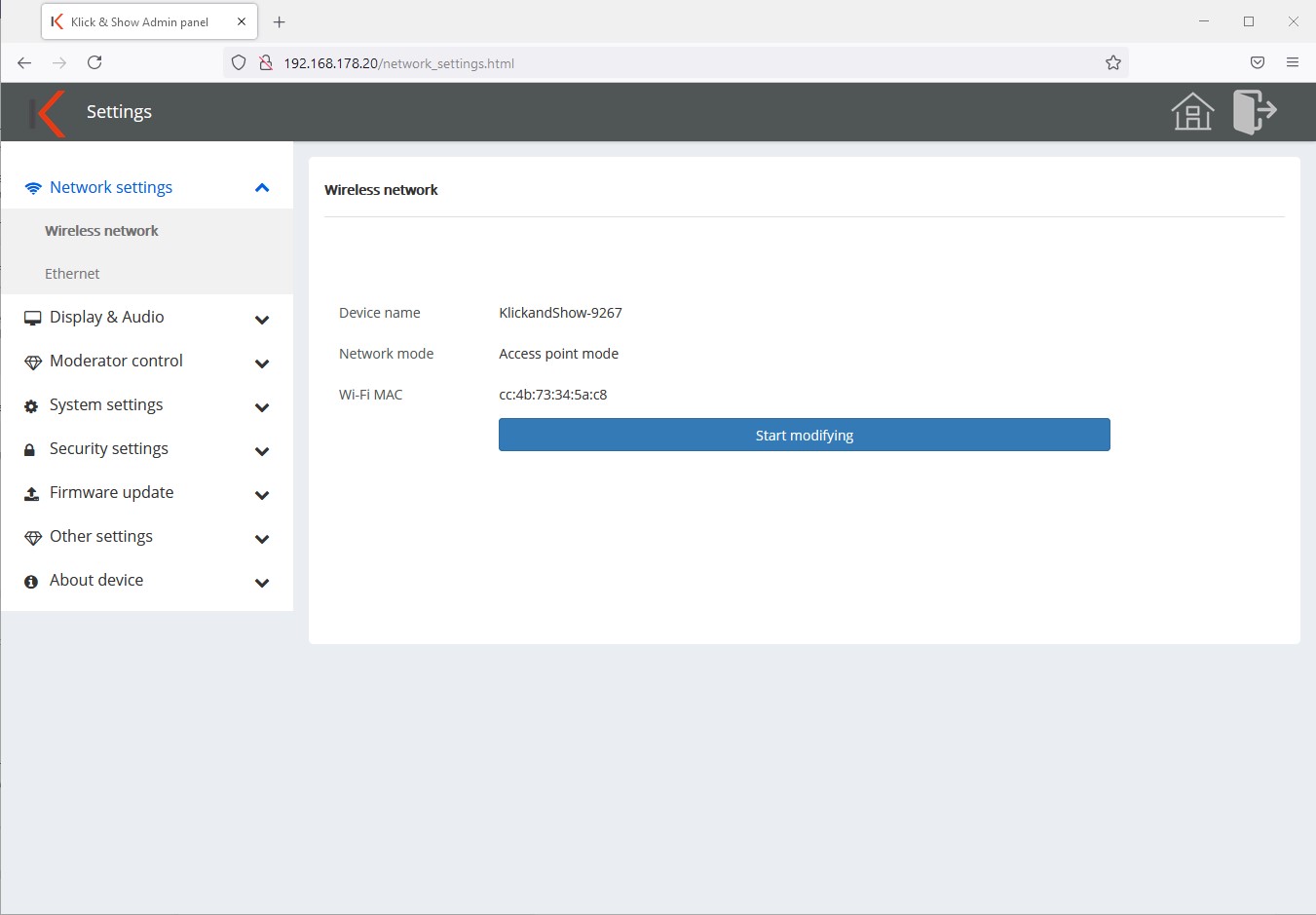
Step 1:
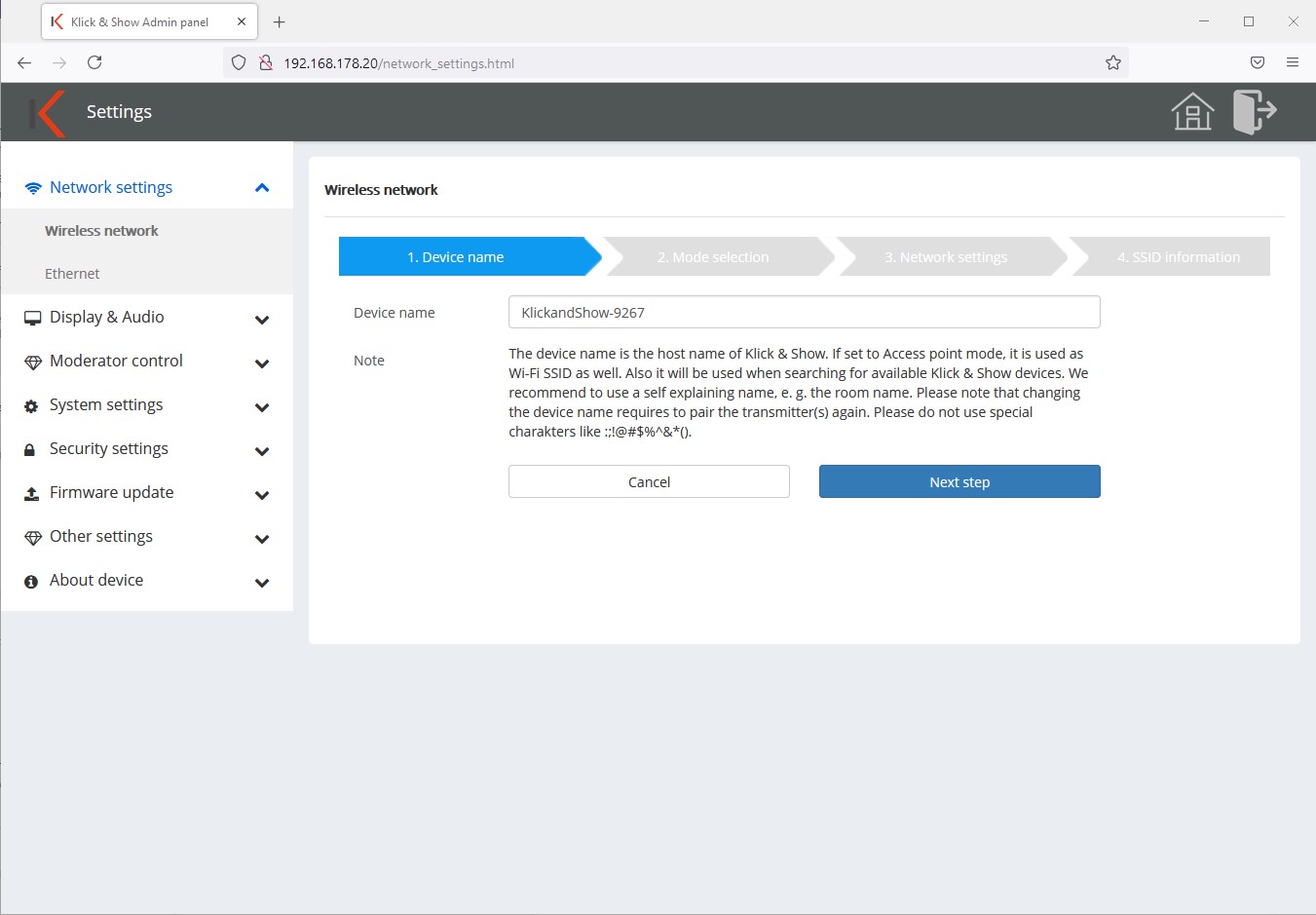
Now you can set the device name of your Klick & Show Change base. We recommend using a name that speaks for itself, e.B. based on the room name. The default name is KlickandShow-xxxx.
The device name is displayed both on the home screen and in the list of available clicks & shows on a network, e.B. in the WirelessMedia Software Client.
Step 2:
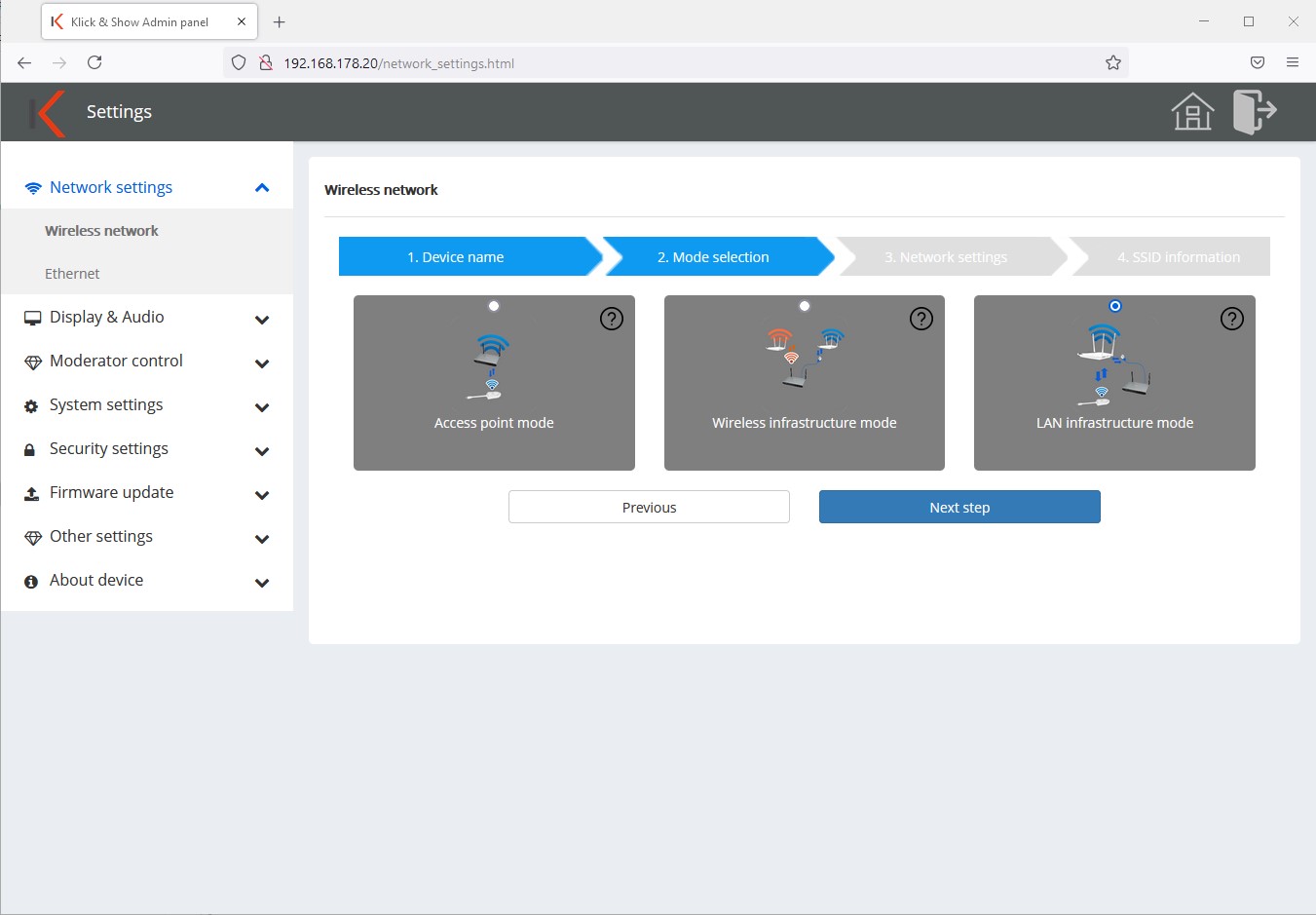
In the next step, select the operating mode "LAN Infrastructure Mode".
![]() hint:
hint:
An explanation of the different modes can be found in Chapter 9. The two infrastructure modes are described in the following chapters.
Step 3:
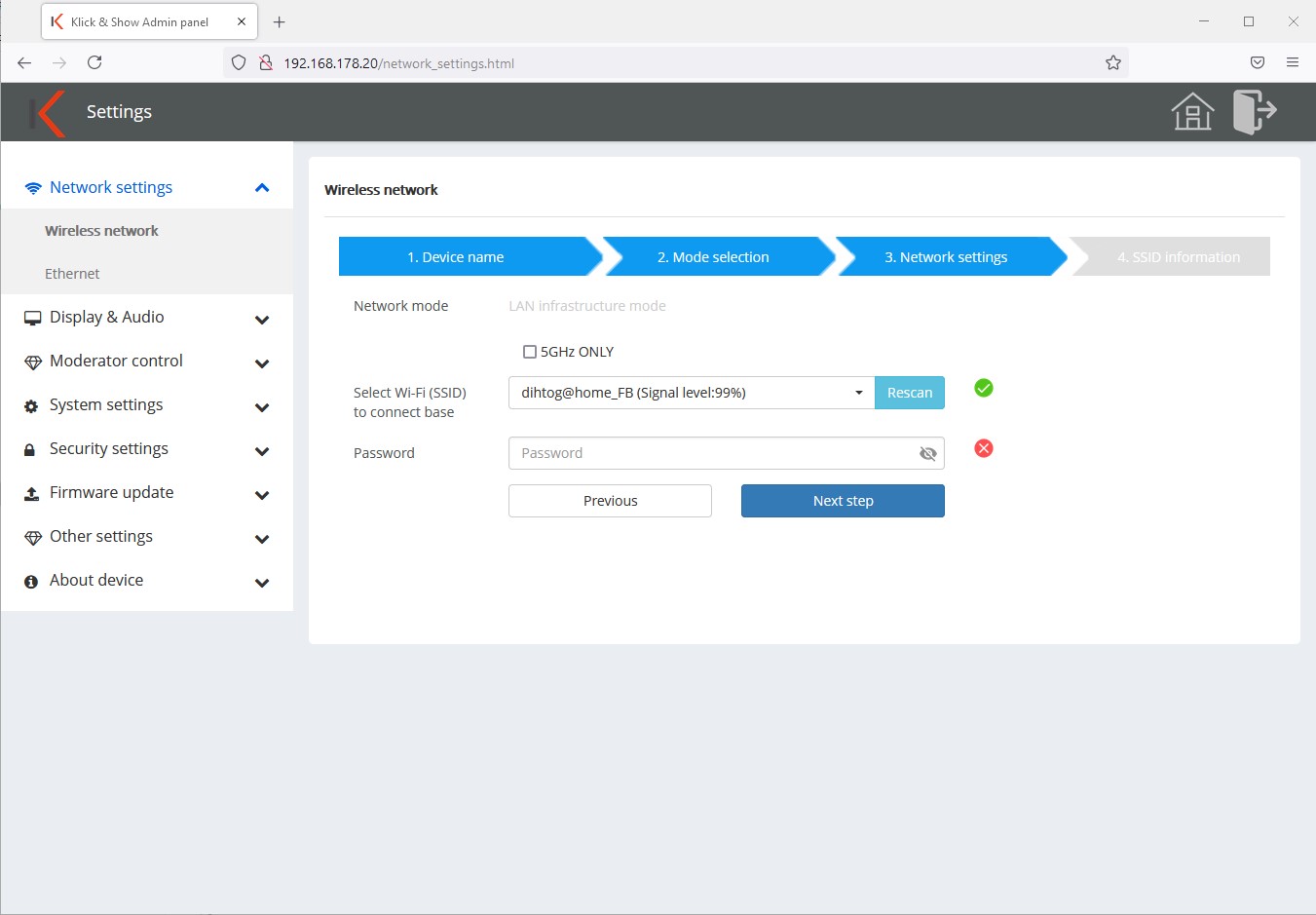
![]() Hint:
Hint:
In LAN infrastructure mode, the internal WLAN access point is switched off. In order to be able to use the transmitters anyway, they must connect to a WLAN network via which a communication with the Klick & Show is possible. You can select this network at this point. The access data is transmitted to the transmitters by pairing.
Decide whether you want to use the Klick & Show with a 2.4 or 5 GHz WLAN network. Depending on this, please activate or deactivate the checkbox "ONLY 5 GHz".
Now select the SSID from the list of found networks in which you Klick & Show Transmitter and enter the WLAN password in the field below. Klick & Show will try to log in to the WLAN immediately after entering the password. The status icon gives you feedback whether the registration was successful or not.
![]() hint:
hint:
If the desired SSID does not appear in the list of found networks, repeat the scan operation or verify that you have selected the correct frequency range.
When selecting, make sure that the displayed level is as high as possible to ensure a stable and high-performance connection.
Step 4:
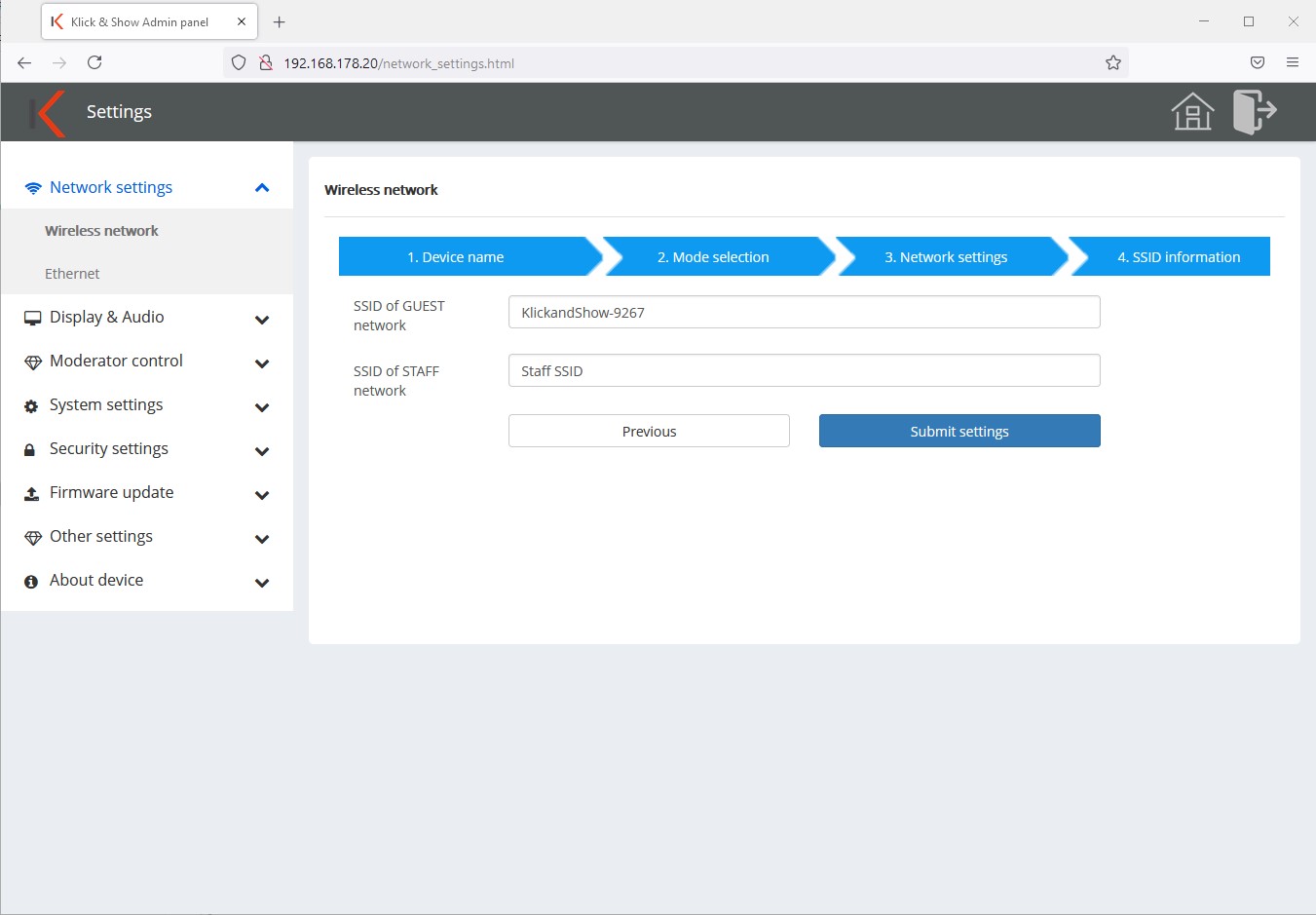
At this point you can manually enter the WLAN SSID information for a guest or company or campus network. These are displayed on the home screen (3 and 4).

![]() hint:
hint:
This is a pure information field. You do not make any network configurations at this point.
Step 5:
Finally, you will be reminded to recoup (pair) the dongles after the changes to the network configuration.
11.1.4 Network – Ethernet
From the Network Settings menu, select -> Ethernet
![]() Hint:
Hint:
Klick & Show has two LAN ports. These are separate, so both LAN networks remain segmented.
LAN2 also supports the power supply of the device via PoE and is Gigabit capable. Thus, the Klick & Show e.B be connected to an in-house network and a guest network without establishing a direct connection between the two networks.
To configure, select the tab for the desired LAN port:
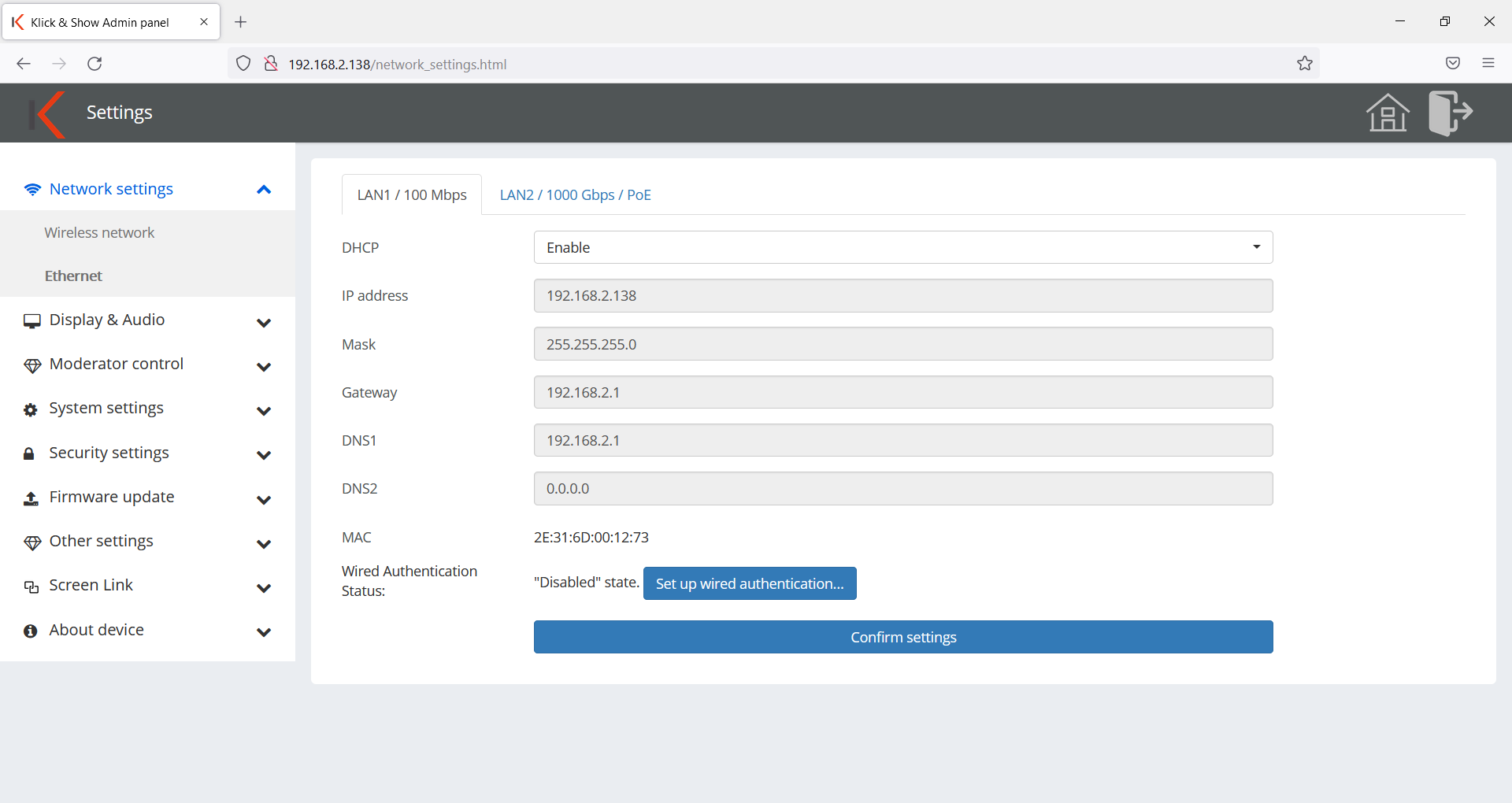
Proxy & IP Settings
- DHCP (Enable): Klick & Show receives its IP address dynamically from a DHCP server on the network.
If DHCP has been enabled, the following points cannot/must not be configured.
DHCP (Disable): Klick & Show is manually assigned a fixed IP address. A static IP can facilitate administration and increase reliability. - IP address: Enter the IP address that the Klick & Show should be accessible in the network.
- Mask: Enter the network filter mask here.
- Gateway: Enter the IP address of the gateway here – if necessary.
- DNS1: Enter the primary DNS server.
- DNS2:Enter secondary DNS server (optional).
- MAC: Displays the MAC address of the LAN port. This cannot be changed.
To save the settings you have made, click on "Confirm Settings".
The second LAN port can be configured separately according to the above pattern and has its own MAC address.
Set up wired authentication
Optionally, wired authentication can be set up according to IEEE standard 802.1X. The IEEE standard 802.1X is a particularly secure method for individual access control to local networks. The standard uses the Extensible Authentication Protocol (EAP) to exchange authentication information. Central authentication and user management is carried out via RADIUS server (Remote Authentication Dial-In User Service).
Klick & Show currently supports the following EAP authentication types:
• EAP-TLS (Transport Layer Security)
• EAP-TTLS (EAP Tunneled Transport Layer Security)
• PEAP (Protected Extensible Authentication Protocol)
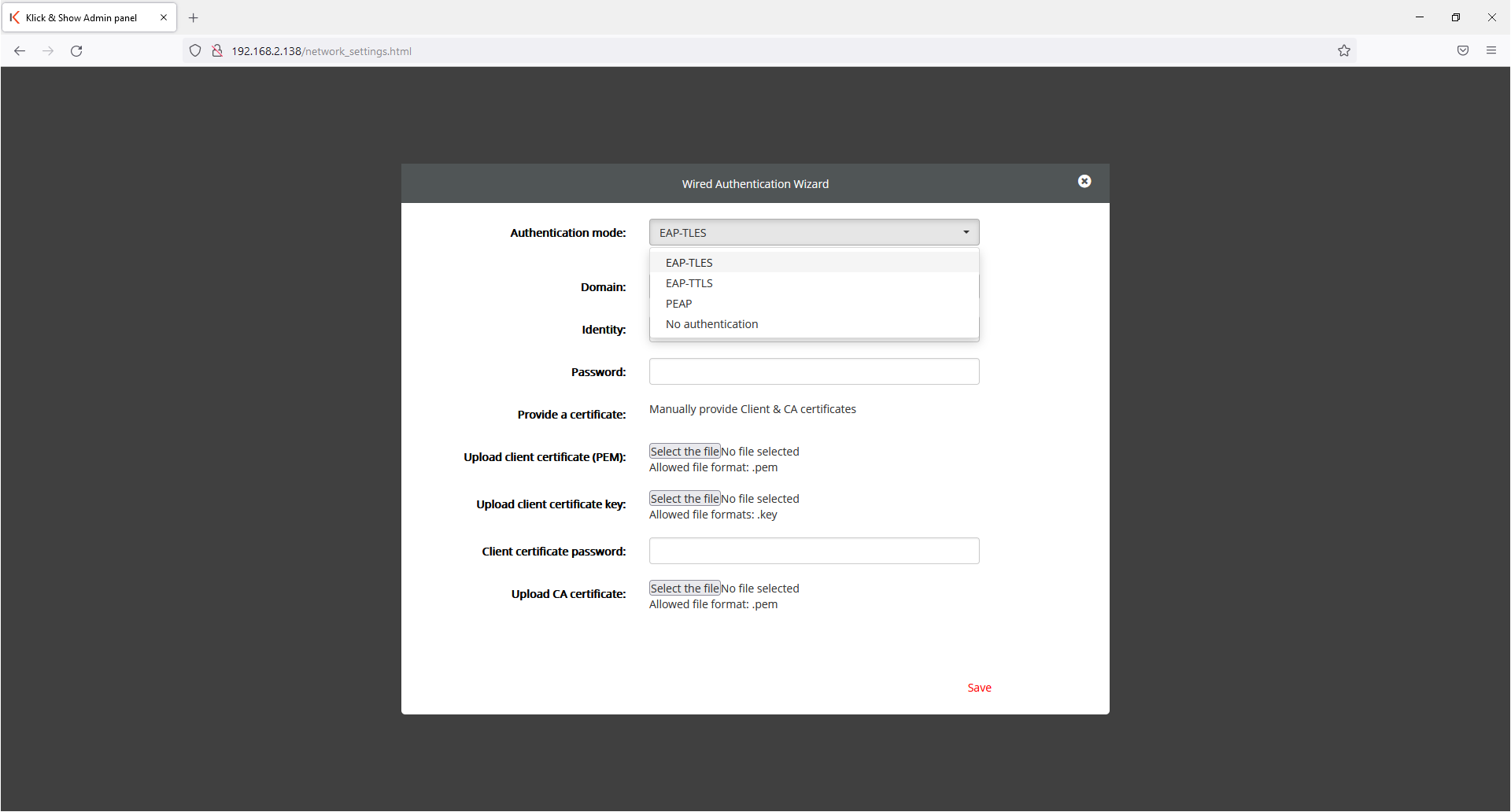
A wizard guides you through entering the required parameters:
Authentication: Selection of EAP-TLS, EAP-TTLS, PEAP and "No authentication"
Domain: Enter the domain listed in the server certificate here
Identity: Enter the "Identity" (e-mail address) associated with the user profile
Password: Enter the password assigned to this user profile here.
For EAP-TLS only, the following section is relevant:
Deploy certificate: Manually deploy client and CA certificates
Upload client certificate (PEM): Provide the client certificate in PEM format here
Upload client certificate key: Provide the certificate key of the client certificate here
Client Certificate Password: Enter the password associated with the client certificate here
Upload CA certificate: Provide the CA certificate here
11.2 Display & Audio
11.2.1 HDMI resolution
Select the resolution and refresh rate that the Klick & Show on its HDMI output.
For the Auto setting, read Klick & Show select the EDID information of the playback device (e.B display) and select the best available setting. If you are not satisfied with the image quality, you can choose a suitable one from the list of available resolutions.

![]() hint:
hint:
If the newly selected resolution cannot be displayed, the previously active resolution is displayed again after approx. 15 s.
11.2.2 HDMI CEC
CEC is the Consumer Electronics Control (protocol) standardized by the HDMI organization. Klick & Show supports the command sets for power on and off. If your playback device (e.B display) is also compatible with this, you can turn the display or the display on and off Klick & Show Automate the basis.
If you activate the "Display" option, the Klick & Show the display is automatically on or off.
If you activate the "Basic" option, the display controls the stand-by state of the Klick & Show Base.
Both options can also be activated.

11.2.3 Audio output
The audio output can be done either via the analog jack output and/or via the digital HDMI output.
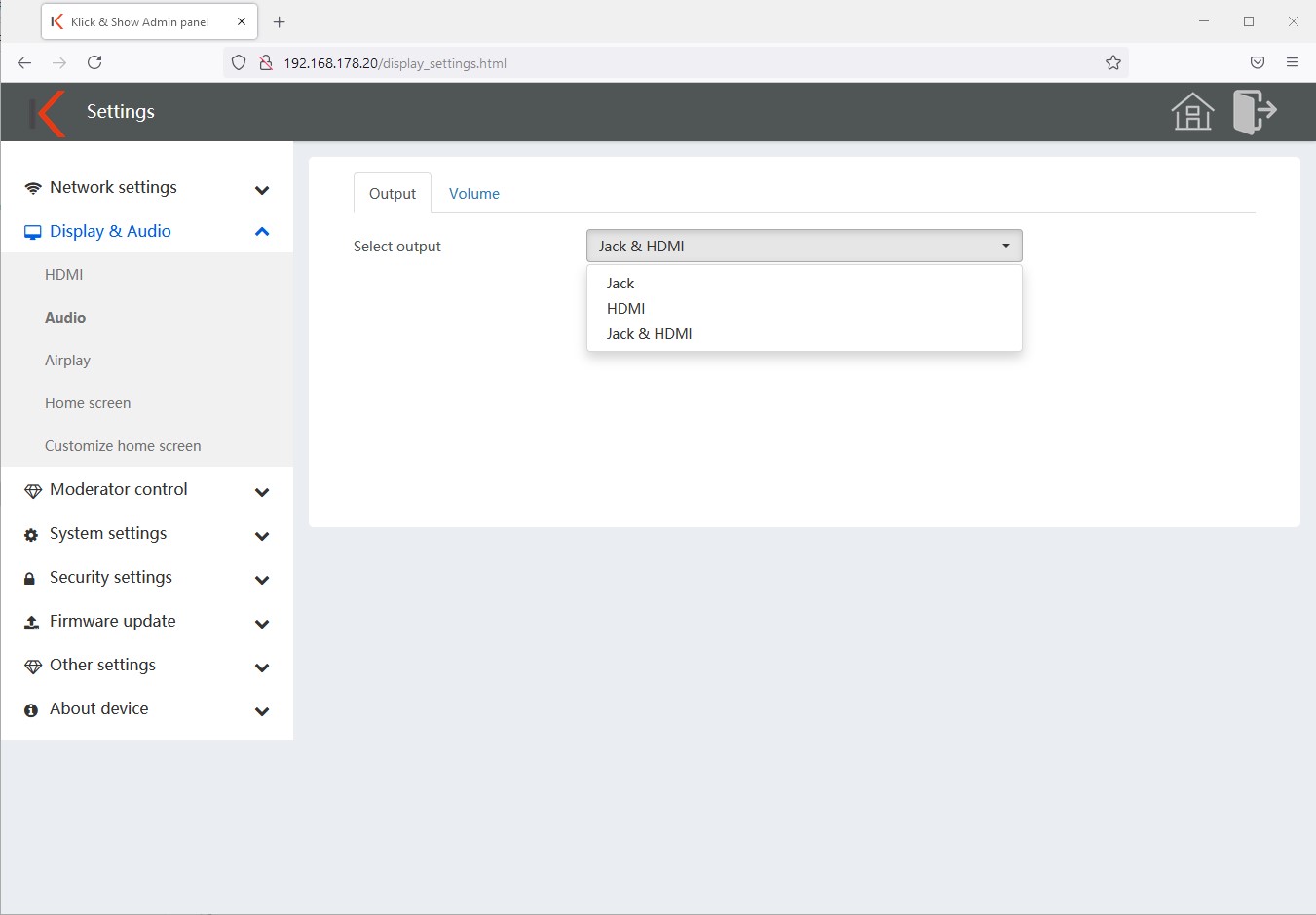
11.2.4 Volume
You can limit the playback volume, e.B. to avoid exceeding a certain level.
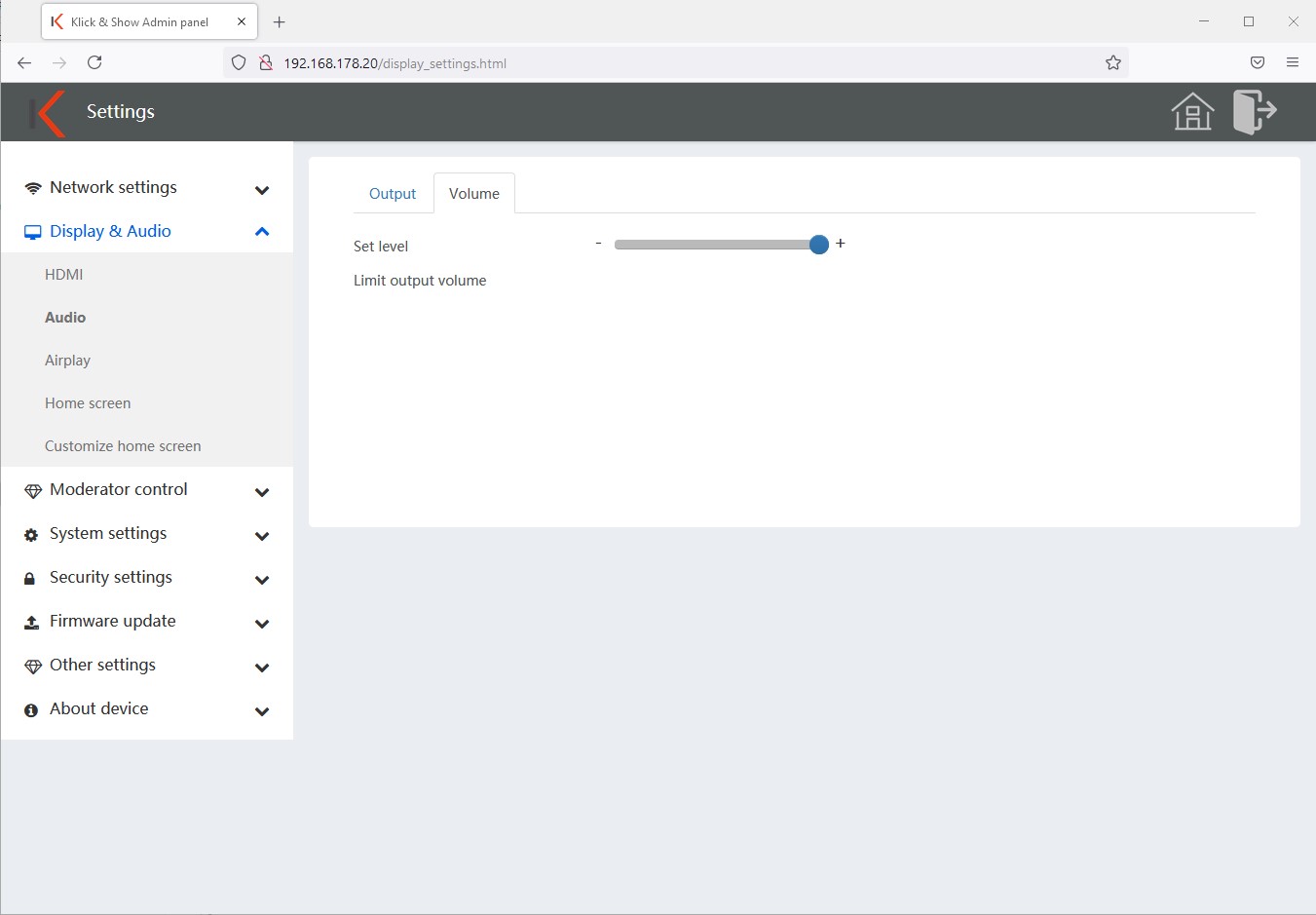
11.2.5 AirPlay image quality
Set the image quality of the AirPlay transmission here.
You can choose from:
- High: 1920×1080 (default)
- Medium: 1600×900
- Low: 1280×720
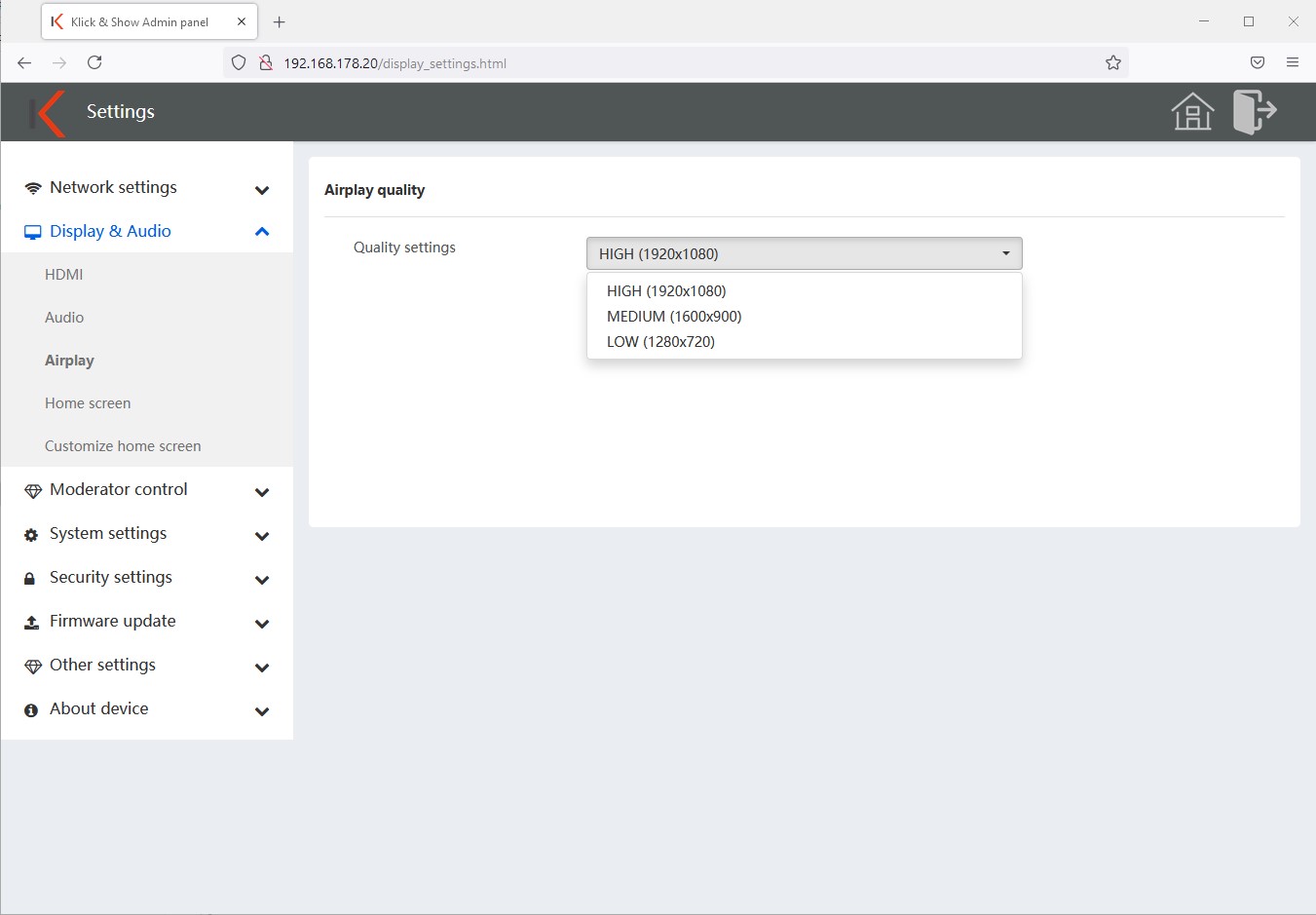
![]() hint:
hint:
The higher the quality the more data is transferred, a lower quality can mean a smoother transmission.
11.2.6 Homescreen Configuration
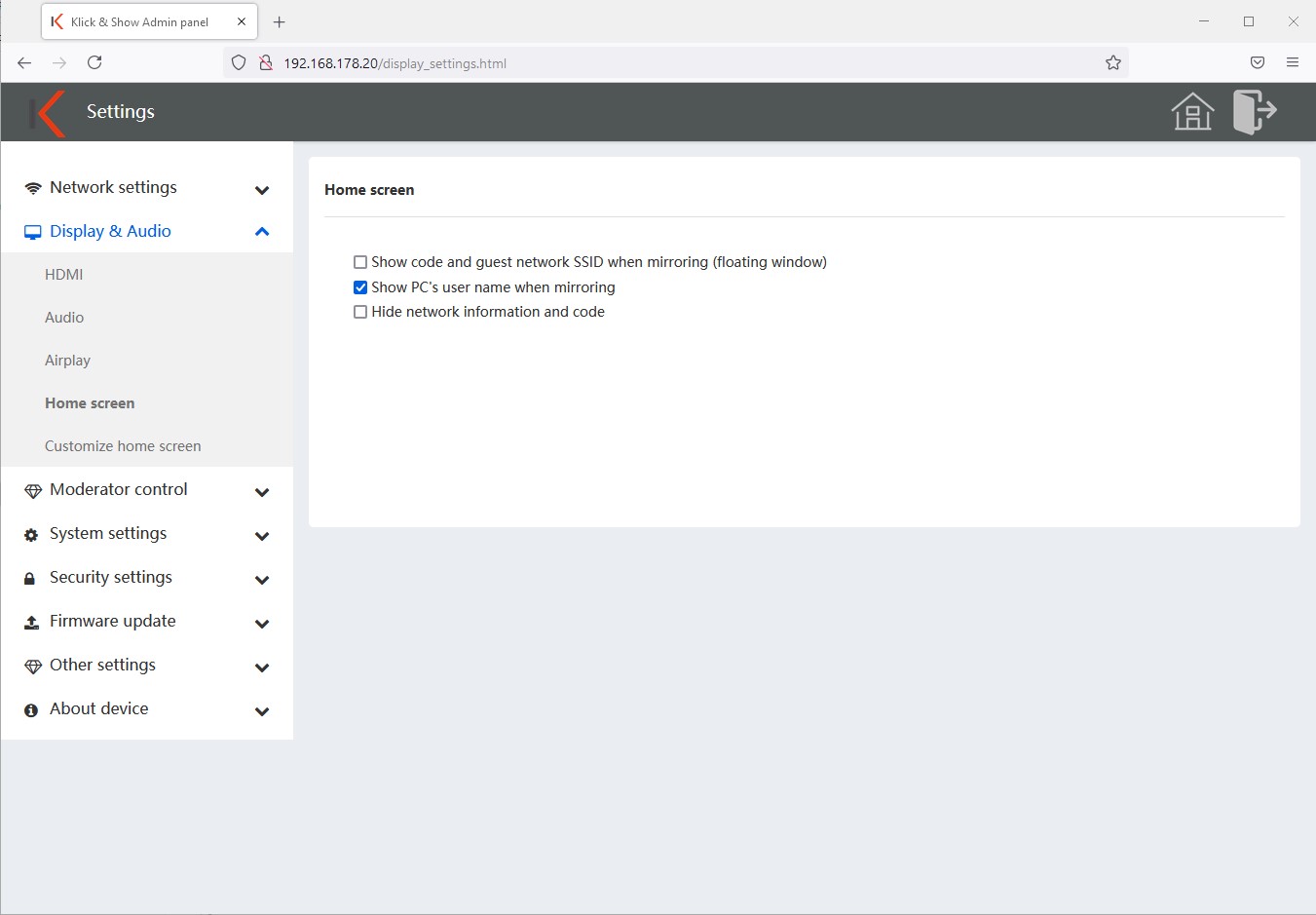
Here you can decide which information from the Klick & Show on the home screen or during the presentation.
- Display the device name and password of the base when mirroring
Displays the guest SSID and code in a small semi-transparent window during transmission.
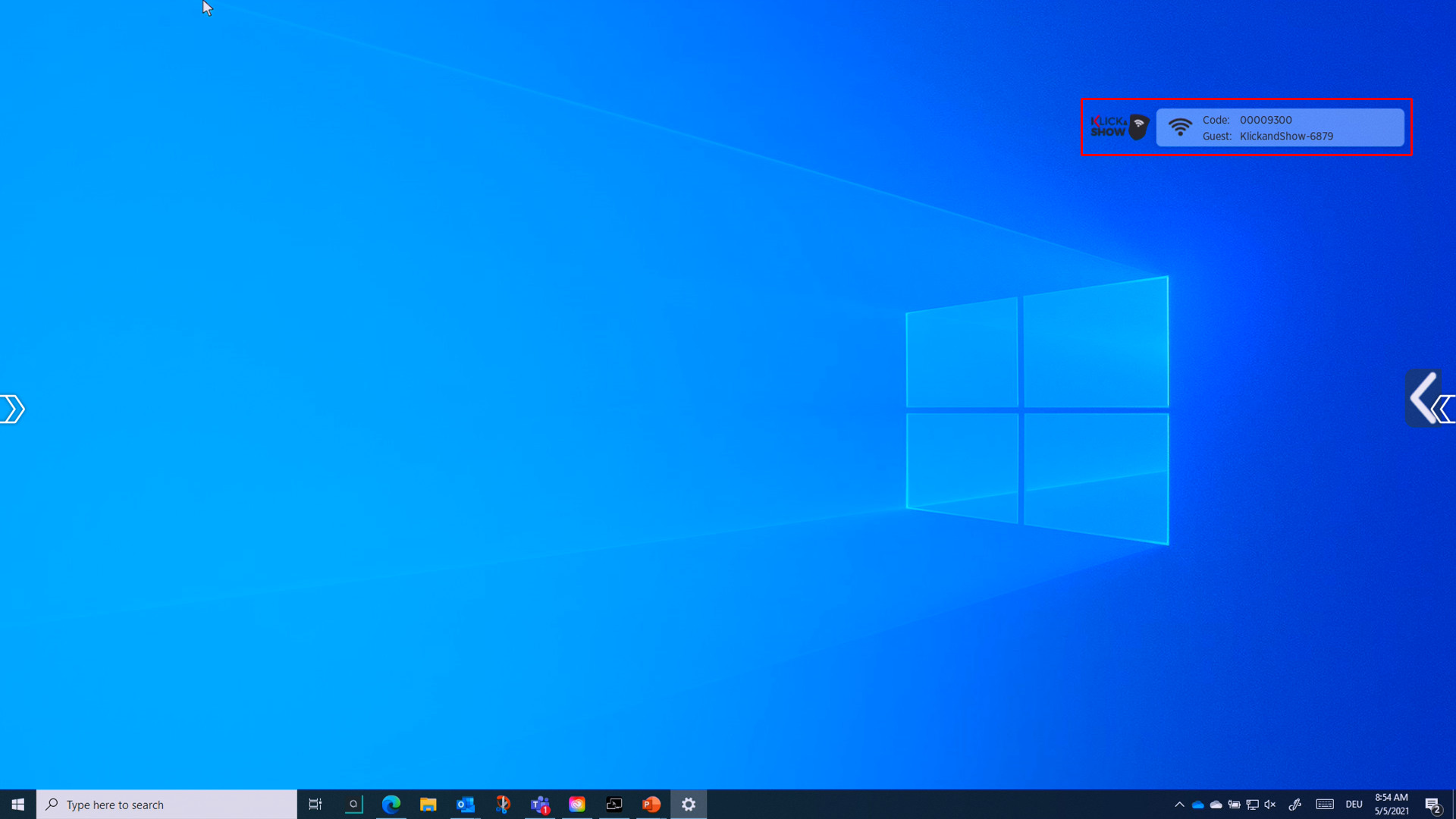
- When mirroring, show the user name of the PC
At the beginning of a transfer, briefly displays the user or device name of the presenter.
- Hide connection information
Hides all connection information (SSIDs, code, IP addresses) on the home screen.
11.2.7 Home Screen Wallpaper
You can customize the home screen. To do this, click on the "+" and select the desired file.
The individual background image is automatically activated. You can delete the individual home screen wallpapers and/or reactivate the default wallpaper at any time.
![]() hint:
hint:
The file formats jpg, bmp or png in the resolution 1920×1080 and up to a file size of 1 MB can be used. Up to 12 individual homescreen backgrounds can be uploaded. These remain even after a firmware update.
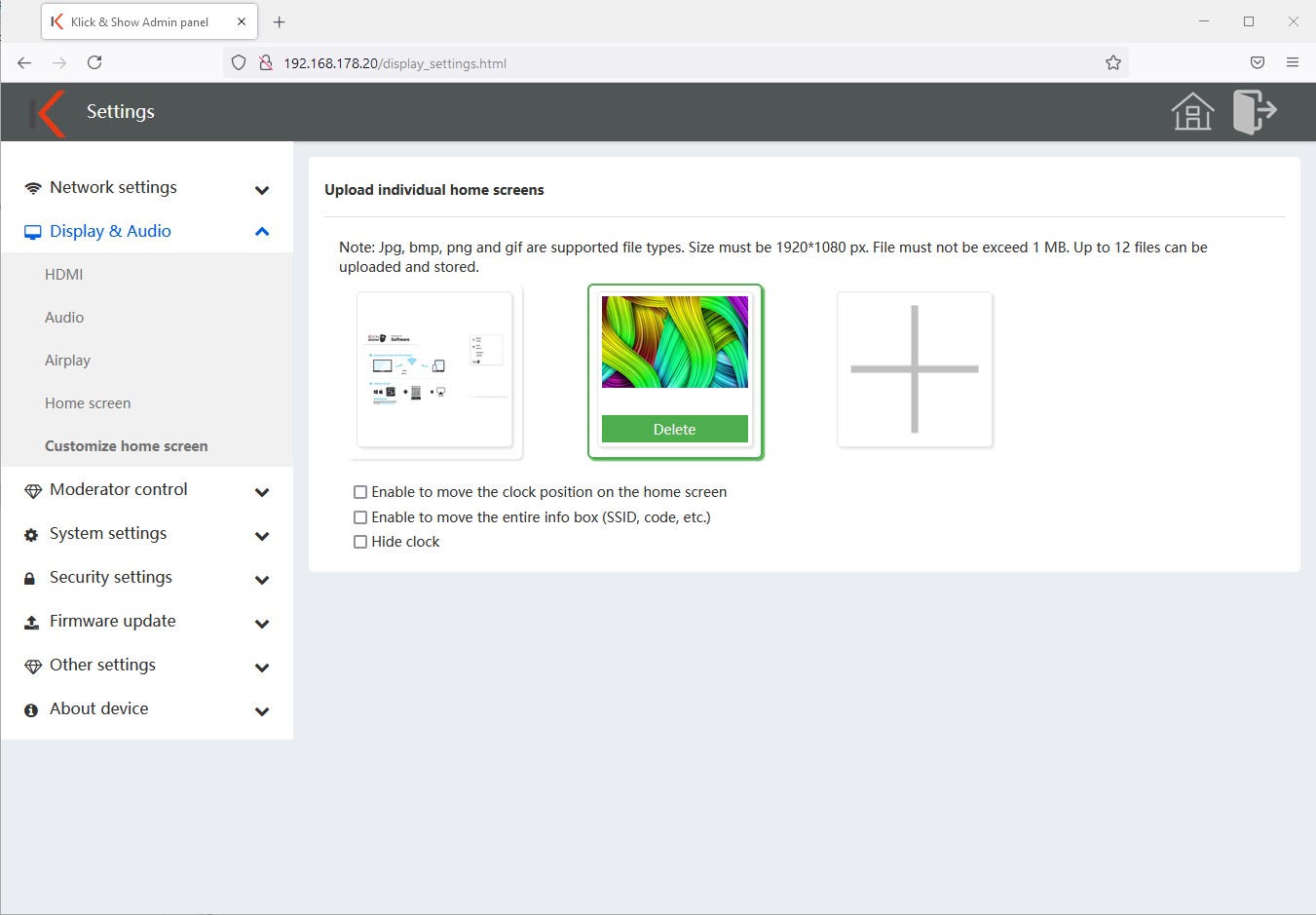
If you choose an individual background, three additional settings are available.
- Move the position of the watch – if this option is activated, the watch can be moved freely from its default position in the lower right corner of the screen.
- Move the position of the infobox – if this option is activated, the infobox (SSIDs, code, etc.) can be moved freely from its default position in the upper right corner of the screen.
- Hide clock – hides the time and date display on the home screen.
![]() Hint:
Hint:
To be able to move the elements, you must use the Klick & Show Operate the base to a touch screen or temporarily connect a mouse.
11.3 Moderator control
11.3.1 Moderator control
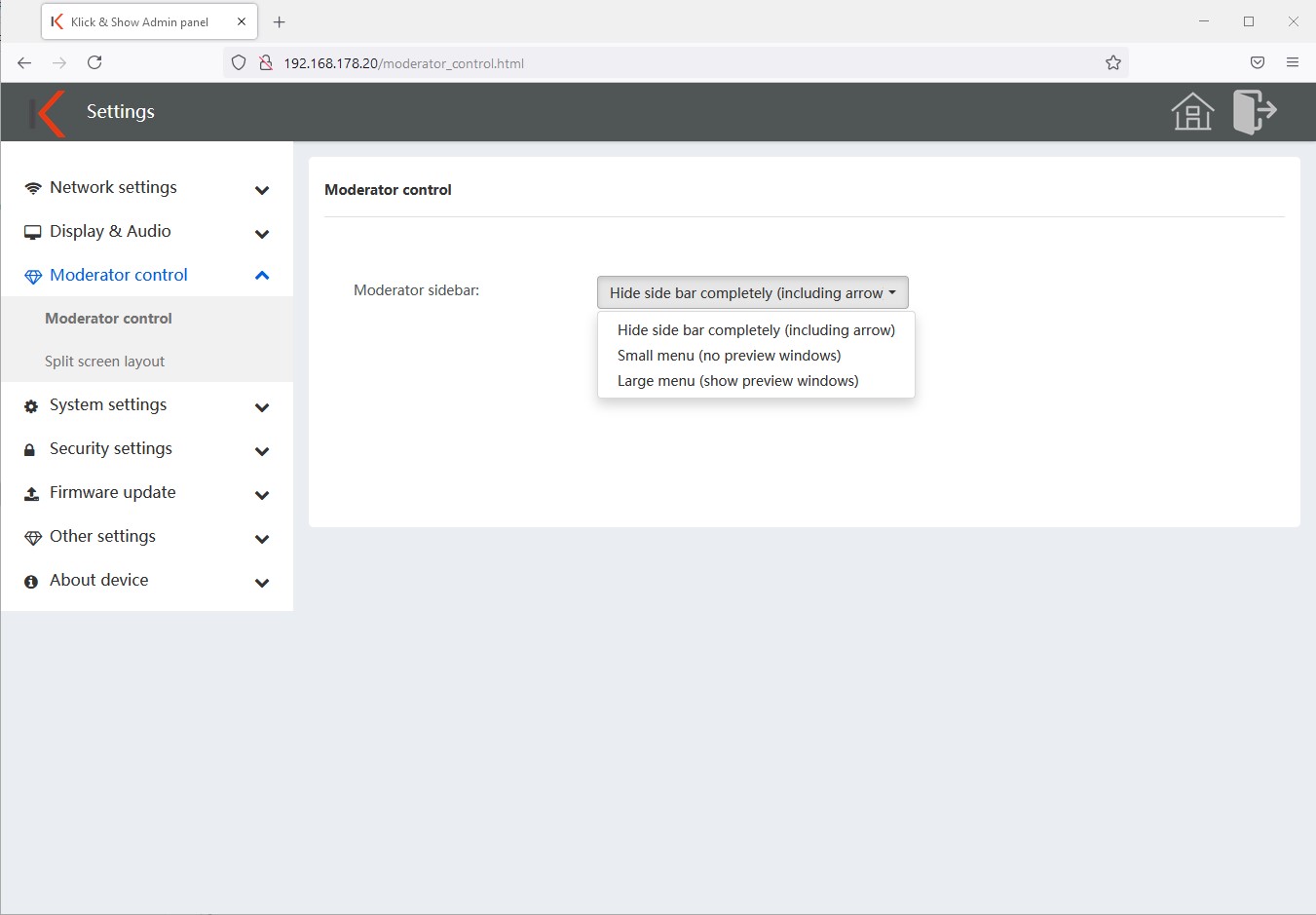
- Disable moderator control
The menu cannot be accessed. - Small menu
A gray arrow appears on the right side of the display. By tapping menu opens and allows access to the whiteboard or annotation app.
- Large menu
If you activate this function, all connected devices including live preview are displayed and can be selected by tapping and brought to the presentation by the moderator. (Preview available when using the transmitters, wireless media clients for Windows or MacOS.)
11.3.2 Screen layout
Klick & Show allows the simultaneous display of up to 4 devices. To do this, you can select the screen layout at this point.
Different layouts can be selected for the simultaneous use of 2, 3 and 4 sources.

11.4 System Settings
11.4.1 Transmitters
The "Connected" tab shows an overview of all connected, send-ready and sending transmitters and software clients connected to the base.
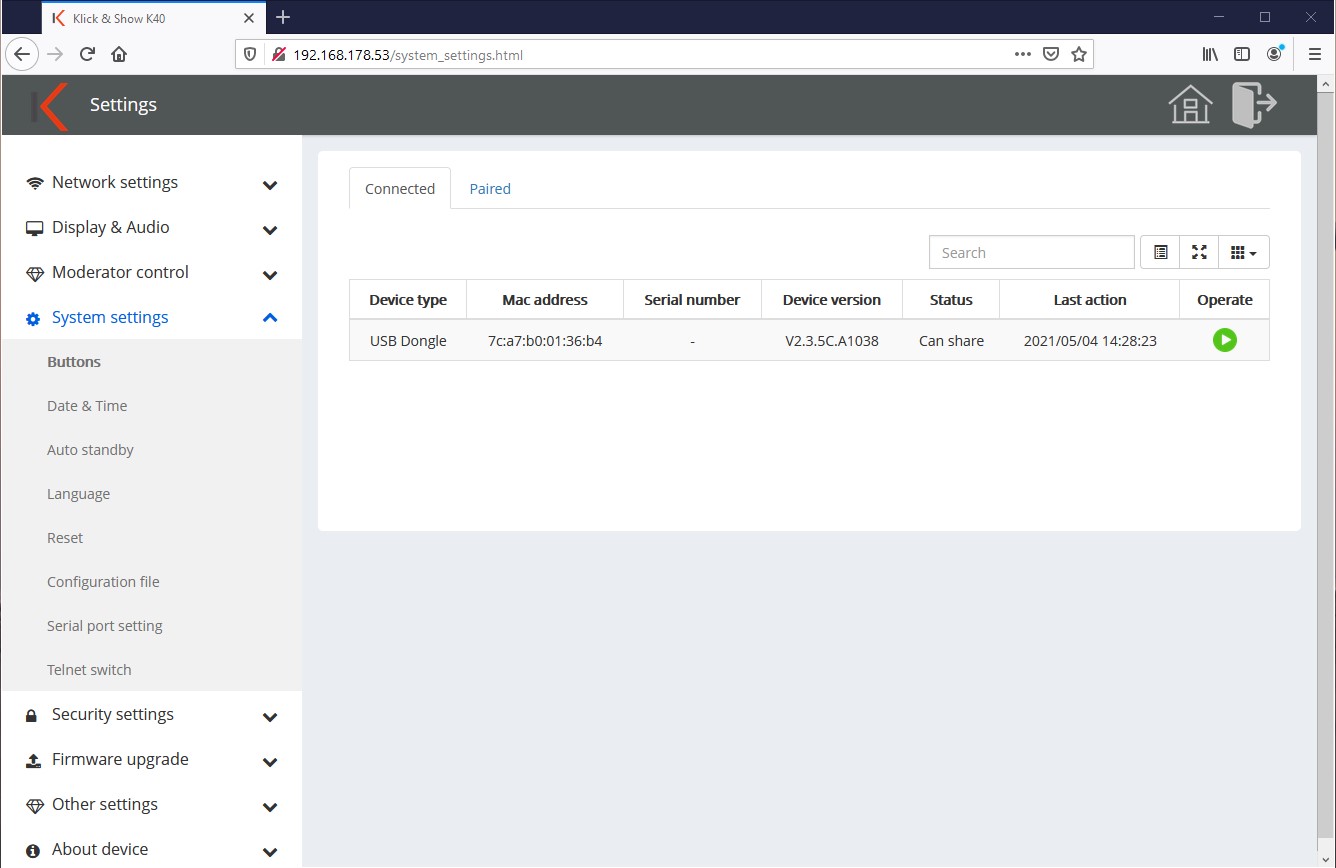
Displays the type, Mac address, serial number, software version, device status, and recent activity. The transfer can be started or interrupted via the "Operate" function.
With the "Columns" button at the top right, this information can be shown or hidden individually as required.
![]() hint:
hint:
Connections or transmissions from AirPlay, Miracast and ChromeCast do not support this feature and are therefore not displayed.
Under the "Paired" tab, all transmitters that have ever been connected to this tab are listed. Klick & Show Base were coupled. With the "Remove" button (garbage can), individual or all devices can be selected and decoupled (deleted) here. Before the next use at this base, these must then be retrained.
In this way, abusive transmissions of stolen transmitters can be prevented.
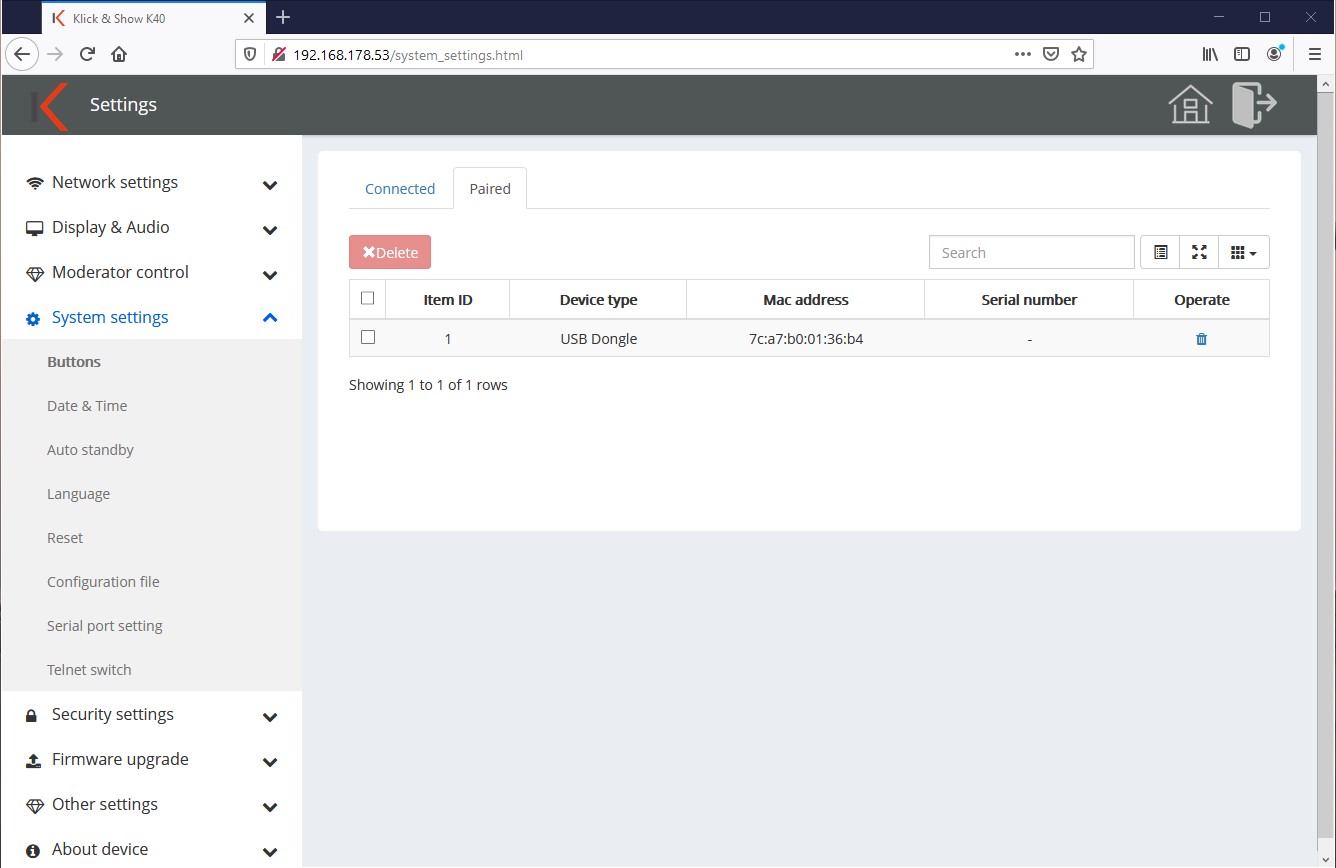
11.4.2 Date and time
Under the tab "Date & Time" you can set whether the time setting should be automatically obtained from a time server from the Internet or assigned manually (e.B. if there is no connection to the base and the Internet).
Under the "Time Zone" tab, it can be selected accordingly.
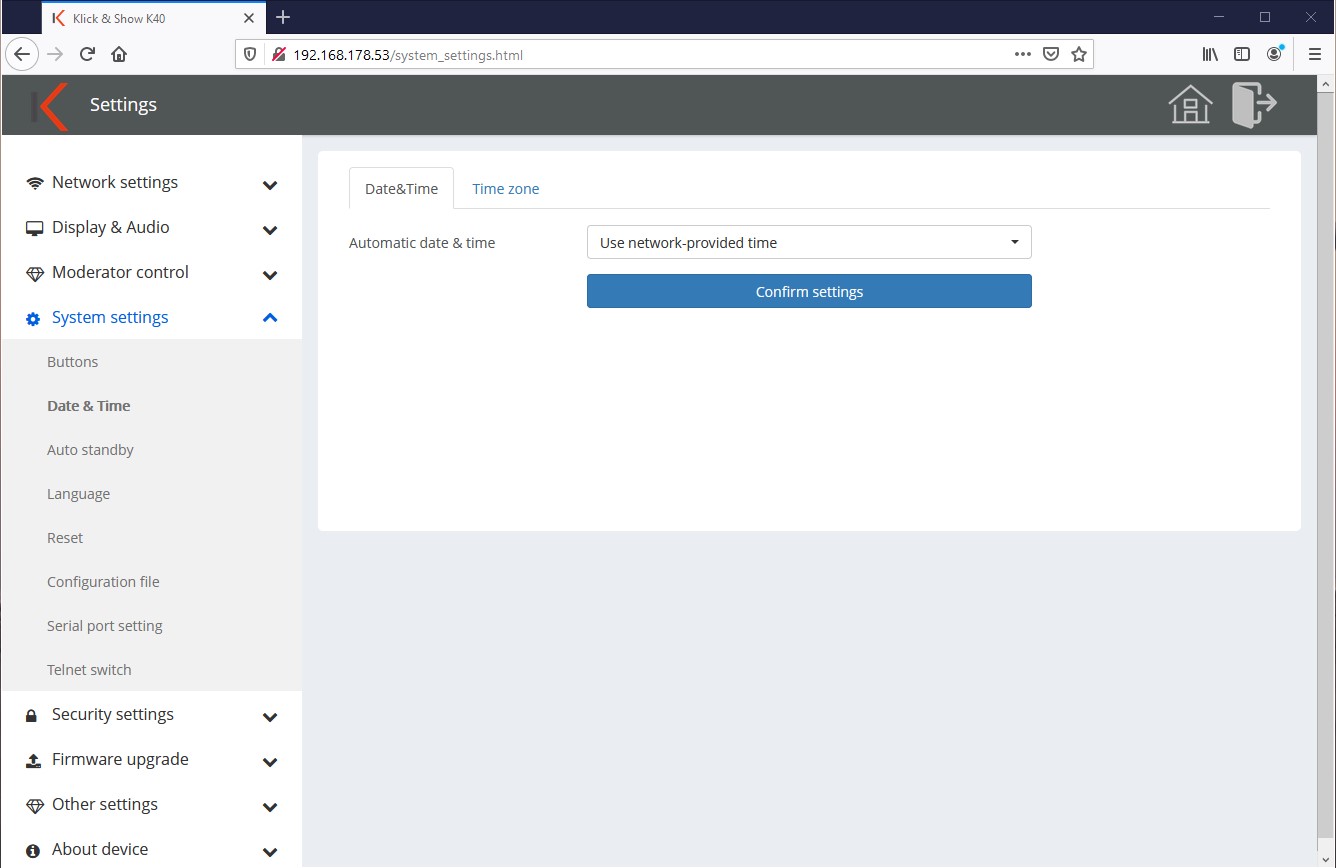
![]() Hint:
Hint:
In the factory setting, the Klick & Show Basic access to a time server, otherwise no time and date information is displayed on the home screen.
11.4.3 Car stand-by
Auto Stand-by offsets the Klick & Show Base automatically enters the power saving mode if there is no connection or use of the device within the selected time.
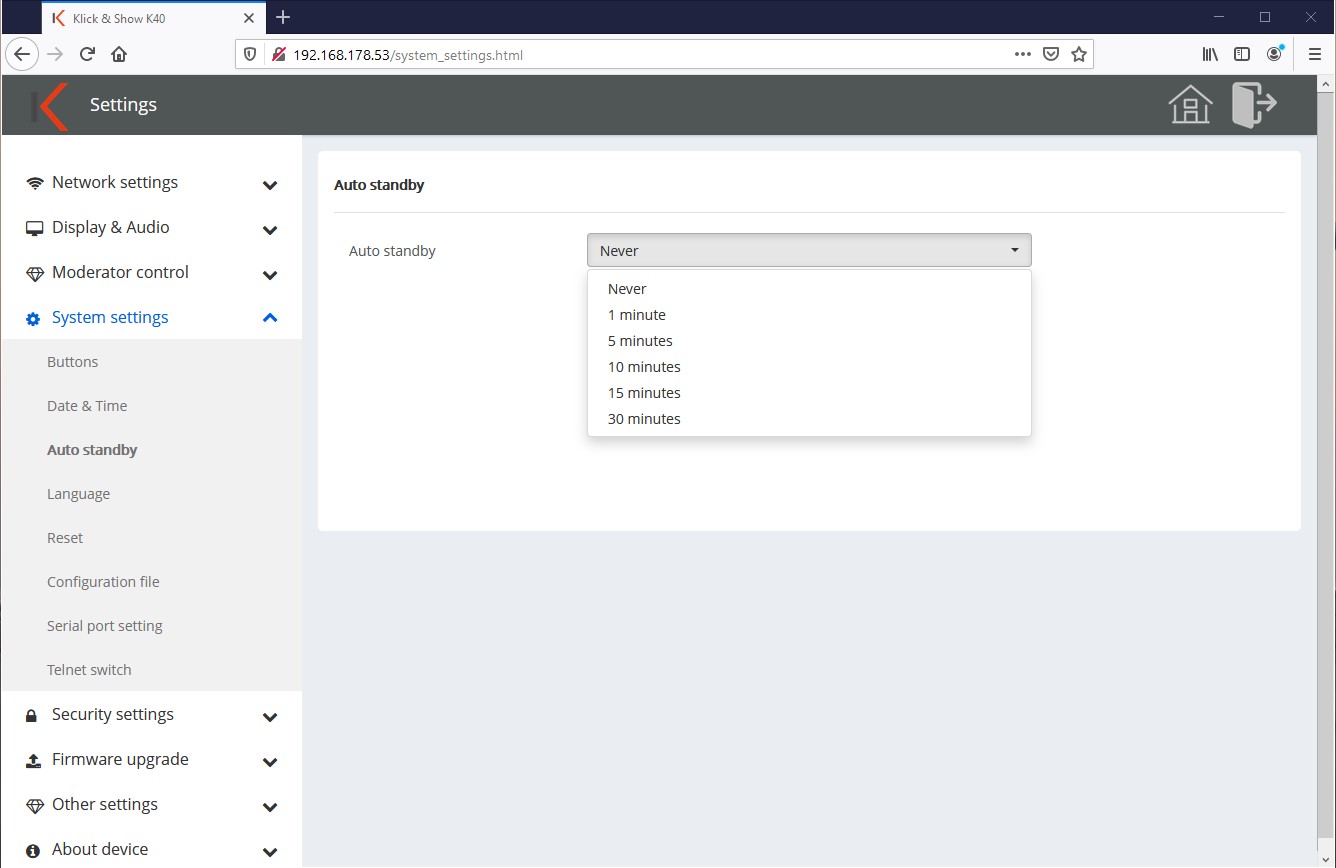
In standby, the LED ring of the base flashes and the HDMI output is switched off. However, the network connection remains active. As soon as a device with the Klick & Show is connected, the power saving mode is terminated.
Pressing the POWER button on the front of the device or entering it on the connected touch screen also ends the energy-saving mode.
11.4.4 Language
You can change the desired language of the Klick & Show Select home screens and the WebUI (Administration) independently of each other.
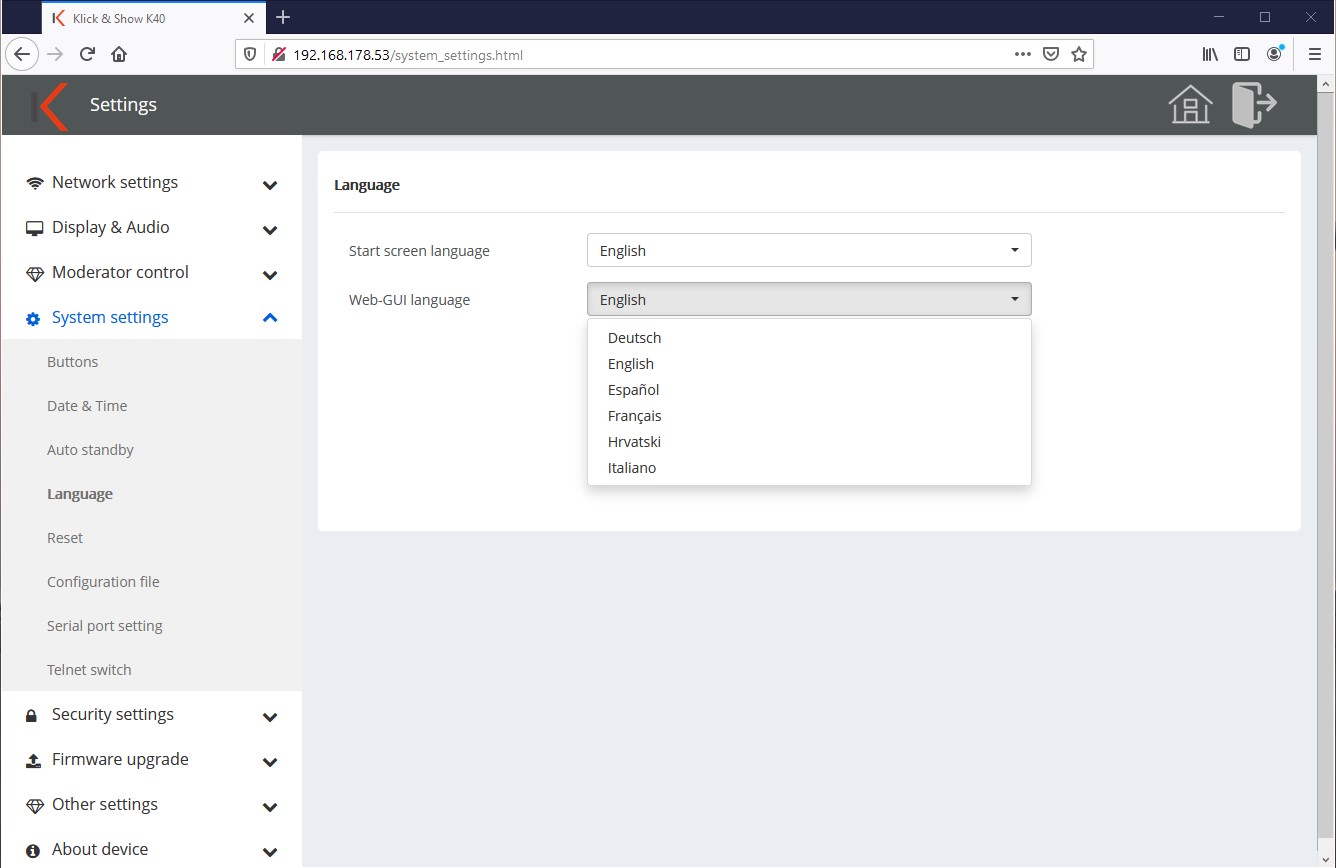
11.4.5 Resetting
The "Confirm Settings" button and the re-confirmation of the security prompt will reset the device to factory settings. Alternatively, you can use the Klick & Show also reset via the reset button on the back of the device.
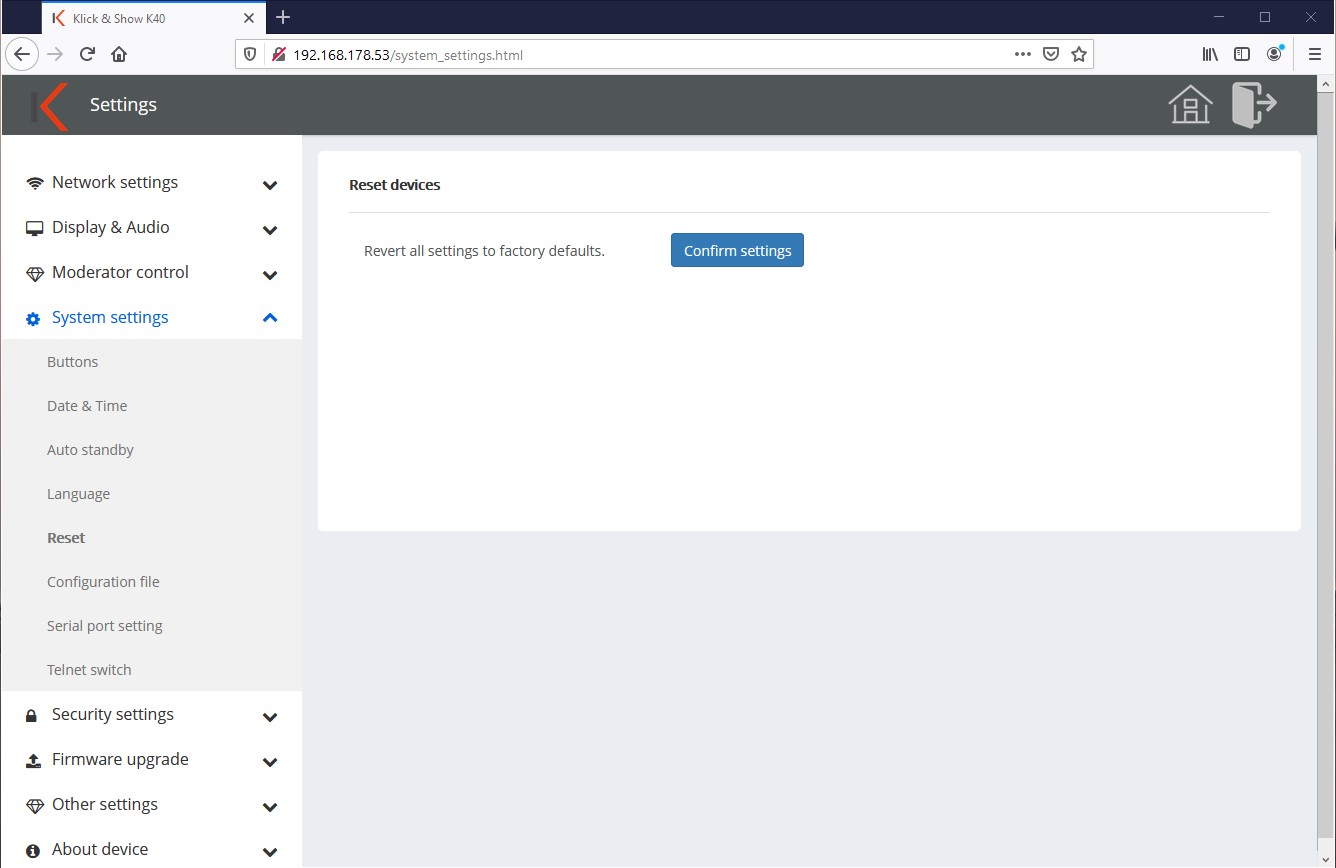
11.4.6 Save/install configuration
Under the Download Configuration File tab, you can save the current system configurations as a local config .dat.
Under the tab "Upload configuration file" you can then upload it again (e.B. after a reset) or to another Klick & Show so that the configuration effort is minimized.
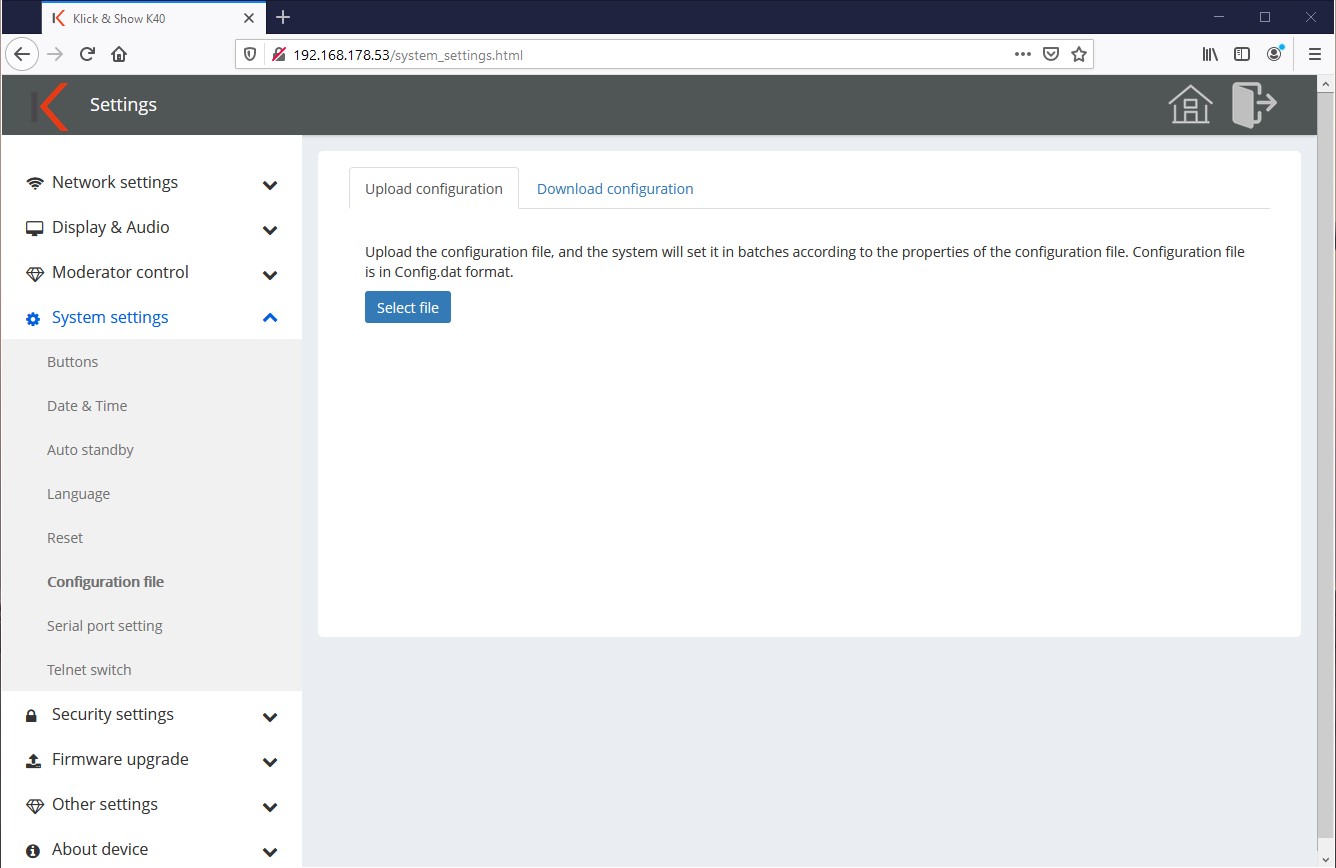
11.4.7 Serial interface (RS232)
RS232 can be activated or deactivated in this menu. If the interface is active, the Klick & Show Basis can be controlled by it or these devices themselves control.
Remote control of the Klick & Show Basis via RS232:
To do this, configure the serial port function to "Klick & Show control ". The control commands are identical to the Telnet commands.
You can apply the other settings (baud rate, etc.) or adapt them to the capabilities of the media control.

Remote control of external devices via RS232 by Klick & Show:
To do this, set the serial port function to "Klick & Show and adapt the communication parameters to the technical requirements specified by the device to be controlled.
These can usually be found in the manual as a preliminary remark to the RS232 commands.
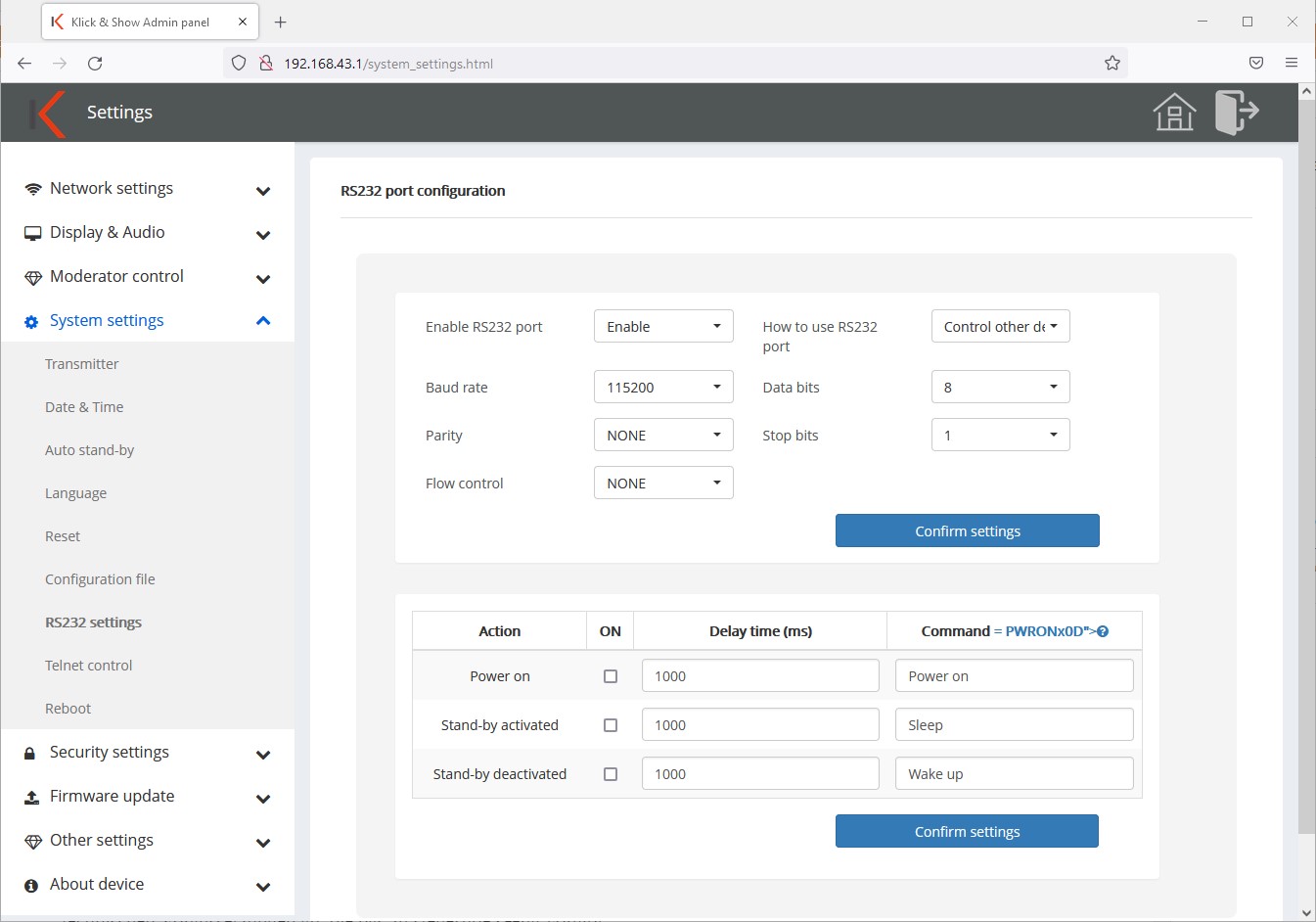
Commands can be stored for the following functions:
- Turn on
(as soon as the power supply of Klick & Show was manufactured) - Going to sleep (If Klick & Show goes into stand-by)
- Wake up (If Klick & Show the stand-by ended)
The delay can be entered separately.
With ON/OFF, the stored command can be set active or inactive. The commands must be entered in ASCII.
11.4.8 Taxes with Telnet
Here the control can be activated or deactivated via Telnet.
The control commands can be found here.
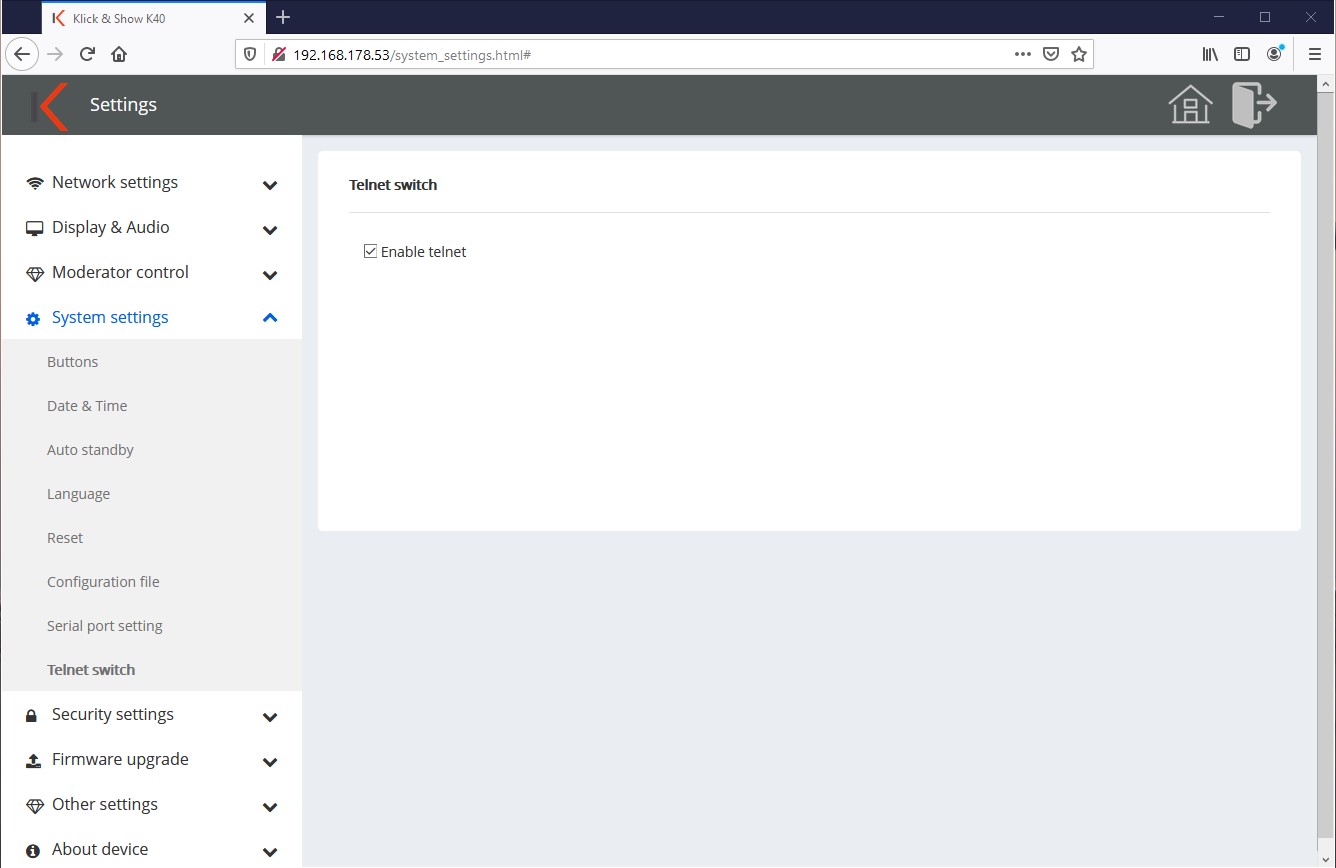
11.4.9 Restarting
Here a restart of the Klick & Show Basis directly initiated or carried out automatically on certain days of the week at a predefined time.
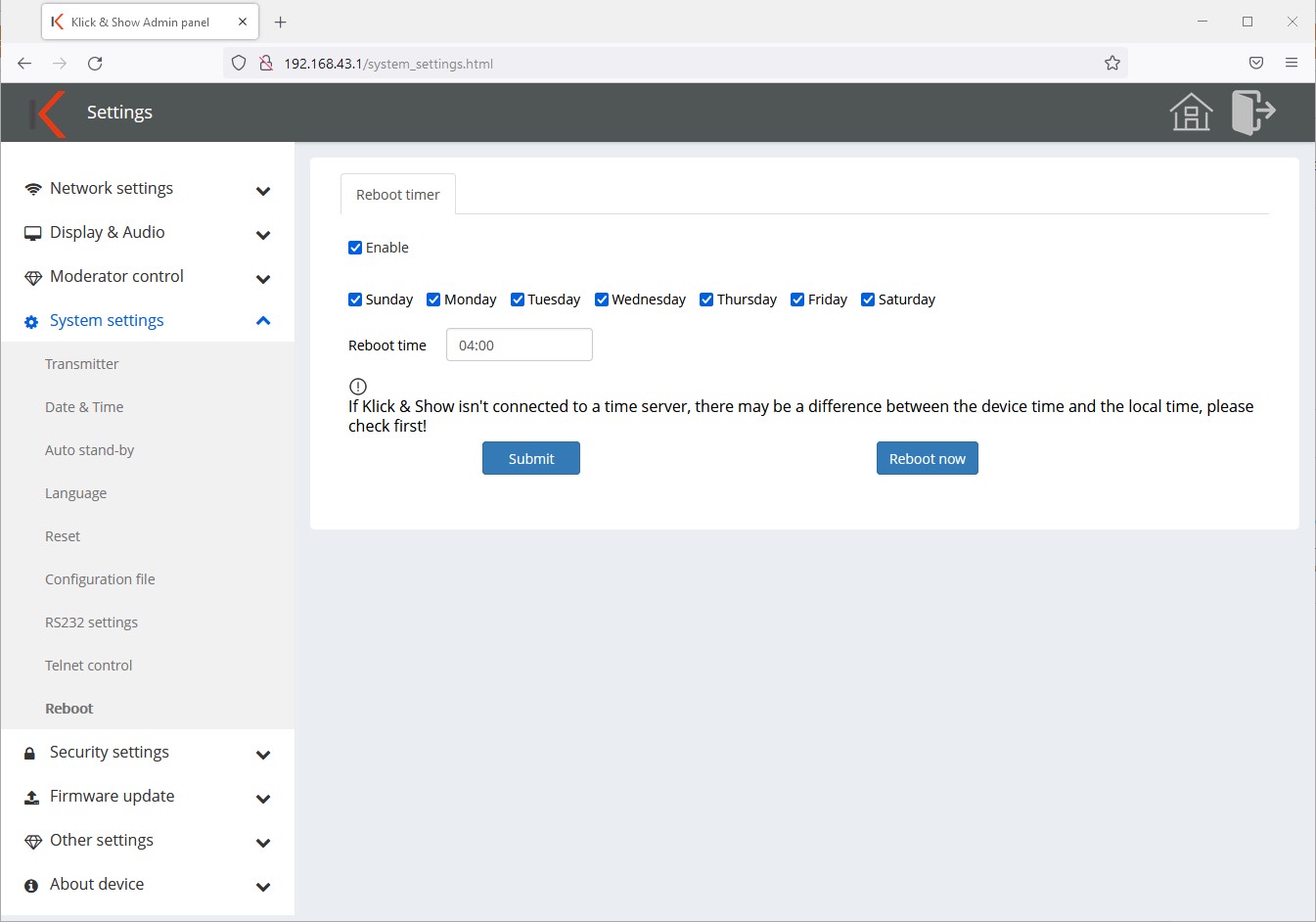
11.5 Security settings
11.5.1 Security levels
You can use four different security levels for the Klick & Show choose. Security levels 1 through 3 are predefined and cannot be changed. The security level "Custom" allows you to select the individual security features individually according to your needs. The first two security features are enabled at each level and cannot be disabled. In the factory settings, security level 1 is enabled.
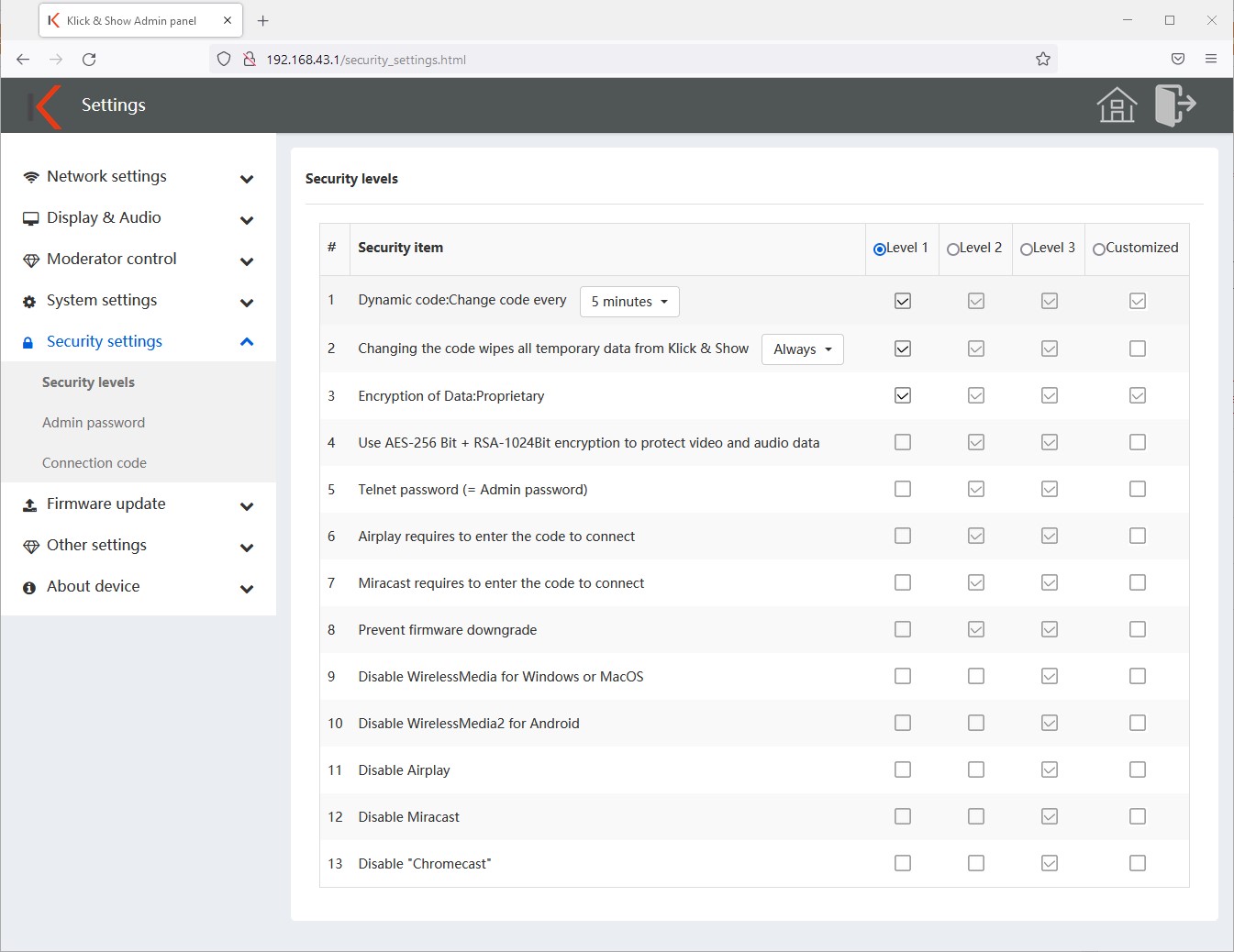
Change code/WLAN password automatically
The code secures the use of Klick & Show against unauthorized use. Depending on the network configuration, this is also the WLAN password (in Access Point Mode) or only serves to protect against interference by outsiders, e.B. accidental connection.
Changing the code regularly prevents a previous user from still being presenting after leaving the room.
The code remains unchanged as long as a device with the Klick & Show is connected. After the last device has disconnected, the set timer expires. Fifteen seconds before expiration, there is a warning message that the code will change shortly. The timer can be changed to different times:
- Never (= requires the individual configuration of the security levels)
- 5 / 30 minutes
- 1 / 2 / 4 / 24 hours
![]() hint:
hint:
If you Klick & Show in Access Point Mode and select "Never", you must enter the password.
![]() tip:
tip:
If the password timer is not displayed, at least one device is still connected. Mobile devices can also maintain a Wi-Fi connection in the background and prevent automatic password changes and the STANDBY function!
If the code changes, it will only affect all manual Wi-Fi connection. The transmitter must: not be newly paired with the base device.
Password change deletes the temporary memory
The code remains unchanged as long as a device with the Klick & Show is connected. After the last device has disconnected, the set timer expires. Then, depending on the setting made, the temporary memory of the Klick & Show Base securely deleted. The following settings can be made:
- Never (= requires the individual configuration of the security levels)
- User decides (a corresponding window appears on the display, after 100 seconds without input the data is automatically deleted)
- Always
Encryption of data: Proprietary
The communication between the Klick & Show The base and the transmitters or software clients are secured with proprietary encryption.
Encrypt video/audio data with AES-256 bit + RSA-1024 bit (screen sharing)
The video and audio data are backed up twice using the encryption methods mentioned above.
11.5.2 Login password
The password protects access to the administration menu.
The default password in the delivery state and after a reset is "admin".
Please change the password to a secure one during commissioning.
However, you also have the option to disable password prompting for the administrator menu. To do this, tick "Disable password request".
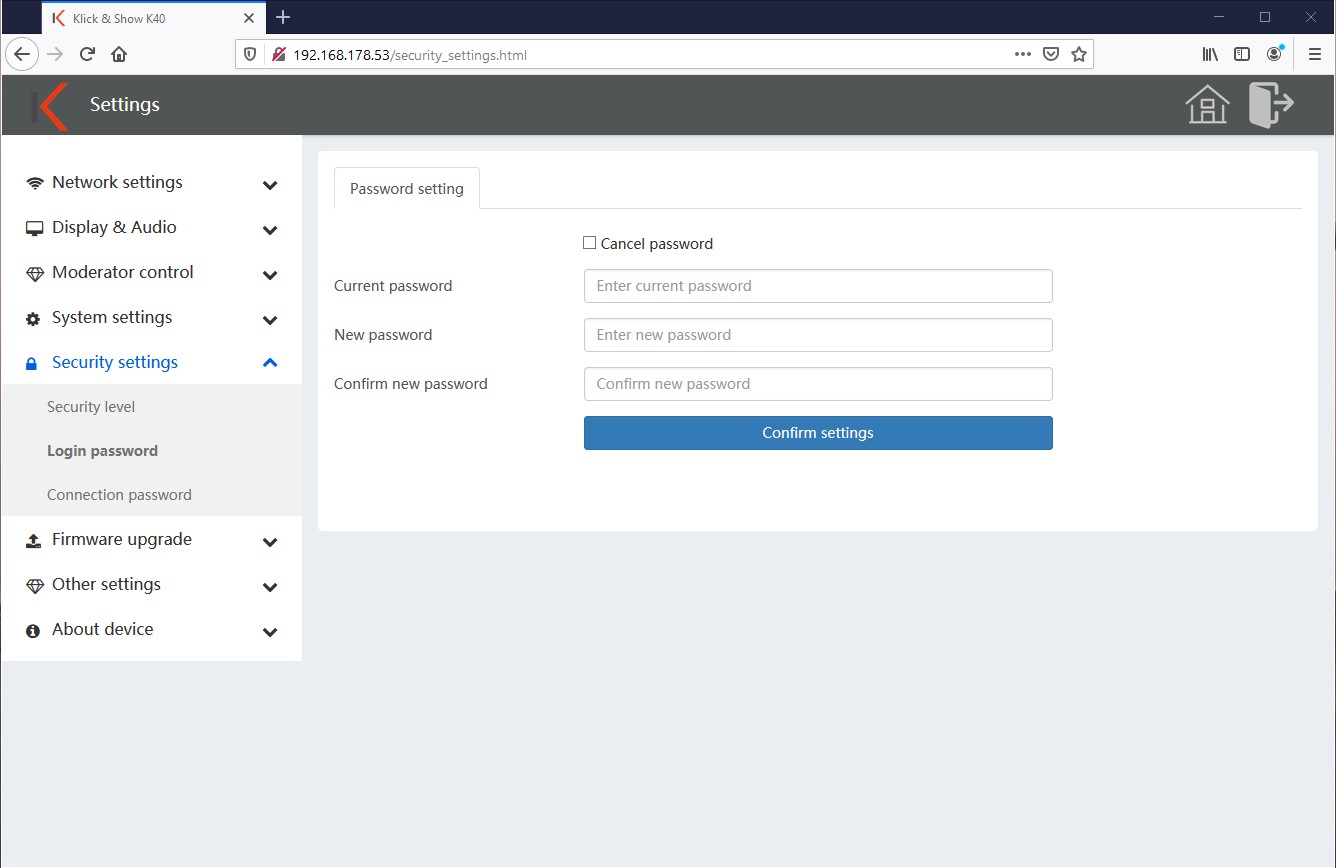
11.5.3 Connection password
Define whether the code should be 4-digit (with four leading zeros) or 8-digit.
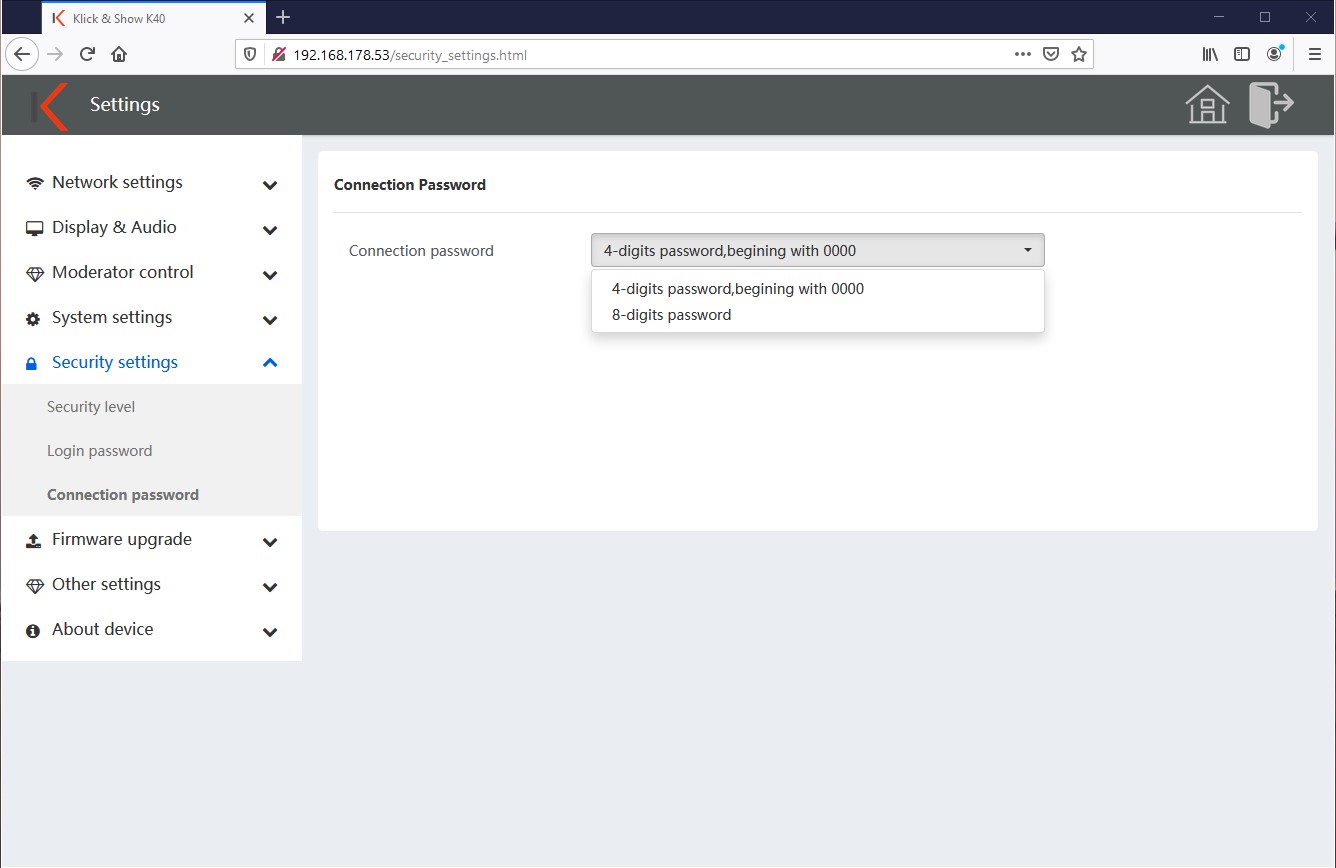
11.6 Firmware Update
11.6.1 Update firmware manually
Download the latest firmware from http://k40.www.klickandshow.com.
Unzip and save the "update.img" file on your computer. Via "Select Firmware" you can search for and select the file on your computer. Start the update process by pressing the "Start upload" button.
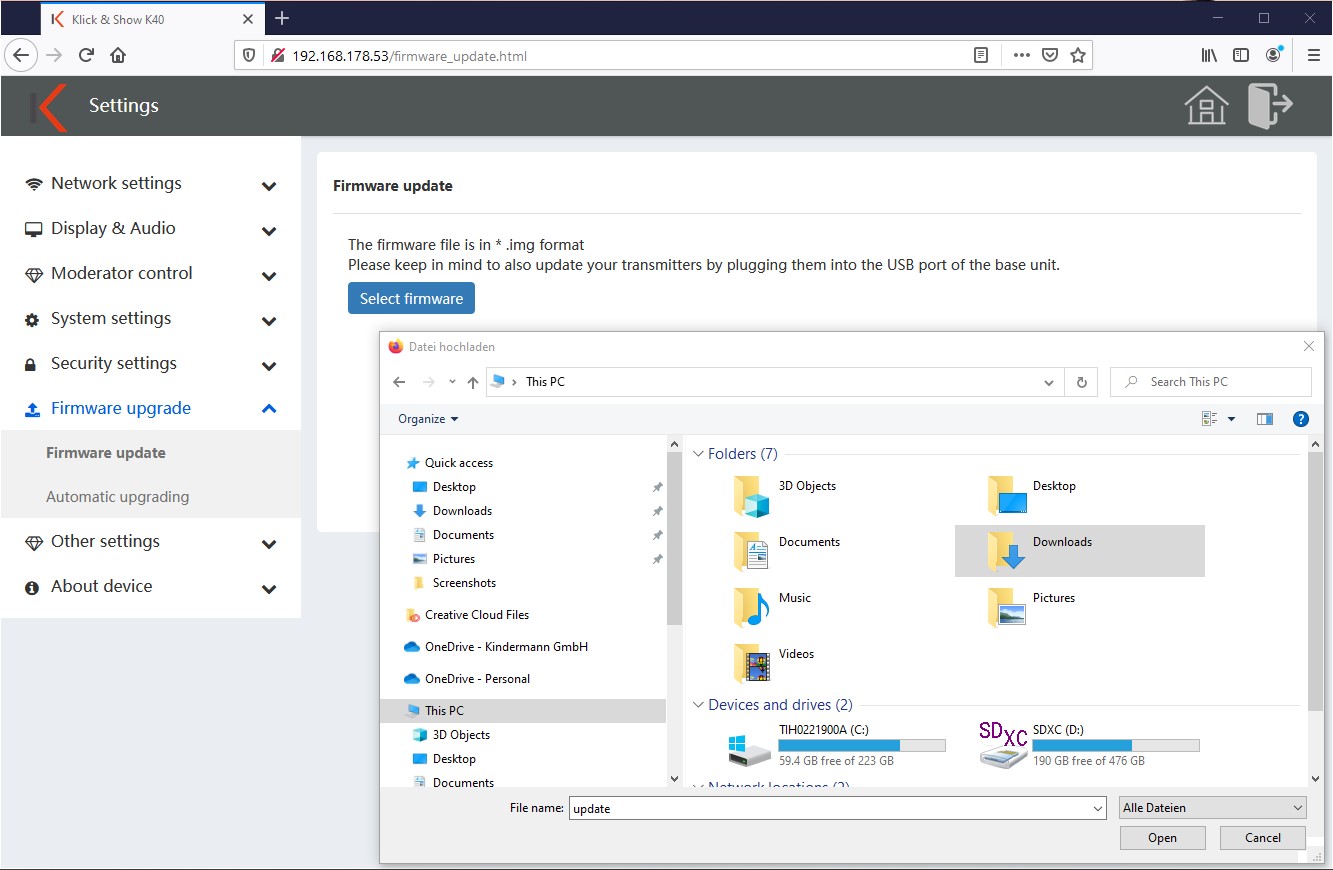
![]() Attention:
Attention:
Wduring the update, the device must not be switched off or disconnected from power. There is a risk that your device will become unusable.
The progress of the update is displayed in the browser.
That Klick & Show automatically reboots and displays the update status on the connected display.
After restarting, the update process is complete and Klick & Show displays the home screen again in the usual way.
![]() hint:
hint:
Please remember to update the transmitters and the client software after an update.
11.6.2 Automatically Update Firmware (OTA)
Alternatively, you can also have the firmware update carried out automatically via OTA (Over the Air). To do this, the Klick & Show communicate with the update server on the Internet. The base checks daily between 0 and 7 o'clock whether an update is available, which is then loaded and installed independently. In this case, a corresponding message on the display will indicate this.
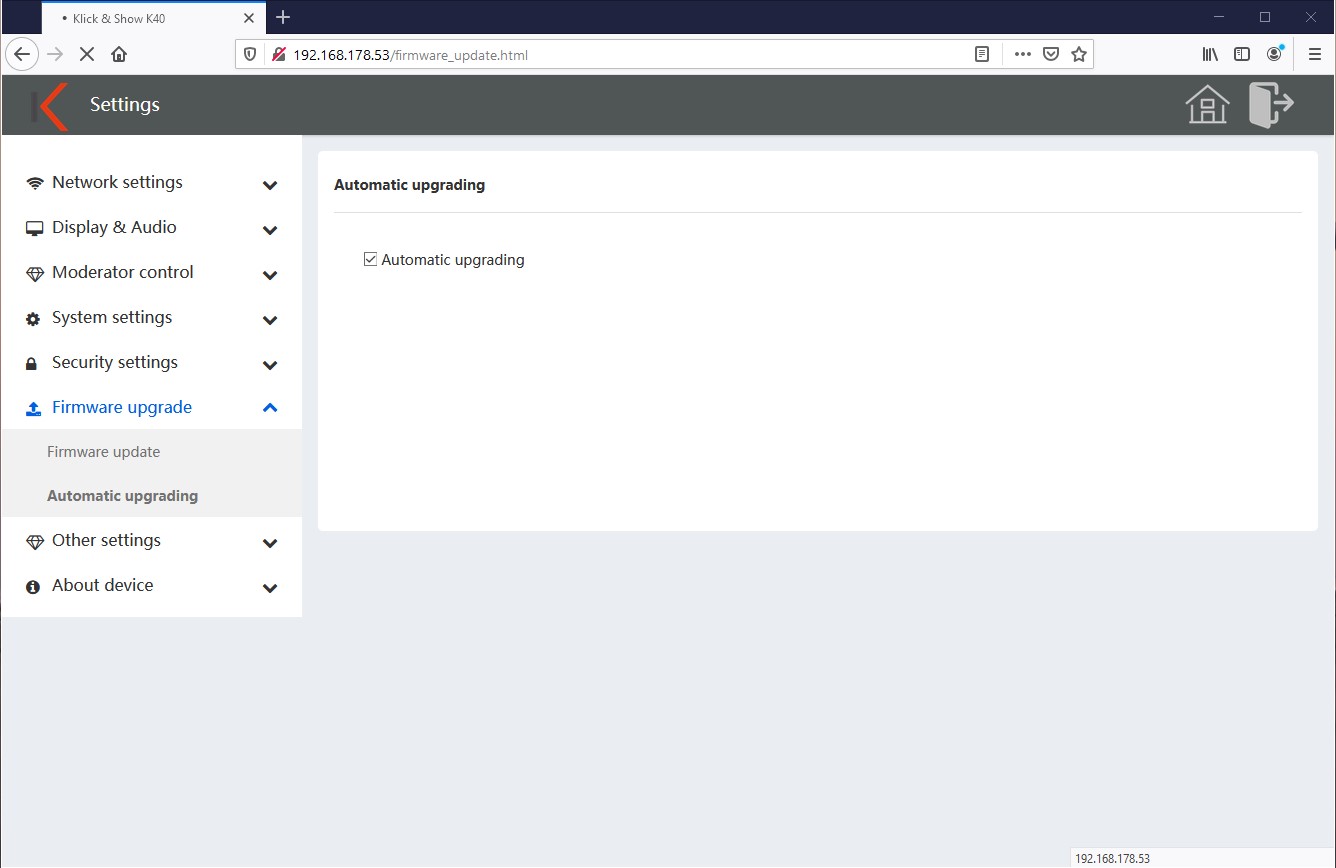
![]() hint:
hint:
Please remember to update the transmitters and the client software after an update.
11.7 Other settings
11.7.1 Create the startup program automatically
When this feature is enabled, each USB disk that is in the Klick & Show is plugged in, copies the WirelessMedia clients.
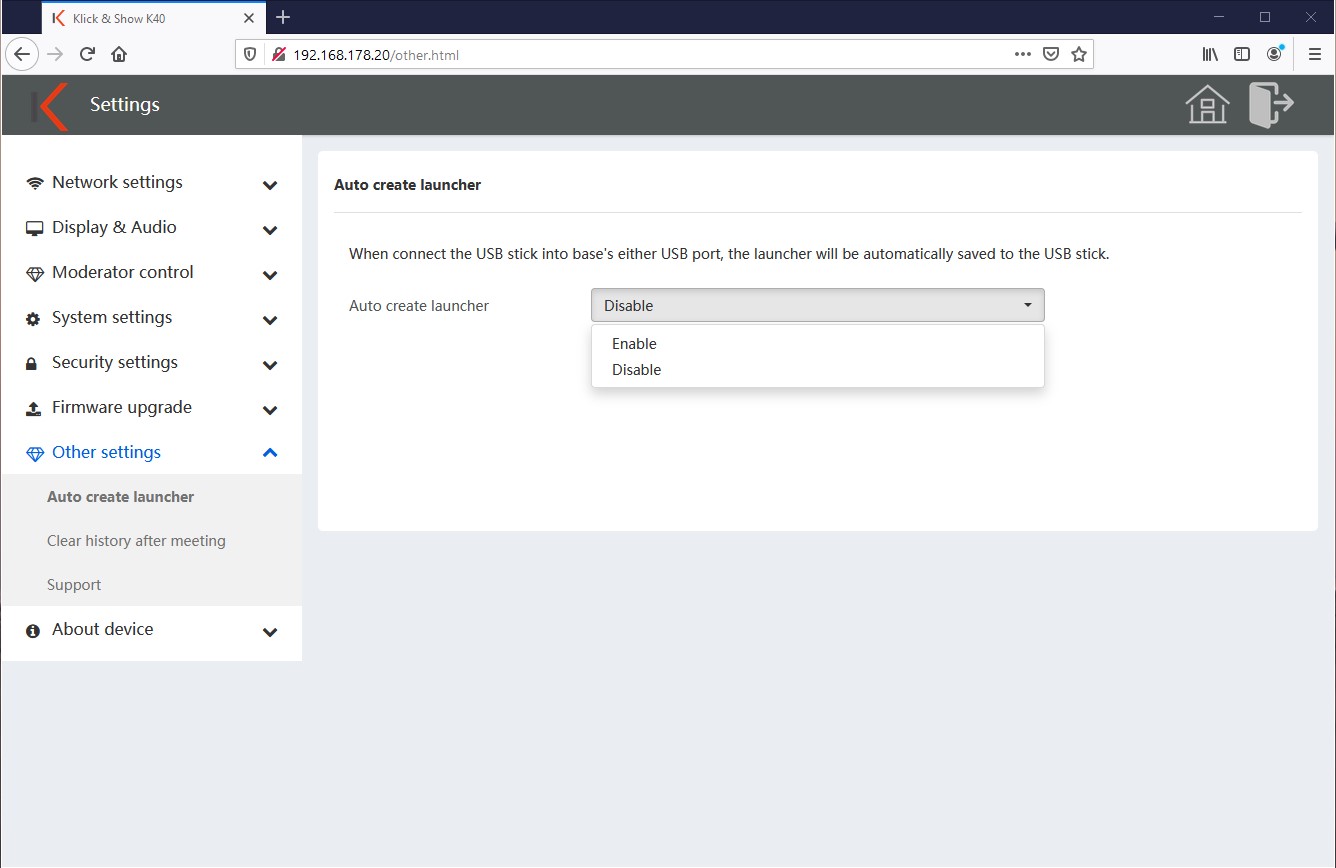
The following message is then displayed on the display:
At the end you can untrace the USB stick.
11.7.2 Support
At this place, the e-mail address and telephone number of your in-house helpdesk or a service provider can be entered.
This information is then displayed on the start page.
In the factory setting, the support information of Kindermann registered.

11.8 About the device
11.8.1 About the device
Here you will find the information on the model number, firmware version and the serial number of the base.
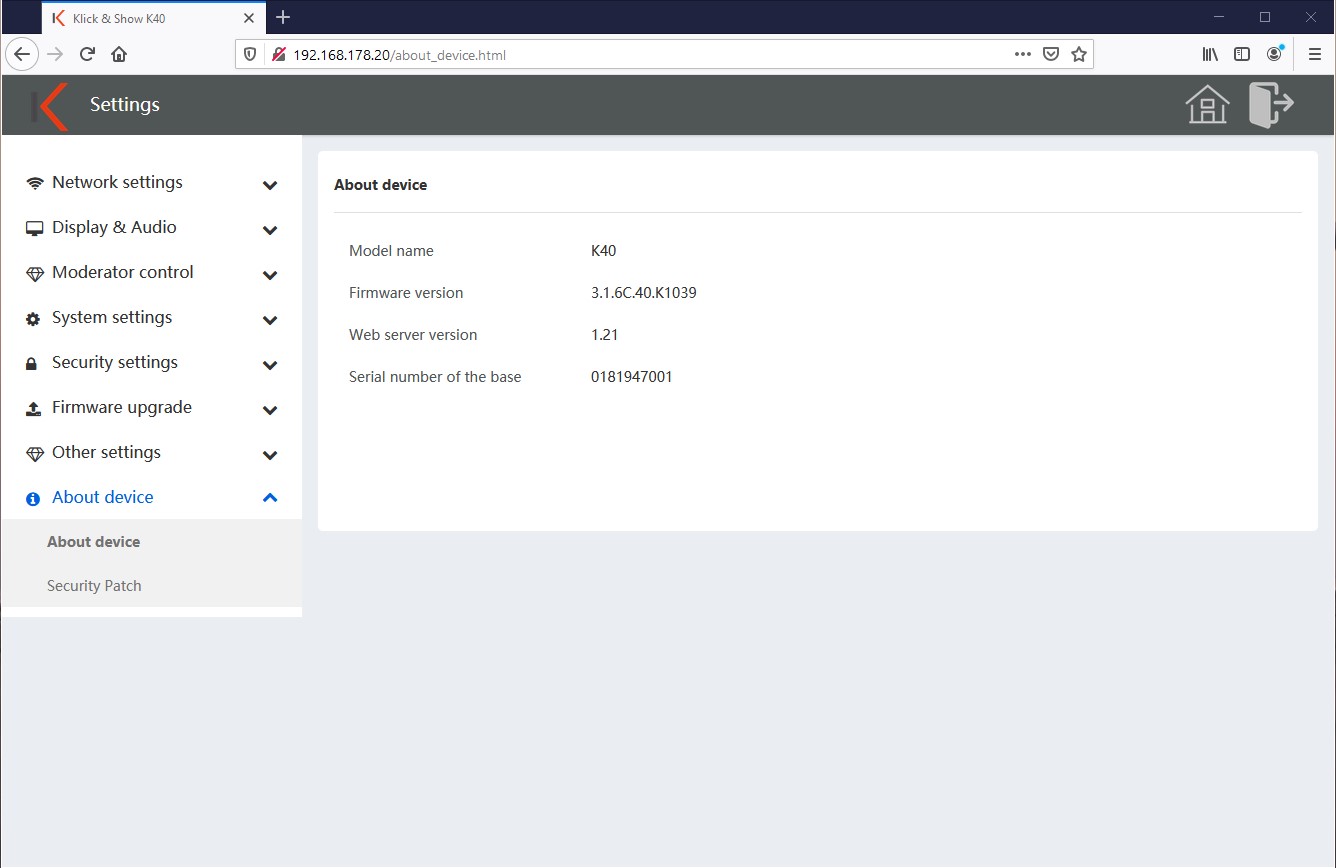
11.8.2 Security Patch
Here you will find information about the status of the Android security patches. These will be updated together with the firmware update if necessary.
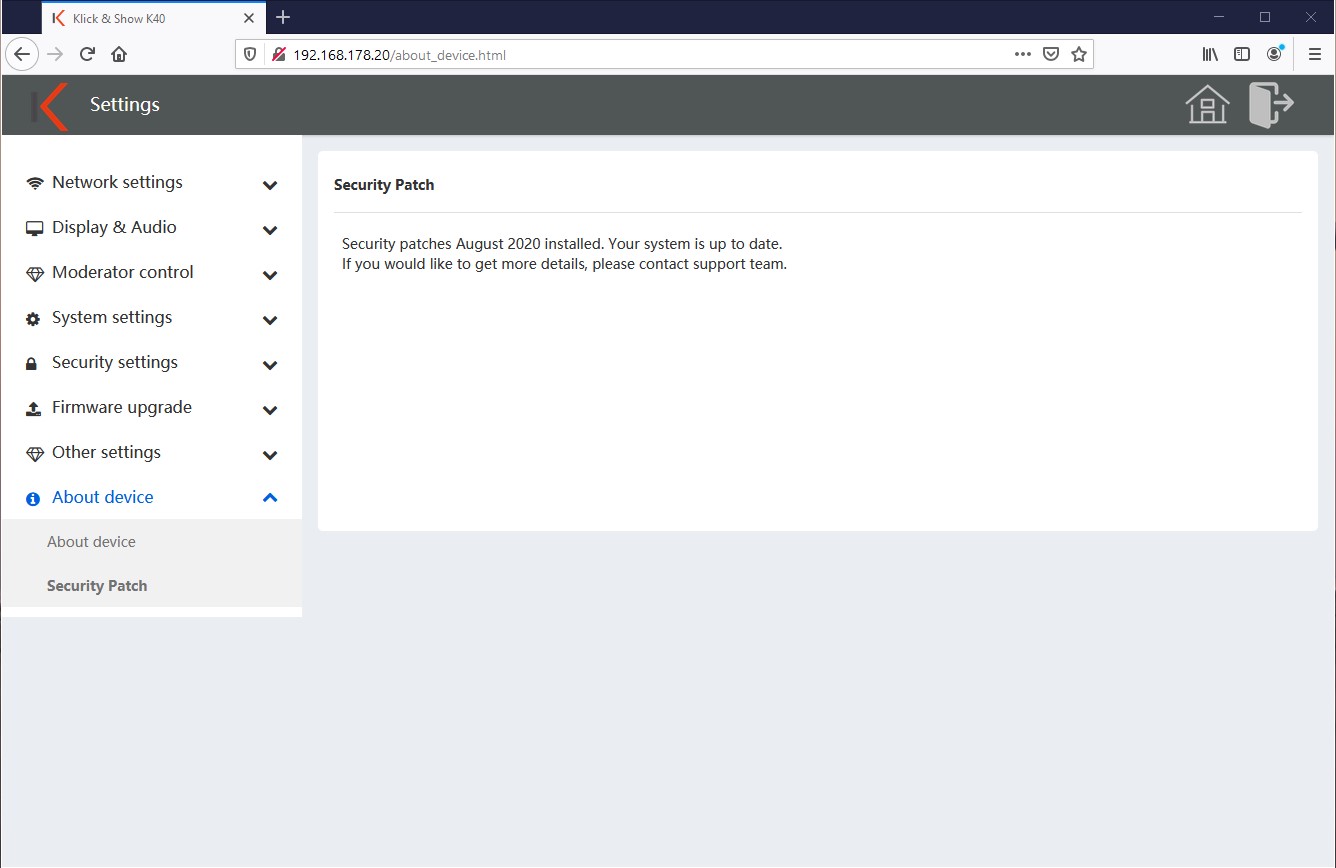
11.9 Screen Link
The exclusive Screen Link function allows 2 Klick & Show Base devices, so that the now duplicate HDMI outputs and processors form a more powerful base system with dual monitor output and extended functionality.
To use the Screen Link, the two base devices must be connected to exchange video/audio and control data via LAN port 1 via a (crossed) Ethernet cable and the desired settings must be made in the Screen Link menu after activating the Screen Link mode. One of the base devices is defined as "master" and the other base device as "slave". The slave base unit can no longer be used as an independent system in this operating mode. To set up a screen link function, any base devices from the series Klick & Show K-FX, K-40 or K-WM.
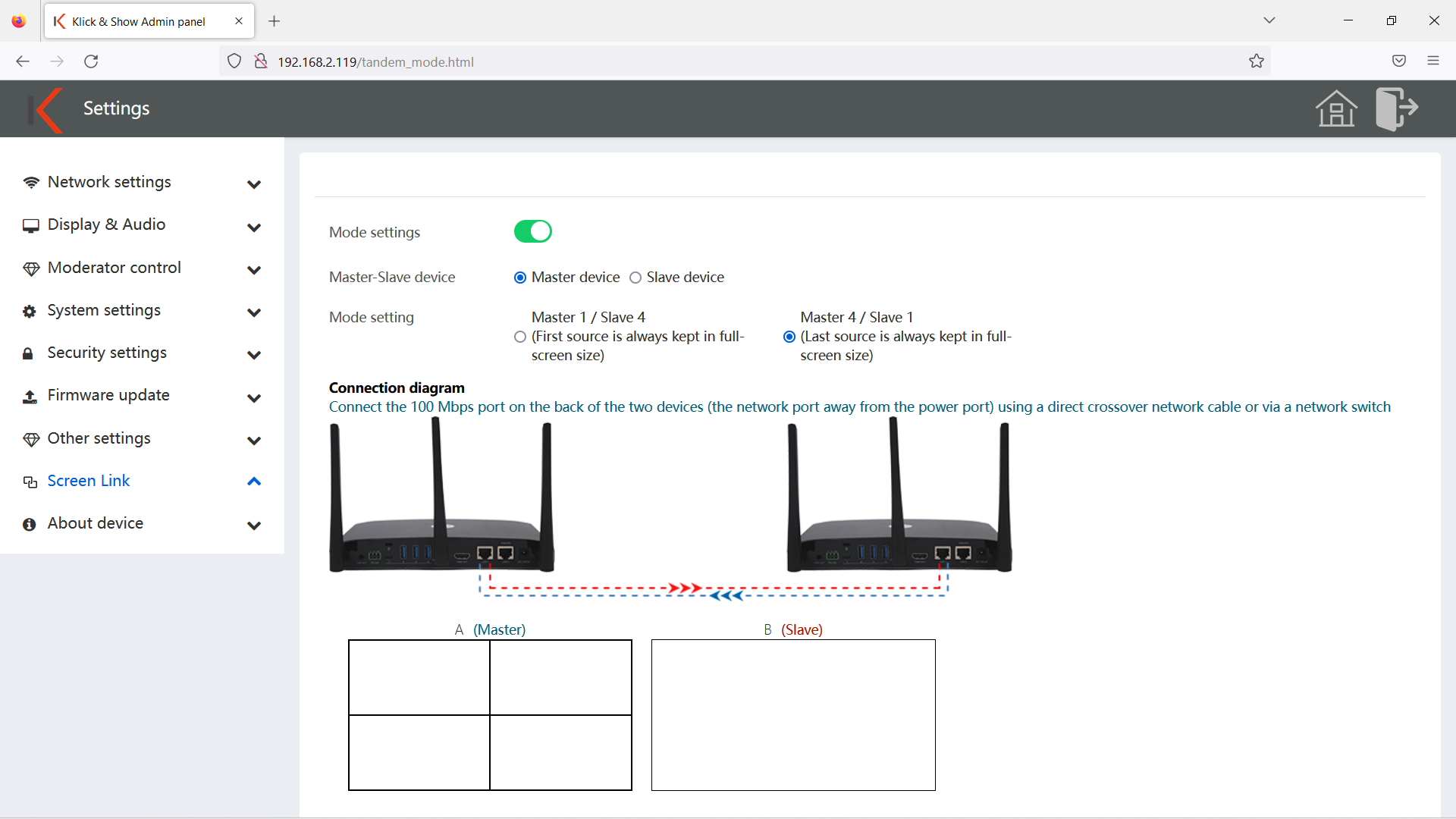
With the Screen Link function, a double monitor output for up to 5 participant content (4+1) takes place. The mode setting can be used to predefine whether either:
- The first source always remains in full screen display (Master 1 / Slave 4)
or - The last source always remains in full screen display (Master 4 / Slave 1)
The following table gives an overview of how the image outputs are carried out depending on the mode setting on master or slave monitor, with an increasing number of displayed participant content:
| Master-slave device: | Master | Slave |
|---|---|---|
| Mode setting: | ||
| Master 1 / Slave 4 | First Source always remains in full-screen display | 1 Source: same content on master and slave 2 sources: both content in full screen display 3-5 sources: Slave shows sources 2-5 as PiP |
| Master 4 / Slave 1 | 1 Source: same content on master and slave 2 sources: both content in full screen display 3-5 sources: Master shows sources2-5 as PiP | Last Source always remains in full-screen display |
To set up a screen link:
- Decide whether you want a particular source to have special meaning in your scenario (for example, a presenter's image content).
- In this case, set the base unit assigned to the preferred screen (left/right) as "Master" and select the mode setting "Master 1 / Slave 4", so that the first mirrored source always appears in full screen mode on the master display, while subsequent content is displayed on the slave display.
- In the other case, if the content in your scenario has more of the same relevance, then set the base device assigned to the screen (left/right) that is to show the last mirrored content in full screen size as your "slave" and select the mode setting "Master 4 / Slave 1".
Tip:
The Screen Link function is particularly advantageous for applications that benefit from the output of various image contents, for example:
- Presentations that often compare different content
- Web conferencing in companies, with visualization of remote participants and local content
- In education, if the content of a lecturer should always remain visible in full screen size and simultaneously changing content of students is displayed
12. Port shares for use in THE LAN/WLAN
The following ports must be used for the correct functioning of Klick & Show be shared on the network:
| From | To | Protocol | Direction | Usage | Description |
|---|---|---|---|---|---|
| PC:Port is assigned by windows/MAC WMT:Port is assigned by system | WMS, port is 20000 | TCP | Command | Transfer control command between WMT/PC software and WMS | |
| PC:Port is assigned by windows/MAC WMT:Port is assigned by system | WMS, port is 20002 | TCP | video | Transfer video from WMT/PC software to WMS | |
| PC:Port is assigned by windows/MAC WMT:Port is assigned by system | WMS, port is 20003 | TCP | audio | Transfer aideo from WMT/PC software to WMS | |
| PC:Port is assigned by windows/MAC WMT:Port is assigned by system | WMS, port is 20005 | UDP | Preview window Fast cursor Command | Transfer preview video from WMT/PC to WMS Transfer cursor from WMT/PC to WMB Transfer command between WMT/PC software and WMS | |
| PC:Port is assigned by windows/MAC WMT:Port is assigned by system | WMS, port is 20006 | TCP | Command | Transfer control command between WMT/PC software and WMS | |
| WMS, port is 20007 | |||||
| PC:Port is assigned by windows/MAC WMT:Port is assigned by system | WMS, port is 8887 | Multi cast | Discovery | Used by WMT/ PC software to send multicast message to network to search WMS. The group ip is "239.1.1.1" | |
| PC:Port is assigned by windows/MAC WMT:Port is assigned by system | WMS, port is 8889 | Broad cast | Discovery | Used by WMT/ PC software to send broadcast message to network to search WMS | |
| PC:Port is assigned by windows/MAC WMT:Port is assigned by system | WMS, port is 6667 | UDP | Discovery | After search, authentiacation message is transferred through this port | |
| ManageTool | WMS, port is 2006 | TCP | ManageTool | transfer cmd/data between wmb and ManageTool | |
| WMB:Port is 80/8080 | remote OTA server Web port is 8080/80 | HTTP | OTA | communication between WMS and remote OTA server. Such as query firmware info, download new firmware OTA server: http://www.fw-service.com | |
| Any telnet client | WMS, port is 23 | Telnet | Telnet Command | Send command from telnet client to WMB, response result to telnet client send info to telnet client | |
| Any client | WMS, port is 5656 | TCP | Telnet Command | the same as telnet | |
| Apple device | WMS, port is 5353 | Multi cast | Airplay | For apple device to search WMS | |
| From apple device | WMS, port is 51010 | TCP | Airplay | Apple device push URL to WMS | |
| From apple device | WMS, port is 51020 | TCP | Airplay | Airply protocol event port | |
| From apple device | WMS,port is 7100/7011/7012 | TCP | Airplay | ||
| From apple device | WMS, random port | UDP | Airplay | Airply protocol random assign an UDP port for connected apple device to transfer audio | |
| From apple device/Mobile app(ios/Android) | WMS, port is 51030 | TCP | Airplay /Mobile APP | Transfer video data, for screen mirror | |
| From Mobile app(ios/Android) | WMS, port is 51040 | TCP | Mobile app (ios/Android) | RTSP control protocal, transfer control command | |
| From Mobile app(ios/Android) | WMS, port is 52020 | TCP | Mobile app (ios/Android) | Remote control | |
| From Mobile app(ios/Android) | WMS, port is 52030 | TCP | Mobile app (ios/Android) | When sharing, sync status between Mobile app and WMS | |
| From Mobile app(ios/Android) | WMS, port is 8121 | TCP | Mobile app (ios/Android) | Mobile app transfer photo, audio, video to WMS | |
| From Mobile app(ios/Android) | WMS, port is 48689 | Multi cast | Mobile app (ios/Android) | For mobile app to search WMS | |
| browser | WMS, port is 8000 | HTTP | web page | download app/user manual from web page | |
| usb over wifi | 20008 | UDP | transfer audio/video data | ||
| usb over wifi | 20009 | TCP | transfer audio/video data | ||
| miracast | 15550/ 15560 | RTP | |||
| miracast | 15551/ 15561 | RTCP | |||
| chrome cast | 16660-16663 | UDP | transfer audio/video data | ||
| chrome cast | 8008 | TCP | transfer audio/video data | ||
| chrome cast | 8009 | UDP | mDns | ||
| chrome cast | 1900 | UDP multi cast | to discovery chrome device |
13. Telnet/RS232 commands
That Klick & Show can be controlled by the commands below via RS232 or Telnet.
The ports :23 and :5656 are used for control via Telnet.
![]() hint:
hint:
The possibility of control via Telnet depends on the set security level.
Command table:
|
Command Tag |
Command Parameters |
Command Response |
Effect |
Command Example |
|
help |
list all command |
help |
||
|
help |
Xxx |
show xxx command details |
help hdmi |
|
|
Home |
OK |
Home |
||
|
Home |
? |
#home on |
force go to home screen |
Home? |
|
wifi |
on |
OK |
turn on wifi hotspot |
|
|
wifi |
Off |
OK |
turn off wifi hotspot |
|
|
wifi |
Channel |
OK |
set wifi hotspot channel |
wifi channel 40 |
|
wifi |
ssid |
OK |
set wifi hotspot ssid |
wifi ssid room506 |
|
wifi |
pass |
OK |
set wifi hotspot password |
wifi ssid romt34 pass 12345678 |
|
wifi |
stratagem |
#wifi 08:d4:0c:d1:1e:92 192.168.43.180 |
list all clients which are connected to wifi hotspot |
wifi list |
|
wifi |
amount |
#wifi 2 |
return how many wifi device which are connected to wifi hotspot |
wifi amount |
|
wifi |
? |
#wifi ap-on 10 ty56rytt 234324rtyuu |
query wifi hotspot settings param |
wifi ? |
|
Mute |
on |
OK |
mute volume |
mute on |
|
Mute |
Off |
OK |
unmute volume |
mute off |
|
Mute |
? |
#mute on |
query mute status |
Mute? |
|
Standby |
set |
OK |
set auto standby timeout time, as menu general setting->auto standby |
Standby set off |
|
Standby |
Wakeup |
OK |
force system wake up from standby |
standby wakeup |
|
Standby |
? |
, |
PARAM1: Auto Standby Timeout Setting |
Standby? |
|
button |
listconnected |
#button 1513849033 c0a82b98,ec3dfd3a9c2c,V2.0.5C.A1009,1,1,0,1,en |
list connected button info |
|
|
button |
Lc |
#button 1513849033 c0a82b85,ec3dfd3a9c2c,V2.0.5C.A1009,1,1,0,1,LYCAN |
the same as listconnected |
|
|
button |
listdisconnected |
#button 1513849033 c0a82b85,ec3dfd3a9c2c,V2.0.5C.A1009,1,1,0,0,LYCAN |
list buttons which had ever connected to base unit. These info won't be saved to disk, so when the power of base unit is cut off, these info will be lost. |
|
|
button |
ldc |
#button 1513849033 c0a82b85,ec3dfd3a9c2c,V2.0.5C.A1009,1,1,0,0,LYCAN |
the same as listdisconnected |
|
|
button |
listsharing |
#button 1513849033 c0a82b85,ec3dfd3a9c2c,V2.0.5C.A1009,1,1,0,1,LYCAN |
list button info which is sharing his screen |
|
|
button |
Ls |
#button 1513849033 c0a82b85,ec3dfd3a9c2c,V2.0.5C.A1009,1,1,0,1,LYCAN |
the same as listsharing |
|
|
button |
listall |
#button 1513849033 c0a82b85,ec3dfd3a9c2c,V2.0.5C.A1009,1,1,0,1,LYCAN |
list all buttons connected/disconnected |
|
|
button |
La |
#button 1513849033 c0a82b98,ec3dfd3a9c2c,V2.0.5C.A1009,1,1,0,1,ter |
the same as listall |
|
|
button |
? |
#button 1513849033 c0a82b85,ec3dfd3a9c2c,V2.0.5C.A1009,1,1,0,1,LYCAN |
the same as listall |
|
|
button |
Share |
c0a82b85 |
request a button to start share, the param can be ip or name |
button share LYCN |
|
button |
stop |
c0a82b85 |
request a button to stop share, the param can be ip or name |
button stop LYCN |
|
statusable |
hide |
OK |
hide home screen statusable |
stateable hide |
|
statusable |
show |
OK |
show home screen statusable |
statusable show |
|
pass |
refresh |
OK |
refresh password |
pass refresh |
|
pass |
? |
#pass : 12345678 |
query password |
pass? |
|
Volume |
volume xxx |
volume 30 |
set audio volume level |
volume 30 |
|
Volume |
Volume? |
Volume? |
read audio volume level |
|
|
login |
login xxx |
Login 12345678 |
login to telnet system |
|
|
refresh |
refresh pass |
Refresh Pass |
refresh password |
|
|
Security |
security x |
security 2 |
set security level |
|
|
Security |
Security? |
Security? |
read security level |
|
|
pair |
pair ? |
Pair ? |
read paired dongle info |
|
|
pair |
pair remove xxx |
pair remove ec3dfd3a9cf0 |
remove paired dongle |
|
|
forceshare |
forceshare 3 |
forceshare 3 |
force share xxx, xxx can be ip, name, or 1,2,3,4 |
14. Technical data
| KLICK & SHOW Kits Specifications | K-40 base | K-42H KIT | K-42UC KIT | K-42U KIT |
| Article | 7488000315 | 7488000330 | 7488000312 | 7488000310 |
| Transmitter included | – | 2x HDMI | 2x USB-C | 2x USB-A |
| Compatible transmitters (not included) |
HDMI, USB-C, USB-A | USB-C, USB-A | HDMI, USB-A | HDMI, USB-C |
| Windows 10 | Software Client, Transmitter | |||
| MacOS | Software Client, AirPlay, Transmitter | |||
| Mobile devices | Android App / AirPlay / Miracast / Chromecast | |||
| Maximum resolution, wireless | 1080p | |||
| Simultaneous connections RJ45 | up to 30 | |||
| Simultaneous connections WLAN | up to 16 | |||
| Split screen | 1 / 2 / 3 / 4 | |||
| Mouse pointer with low latency | Yes, USB-A Transmitter and Windows Software Client | |||
| Touch-back /USB-HID support | Yes, e.B. for use in conjunction with interactive displays, whiteboards or projectors | |||
| WIFI frequency band | 2.4 / 5 GHz | |||
| WIFI Standard | IEEE 802.11b/g/n/ac | |||
| WIFI Antennas | 2×2 MIMO | |||
| WIFI bandwidth | up to 1200 Mbit/s | |||
| WIFI security standard | WPA PSK, WPA2 PSK | |||
| HDMI output | 1x HDMI 2.0 | |||
| Supported resolutions | 3840×2160, 1920×1080, 1280×720@60/30 Hz | |||
| HDCP Version | HDCP 1.4, HDCP 2.0 | |||
| HDMI input / max. resolution | Optional via HDMI transmitter (1080p60) | |||
| Audio input | Transmitter, Windows/Mac Software Client, AirPlay | |||
| Audio output (analog) | 1x 3.5 mm stereo jack | |||
| USB 2.0 (Type C) | 1x (front) | |||
| USB 2.0 (Type A) | 1x (front) | |||
| USB 3.0 (Type A) | 1x (back) | |||
| LAN (RJ45) | 1x 1000 MBit/s with PoE, 1x 100 MBit/s | |||
| PoE Standard | IEEE802.3af | |||
| RS232 input | 1x 3pol Euroblock (back) | |||
| Housing / Color | Aluminium, plastic / similar to Space Grey, black | |||
| Dimensions (W x D x H) | 165 x 95 x 25 mm (incl. antennas 165 x 215 x 25 mm) | |||
| weight | 0.2 kg | |||
| power supply | Plug-in power supply with replaceable plugs (Euro AV, UK), 12 V / 2 A | |||
| power consumption | 10 W max. | |||
15. Regulatory
15.1 Provision of open source software
This product also includes software components that have been released under an open source license. A list of third-party open source components used can be found here.
15.2 EC declaration
The full text of the EU declaration of conformity is available at the following internet address:
https://shop.kindermann.de/erp/webshop/navigationPath/7488000310.html
Hereby, the Kindermann GmbH, which is the radio equipment type Klick & Show complies with Directive 2014/53/EU.
Klick & Show is only allowed for indoor use when operating in the 5 GHz band.
2.4 GHz band: channels 1, 2, 3, 4, 5, 6, 7, 8, 9, 10, 11;
5 GHz band: Channels: 36, 40, 44, 48;
Bandwidth: 20MHz
Transmission power: max. 20 dBm (100mW), dynamically controlled
15.3 Diagnostic data
While using Klick & Show diagnostic information is sent to Kindermann transmitted. Kindermann uses the diagnostic data to: Klick & Show keep secure and up-to-date, troubleshoot issues, and make product improvements.
The diagnostic data collected is limited to a minimum of necessary data and includes information about your device, its settings and functions, and its proper functioning. No personal data is collected.
16. Troubleshooting
Here are some basic problems and possible causes that occurred during the use of Klick & Show can occur. Use the provided solution hints.
If you are unable to resolve the issue, contact your reseller or IT administrator.
| problem | cause | solution |
|---|---|---|
| When plugging the USB-A transmitter into the computer, the LED flashes permanently green, the software "WirelessMedia" does not start and no connection is established. | The WirelessMedia Client for Windows or MacOS has not yet been run on the computer, or no longer exists. | Chapter 6.4 describes how to load the software. |
| You have decided to use WirelessMedia-Pro for Windows. | This program must be started manually before each use. | |
| Due to administrative restrictions on your computer, entries cannot be made in the Startup menu. | Please contact your administrator to remove these restrictions. Alternatively, you can run the "WirelessMedia-Pro for Windows" client without installation. However, the program must be used before any use of Klick & Show can be started manually. | |
| Windows: The execution of .exe files is blocked by the administrator. An active antivirus program may block the WirelessMedia app. | Please contact your administrator to remove these restrictions or use an HDMI or USB-C transmitter. These behave like an external monitor and therefore do not require any software on the computer. We regularly check the WirelessMedia clients for viruses. Configure the filters of your anit virus program accordingly so that they are allowed to run. With centrally managed virus protection, you need the assistance of the administrator. | |
| The use of USB ports is blocked due to a company policy. | Please contact your administrator to remove these restrictions or use an HDMI or USB-C transmitter. These behave like an external monitor and therefore do not require any software on the computer. | |
| The transmitter is defective. | Test another transmitter to confirm the conjecture. Please contact support. | |
| When plugging the USB-A transmitter into the computer, the "WirelessMedia Client" starts, but the message appears: "Connection failed". | The network settings of the Click & Show have been changed. The transmitter does not yet know the new parameters. | Pair the transmitter again , see chapter 8.1. |
| The USB port did not recognize the transmitter correctly. | Reconnect the transmitter or use a different USB port on the computer. It may help to restart your computer. | |
| Error message: "The version of the WirelessMedia Client does not match the firmware of the Click & Shows. | A newer version of the WirelessMedia Client is available or the firmware ddes Klick & Show has not been updated yet. | You can ignore this message. The basic function is still given, but newer features may not be usable. Download the new software and run it or ask the administrator to update the firmware. |
| The WirelessMedia app for Android will not work. | Check if your Android device is on the same Wi-Fi network as the Klick & Show is located. | Select the right Wi-Fi network and refresh the list of devices and select the desired Klick & Show from. |
| The Wi-Fi connection between the transmitter or computer and theKlick & Show is not stable and breaks off again and again. | The WLAN connection is disturbed, e.B by other devices that use the same channel. | Use a WLAN scanner app (e.B. Wifi Analyser) to find a suitable WLAN channel and change the WLAN configuration of Klick & Show manual. Repeat the process regularly if Wi-Fi networks in the area are frequently changed. |
| The signal strength is too low. Walls made of plasterboard or reinforced concrete can dampen the signal and cause reflections that interfere with the WLAN signal. | Reduce the distance between the computer and the access point or place Klick & Show or the access point in a more suitable position in the room. Change the antenna orientation. If possible, remove obstacles in the line of sight between the two devices. Avoid it Klick & Show in (metal) cabinets, suspended ceilings, under tables or in neighboring rooms. | |
| Poor video quality (image sharpness, image and sound dropouts, video stream jerking,....) when using the WirelessMedia Client | The video quality also depends on the computing power and processor utilization by other, running software applications. A laptop can be configured on reduced computing power in battery mode. | Reduce CPU usage by other applications.Reduce playback resolution on the computer. Exit the power saving mode. Use an HDMI or USB-C transmitter, these work regardless of the performance of the computer. |
| Poor Wi-Fi connection | see above | |
| A video does not appear on the main screen. | The content is HDCP protected. | Klick & Show does not support HDCP encoded source signals. |
| The transmission stops and the transmitter's LED flashes. | The WLAN connection was interrupted. | Klick & Show tries to reconnect automatically. If this does not work, the transmitter's LED will flash green. Unplg and reconnect the transmitter. If the connection cannot be re-established, check the WLAN environment. |
| Nothing is displayed on the main screen or the image quality of the home screen is poor. | The display is turned off or an incorrect input has been selected. | Turn it on or select the correct input. |
| The HDMI cable is not plugged in correctly, damaged or the quality of the cable is too poor. | Establish a working connection between the HDMI output and the display. | |
| The display detects the resolution of the Klick & Show cannot, or cannot represent them. | Change the resolution in the "Display & Audio"menu. It is best to set them to auto or manually to the native resolution of the display, which you can see in the data sheet. | |
| That Klick & Show in stand-by (ring LED on the top of the Klick & Show Base flashes green slowly) or the power supply is missing. | Connect the power supply. Press the Power button on Klick & Show or connect to the Klick & Show, this automatically terminates the stand-by. | |
| The touch function of the display does not work in conjunction with the Klick & Show. | The touch function requires a separate USB cable between the display and Klick & Show. | Connect the touch display via USB cable to the Klick & Show. |
| No LAN connection to the base. | The network cable is not plugged in. Klick & Show has not received an IP address. | Plug in the network cable and contact your network administrator to verify the correct network integration. |
| You don't hear any sound on the display. | There are no speakers or the volume control has been adjusted to zero. | Connect speakers or increase the volume. |
| The volume level in the Klick & Show was limited. | Customize the audio output in the menu of Klick & Show at. | |
| The volume level is set too low in the options of the "WirelessMedia Client". | Adjust the volume in the "WirelessMedia" starter program. | |
| The audio output on the computer has been disabled. (Mute) | Enable audio output. | |
| The sound is output on the computer and not by the Klick & Show to the display. | On your computer, the wrong audio output device is selected. | Select the right audio output device (WirelesMedia) n the Audi settings of your computer. |
| You don't hear any video sound with the MacBook. | The "Soundflower" app integrated in the WirelessMedia Client is not installed. | You need the "Admin Password" for MacOS: open system settings\Security Run/install the soundflower "Matt Ingels"=>"allow" WirelessMedia.app driver again. |
| When plugging the USB-A transmitter into a MacBook, you will be prompted for password entry. | The "Soundflower" app in the WirelessMedia Client requires a local installation. | You need the "Admin Password" for MacOS: open system settings\Security Run/install the soundflower "Matt Ingels"=>"allow" WirelessMedia.app driver again. |
| You cannot use the firmware via USB flash drive on the Klick & Show update. | The USB flash drive is formatted with the NTFS file system. | Use a USB data server with FAT32 formatting for the update. |
| AirPlay not working | The use of AirPlay has been introduced in the security settings of Klick & Show deactivated. Klick & Show operates in infrastructure mode. Network ports must be shared to use AirPlay. | Contact the administrator to activate the feature or to make the necessary network configurations. |
| The image quality when playing video via AirPlay is poor. | There are 2 states for AirPlay: Mirroring: 1:1 Copy of the screen Streaming: Videos (Internet, youtube; the image is not displayed on the iOS device. => image is jerking | Lower "quality" in the video, e.B from "automatic" to 720p. |
| "WirelessMedia2" for Android does not transmit sound. | Android does not allow apps to access the audio signal. | Most Android devices support Miracast,which also allows the transfer of audio. |
| Integration into a company network | ||
| Mobile devices do not find the base device. | Network ports must be approved for data transmission. | |
| Klick & Show and mobile devices are not on the same subnet. | Contact the administrator to make the necessary network configurations. | |
| Poor transmission quality | Poor Wi-Fi connection | Contact the Administrato to improve the WLAN supply or to optimize the network configuration. |
| The available bandwidth is occupied by other network participants. Klick & Show requires a data rate of about 4 Mbps per active stream. |
Subject to change, Status: 2021/08 – FW K1048

